Gazing up at the snow-capped mountains, dining and strolling in the ancient town, hiking in Yubeng, and listening to the echoes of Shangri-La—the long-awaited trip to Lijiang and Shangri-La finally took place in June of this year. It was a wonderful trip and a lasting memory.
This was my third trip to Yunnan and my second to Lijiang, with Shangri-La being the main destination and a long-awaited destination of this trip.
On June 2, 2021, our group of six gathered in Lijiang from our residence and returned to our residence from Lijiang on June 14. From June 3 to 13, our itinerary was Lijiang-Shangri-La-Lijiang, with a chartered car throughout the trip. Accommodation was booked in advance by China-TravelNote, and meals were managed by our six-person "housekeeper."
Highlights:
1. Enjoy the breathtaking scenery of Shangri-La, including snow-capped mountains, lakes, canyons, plateau meadows, primeval forests, natural geological wonders, Tibetan villages, Naxi villages, and more. It's truly breathtaking and unforgettable.
2. Accommodation was carefully selected on China-TravelNote in advance, with B&Bs and hotels located within or near the scenic area. Enjoy the breathtaking scenery and fully appreciate the breathtaking views in the morning and evening.
&n bsp; &nbs p; ;
Specific itinerary:
Day1 Jade Dragon Snow Mountain, Blue Moon Valley→Day2 Lashi Lake, Tiger Leaping Gorge, Zhongxiaodian Flower Sea→Day3 Songzanlin Temple, Dukezong Ancient Town→Day4 Napahai Yila Grassland→Day5 Balagzong, Moon Bay of Jinsha River→Day6 Meili Snow Mountain, Yubeng Upper Village→Day7 Yubeng Lower Village Divine Waterfall Hike→Day8 Yubeng Lower Village→Day9 Pudacuo→Day10 Baishuitai→Day11 Dayan Ancient Town

—————— First, let’s take a look at the beautiful scenery:
 Jade Dragon Snow Mountain. Blue Moon Valley
Jade Dragon Snow Mountain. Blue Moon Valley Tiger Leaping Gorge
Tiger Leaping Gorge Xiaozhongdian
Xiaozhongdian Songzanlin Temple
Songzanlin Temple Shangri-La
Shangri-La Balagzong
Balagzong Bala Village
Bala Village Yubeng
Yubeng Yubeng Lower Village
Yubeng Lower Village Shenpu Waterfall Hiking
Shenpu Waterfall Hiking Pudacuo National Forest Park
Pudacuo National Forest Park Baishuitai
Baishuitai —————— Food is an indispensable part of travel. Our travels are always accompanied by delicious food:
—————— Food is an indispensable part of travel. Our travels are always accompanied by delicious food: 

If you keep thinking about it, there will be a response!
The long-awaited Lijiang Shangri-La 11 free trip has begun~~~
Day1. Lijiang Shangri-La free trip part 1: [Jade Dragon Snow Mountain and Blue Moon Valley]
The day before the trip, our group of six flew to Lijiang from different places of residence and checked into the Yuhu Village B&B booked in advance on China-TravelNote's official website. Yuhu Village is about 30 kilometers away from Lijiang and is the closest ancient village to Jade Dragon Snow Mountain. It was late at night when we checked in that day, so I will talk about Yuhu Village later.
On the first day of the trip, we arranged to visit the Jade Dragon Snow Mountain Scenic Area. Yuhu Village is about a 20-minute drive from the Jade Dragon Snow Mountain Scenic Area. Our chartered car driver picked us up on time at 8 o'clock in the morning and set off from Yuhu Village. The weather on the first day was fine, with blue sky, white clouds and snow-capped mountains along the way. On the yellowed grass, the early-rising horses were leisurely grazing.
This scene made us unable to resist the temptation. The chartered driver found a convenient place to park the car, and we got off and wandered around for a while.

We set out for our destination again. This is a checkpoint before entering the Yulong Snow Mountain Scenic Area. All vehicles stop for inspection. Two groups of people in charge of the inspection questioned the driver and us separately. The main purpose should be to regulate the tourism market.

After passing this checkpoint, it takes about a few minutes' drive to reach the scenic area parking lot. After purchasing the scenic area tickets, we walked to the tourist bus center.


Most tourists who come to the Yulong Snow Mountain Scenic Area go to the snow mountain to see the snowy scenery. Since three of our group of six had already been to the snow mountain, we split into two groups after entering the scenic area. One group took the cable car to the snow mountain, and the other group took a shuttle bus to Blue Moon Valley.
A few years ago, when I visited Yulong Snow Mountain, I also visited Blue Moon Valley. Because it takes quite a while to get up to the snow mountain (queuing, getting on and off the cable car, and staying on the snow mountain), I only had a quick visit there, but it left a very amazing impression. This time, I was prepared to spend most of the day in Blue Moon Valley and enjoy it thoroughly. We took the park shuttle bus and got off at the second stop, Blue Moon Valley.

After getting off the park shuttle bus, there are two ways to explore the area: one is hiking, and the other is taking a sightseeing bus. Since we had plenty of time and didn't want to miss any of the beautiful scenery, we definitely chose hiking.
Blue Moon Valley is located at the foot of Jade Dragon Snow Mountain. It was formed by the "White Water River" formed by the snow from Jade Dragon Snow Mountain. From top to bottom, Blue Moon Valley features four terraced lakes: Yuye Lake, Jingtan Lake, Blue Moon Lake, and Tingtao Lake. There is also an artificial waterfall and a water platform. Our plan was to walk up from the Blue Moon Valley drop-off point and then back down. This basically circled the lake in about 1.5 hours. We walked, looked around, and rested, leisurely spending more than three hours.
This is the busiest place after getting off the Blue Moon Valley shuttle bus. Blue Moon Valley is backed by Jade Dragon Snow Mountain. Looking towards the snow-capped mountains from every side of the lake is so intoxicating: the majestic snow-capped mountains, the azure or emerald green lake water, and the beautiful canyons surrounding the lakes, combine to form a series of stunning scenery, and every angle is a masterpiece.


Blue Moon Valley is a great place for taking photos. Of course, it is also a popular spot for wedding photos. You can meet couples taking wedding photos along the way.

The waters in different lakes of Blue Moon Valley present different colors. Here the water is as clear as emerald jade, while there it may be as azure as a gem.



This winding plank road has a beautiful composition and is also a hot spot for wedding photography.

The lake where the plank road starts is as clear as a turquoise, and the roots and branches of the trees under the water are clearly visible.

Wedding photography is everywhere, and the bridge across the plank road is also a check-in spot.

After crossing the bridge, there is this water platform, which should be man-made. The real Baishuitai is located in Sanba Township, southeast of Shangri-La City. It is also our last stop in Shangri-La. Crossing the water platform and moving forward, the sound of "Pure Land" playing on a loop came from the beach. A pair of quietly lying yaks seemed to be listening attentively:
Legend has it that there is a snowy mountain with white clouds floating on the top. A dream comes over and over again, just wanting you to understand silently.
Legend has it that there is a pure land, living on the other side of the sun. A heart no longer drifts, just wanting to return to the little house in the dream.
The legendary pure land, our only way out, the once vague happiness, is becoming clearer and clearer.



Returning back, we walked a repetitive route, still walking, stopping, and sighing, the beauty of each step was fascinating.
Walking along the stone plank road across the lake below the artificial waterfall to the opposite side and around the lake, we can enjoy another wonderful perspective.

Back to Blue Moon Lake, the three companions who went up the snow mountain had also arrived at Blue Moon Valley.

This is the scenery of the snow-capped mountains that they brought us that day.

At around 3:30 in the afternoon, we still took the bus back from Blue Moon Valley Station.

Yulong Snow Mountain Scenic Area Guide:
1. Yulong Snow Mountain + Blue Moon Valley
1. Ticket purchase: You need to buy a cable car ticket to go to Yulong Snow Mountain, and it is generally required to book in advance on the official website. Although our chartered car driver told us that we could buy tickets on the spot during off-peak season, for safety's sake, our three climbers still bought tickets for the cable car in advance on the official WeChat account (Glacier Park Cable Car, 140 yuan, including tickets and transportation within the park). China-TravelNote has a Glacier Park package (188 yuan, including tickets + Glacier Park Cable Car + transportation within the park + lunch).
2. Entering the scenic area and taking the cable car: Because the cable car tickets for Jade Dragon Snow Mountain are booked and boarded according to the time (for example, the booking time is 8:30 am, the cable car boarding time is between 8:00 and 9:00 am, and if you book at the time, the ticket will be refunded), you need to calculate the time to enter the scenic area (it is better to leave half an hour from the scenic area to the cable car), and the queues for the cable car may be longer during peak season.
3. About altitude sickness: The foot of Jade Dragon Snow Mountain is about 3100-3200 meters above sea level. The cable car reaches the Snow Mountain Customer Center at about 4500 meters. Go up along the plank road to the sign check-in point at 3680 meters, and the highest point can reach 3800 meters. Because the cable car is a sudden increase from more than 3,000 meters above sea level to 4500 meters above sea level, altitude sickness is more likely to occur. It is recommended to take Rhodiola rosea in advance, carry a bottle of oxygen, glucose oral solution or chocolate, and hot water to be prepared.
4. About clothing: The temperature on Jade Dragon Snow Mountain is low all year round, so a down jacket is essential. If it is winter, it is best to rent a thick down jacket on site.
5. About meals: You can eat at the customer service center on the mountain, or you can bring your own. If it is early, you can go down the mountain to eat.
6. Transportation: We chartered a car directly to the scenic area parking lot, and then transferred to the scenic area shuttle bus. If you don't charter a car, you can take a bus from Lijiang to the scenic area.
7. About one-day tours: China-TravelNote offers packaged one-day tours, including round-trip transportation from Lijiang, oxygen, cable car tickets, transportation within the park, down jackets, and Chinese meals. You can go to the snow mountain and Blue Moon Valley. This is more convenient and saves trouble, but you need to communicate well with the driver to avoid affecting your freedom. When I visited Jade Dragon Snow Mountain in 2017, I took a one-day tour.
2. Blue Moon Valley: Whether you go to Jade Dragon Snow Mountain or not, Blue Moon Valley is not to be missed and is worth a visit because it is so beautiful.
1. Tickets: To go directly to Blue Moon Valley, you need to purchase the Jade Dragon Snow Mountain Scenic Area unified ticket (100 yuan), which can be purchased on-site at the scenic area ticket office.
2. Transportation within the park: The park shuttle bus (i.e., the park shuttle bus, 20 yuan), the second stop is Blue Moon Valley, including round trip. The Blue Moon Valley sightseeing bus (i.e., the battery car, 50 yuan) is also available. If you are not particularly pressed for time, it is better to walk, otherwise you may miss the beautiful scenery. The journey is not long and the road is easy to walk. 3. About Altitude: Blue Moon Valley is about 3100 meters above sea level, which is a little higher than Lijiang (2418 meters). As altitude sickness is more likely to occur at altitudes above 3,000 meters, it is recommended to take Rhodiola rosea in advance (because our trip was long and the Shangri-La area was also at a high altitude, so we took Rhodiola rosea 10 days in advance and during the trip). 4. About Clothing: If you don't go up the snow mountain, the temperature in Blue Moon Valley is slightly lower than that in Lijiang, and it is higher at noon. In addition to considering the temperature, girls' clothing must also take into account taking photos because the background is so beautiful.
5. About meals: There are simple meals at the Blue Moon Valley station of the park's shuttle bus, or you can bring your own dry food.
Day1. Lijiang Shangri-La free travel two: [Jade Pillars Supporting the Sky. Yuhu Village]
Yuhu Village is a super beautiful ancient village of the Naxi people. We stayed in Yuhu Village on both the first and second days. It's the closest village to Jade Dragon Snow Mountain. It wasn't until after 4 p.m. when we returned from the mountain, so we decided to stroll around the village and the Jade Pillars to the Sky scenic area. Yuhu Village itself doesn't require an entrance fee, but Jade Pillars to the Sky is a paid attraction. Located southwest of the village at the foot of Jade Dragon Snow Mountain, it's just a few minutes' walk from our B&B. The entrance fee is 25 yuan, and there's a decent-sized parking lot in front. Due to time constraints, we only explored Yuhu Lake and the Upper and Lower Deep Pools. The scenery around the lake is breathtaking. The small wildflowers by the lake are vibrant and vibrant, plump sheep graze leisurely, and the cascading deep pools are filled with rainbow trout, brimming with life.





 After leaving Yuzhu Qingtian, we walked to Yuhu Village. Our guesthouse was located closest to the village entrance, about a seven or eight-minute walk from the center. Yuhu Village, also known as Xuesong Village, doesn't require an entrance fee. It belongs to Lijiang's Baisha Town and is 18 kilometers from Lijiang Old Town. Free from the bustle and bustle of Lijiang Old Town, it's tranquil and beautiful, yet brimming with the charm of ancient Naxi culture. Strolling through the village, admiring the ancient stone houses and the cattle and sheep roaming freely, while savoring the local chicken hotpot and other local dishes, was truly a relaxing experience.
After leaving Yuzhu Qingtian, we walked to Yuhu Village. Our guesthouse was located closest to the village entrance, about a seven or eight-minute walk from the center. Yuhu Village, also known as Xuesong Village, doesn't require an entrance fee. It belongs to Lijiang's Baisha Town and is 18 kilometers from Lijiang Old Town. Free from the bustle and bustle of Lijiang Old Town, it's tranquil and beautiful, yet brimming with the charm of ancient Naxi culture. Strolling through the village, admiring the ancient stone houses and the cattle and sheep roaming freely, while savoring the local chicken hotpot and other local dishes, was truly a relaxing experience. 


This is the Yuhu Village B&B where we stayed. The inn is right at the entrance of the village. We stayed on the second floor with a great view. We didn’t have to go downstairs or leave the inn to watch the sunrise in the morning.

There is also a glass room on the second floor of the inn, from which you can see the snow-capped mountains.

On the second day of the trip, we set out from Yuhu Village to Shangri-La, and we will stop by Lashi Lake, Tiger Leaping Gorge, and Zhongxiaodian Flower Sea on the way. Day 2. Lijiang Shangri-La Self-Guided Trip 3: Lashi Lake Lashi Lake Wetland Park is located in the middle of Lashiba Dam, 10 kilometers west of Lijiang County. It is the first nature reserve named "wetland" in Yunnan Province. Since it's conveniently located on the way to Shangri-La from Lijiang, we decided to visit it. The park is quite large. The staff said the train only runs after 10:00 PM, but we had limited time, so we could only walk along the nearest plank road and around the perimeter. Admission is 30 yuan.

Walking along the boardwalk on the lake, you can see dense reeds separating the blue lake.


The Naxi Shambhala Museum is located in the middle of the plank road. Due to time constraints, I did not go in to visit it. The end of the plank road connects with the road around the lake. From the viewing platform at the intersection, you can see the vast surface of the Lashihai Lake. There is also a plank road by the lake for hiking, but we gave up due to time constraints.

On the other side of the scenic spot is a handicraft workshop. After entering, we found that the handicraft workshop is actually a passage leading to another tourist area. At the entrance of this tourist area, there is a sky mirror that does not require payment (it may be that there are few people in the morning and the collector has not arrived yet). Although time is tight, we still couldn't help but take a lot of photos.

The scenic area is too large, so in order to continue the next itinerary, we did not continue to explore it. Day 2. Lijiang to Shangri-La Self-Guided Tour Part 4: Tiger Leaping Gorge (Shangri-La Section), 45 RMB.
The journey from Lashihai Wetland Park to Tiger Leaping Gorge takes about an hour and a half, making it a convenient stop. It's only at the end of the trip that we turn off National Highway 214 and join the East Loop. The East Loop also served as our route back to Lijiang from Baishuitai. We'll discuss this complex route in detail later when we visit Baishuitai.
Tiger Leaping Gorge is one of the deepest canyons in China. It is divided into the Shangri-La section and the Lijiang section. The Shangri-La Tiger Leaping Gorge is a national AAAA-level tourist scenic spot, including the upper, middle and lower Tiger Leaping Gorges. We arrived at the Shangri-La section. Cars usually stop at the Tiger Leaping Gorge Scenic Area (Upper Section) parking lot. To reach the middle and lower sections, you can hike.

Tiger Leaping Gorge is formed by the Jinsha River encountering the Yulong and Haba Snow Mountains.
From the highest viewing platform in the Tiger Leaping Gorge scenic area, you can clearly see the momentum of the rushing river, but the sense of shock is not enough. You have to walk down the plank road to the viewing platform at the bottom of the river to feel the surging power of Tiger Leaping Gorge.

The iconic tiger sculpture at the viewing platform at the bottom of Tiger Leaping Gorge in Shangri-La is also a popular check-in spot for tourists.


 The Tiger Leaping Gorge tour doesn't take long, about half an hour, and including the time to go up and down, it takes more than an hour. It's easy to go down to the riverbed by the plank road, but it's still a bit tiring to hike up. Although the altitude here is less than 2,000 meters, the slope is quite steep, so we chose to take the escalator back to the ground, but the ticket price is a bit expensive (30 yuan one-way for the ascent).
The Tiger Leaping Gorge tour doesn't take long, about half an hour, and including the time to go up and down, it takes more than an hour. It's easy to go down to the riverbed by the plank road, but it's still a bit tiring to hike up. Although the altitude here is less than 2,000 meters, the slope is quite steep, so we chose to take the escalator back to the ground, but the ticket price is a bit expensive (30 yuan one-way for the ascent). 
It was time for lunch. On the way from Tiger Leaping Gorge to Shangri-La, we found a small roadside restaurant and chose a fish hotpot that did not require waiting, with a plate of bait blocks and rice.


Day 2. Lijiang Shangri-La Self-guided Tour Part 5: Xiaozhongdian Flower Sea
After lunch, we continued along National Highway 214 towards Xiaozhongdian Flower Sea in the direction of Shangri-La. Xiaozhongdian Flower Sea is also a must-go place when going from Lijiang to Shangri-La. It is located in Xiaozhongdian Village, Jiantang Town, south of Shangri-La County. The flower sea is right next to National Highway G214 and is open to the public without any entrance fee.
The alpine rhododendrons here are in full bloom from late May to mid-June, and we arrived on June 4th when they were in full bloom. Unlike the more common azaleas we see inland, the alpine azaleas here are smaller and appear to have less water. However, up close, the blossoms are still full and vibrant, and one can't help but marvel at the powerful vitality of these small flowers on the plateau.
The vast expanse of azalea blossoms is separated by what appear to be pine trees, which appear exceptionally lush green against the backdrop of the flowers. In the distance, the indigo mountains, blue sky, and white clouds create a beautiful scene. It's said that in September and October, this area becomes a sea of vibrant red wolfsbane, making it a popular destination for wedding and travel photography.




Leaving Xiaozhongdian Flower Sea along National Highway 214, we soon arrived at Shangri-La's Yingbin Avenue. From afar, we could see the tall white pagoda standing under the blue sky. Shangri-La, here we come.

Day 2. Lijiang Shangri-La Free Tour No. 6: [Shangri-La Dukezong Ancient Town]
We arrived at Shangri-La County at around 4 pm. It seemed still early, so we parked in front of Moonlight Square and decided to go to Guishan Park first. There, there was the world's largest prayer wheel that attracted us.
Guishan Park is located on Guishan Mountain, close to the east of Moonlight Square. You need to climb up a flight of stairs first, and then walk around the Big Buddha Temple and Han Temple in the park. It is also a good place for travel photography.


 The prayer wheel, located next to the Han Temple, is a must-see for tourists. This world's largest prayer wheel, about five stories high, is said to be made of pure copper plated with gold. It requires at least ten people to spin it, so groups of tourists joined in, eventually spinning it. After completing three full rotations, satisfied visitors were replaced by the next group.
The prayer wheel, located next to the Han Temple, is a must-see for tourists. This world's largest prayer wheel, about five stories high, is said to be made of pure copper plated with gold. It requires at least ten people to spin it, so groups of tourists joined in, eventually spinning it. After completing three full rotations, satisfied visitors were replaced by the next group. 
Guishan Park is the commanding height of Shangri-La City, and the viewing platform where the prayer wheel is located is the best place to view the whole picture of Shangri-La. After coming down from Guishan Park, we began to visit Dukezong Ancient Town. As June is not the peak tourist season, there were not many people in the ancient town in the evening. Only the Sifang Street Square was full of tourists dancing the cheerful Guozhuang dance under the guidance of enthusiastic Tibetans. We felt that this ancient town, which had suffered a fire in 2014, has now regained its former appearance and vitality.

Dinner was served at a small restaurant nearby in the ancient city, including butter tea, highland barley cakes and some snacks.

As night falls, the sky in the distance shows a charming night blue, and there are more and more tourists in the central business district of the ancient city.


However, there are still few tourists in the remote areas of the ancient city.

We played until the night was dark, then we left the ancient city and checked into the B&B booked in advance.

The homestay that day is located in the Songzanlin Temple Scenic Area. From the ancient city to the homestay, it is basically like traveling through the entire Shangri-La County.
Entering Songzanlin Temple Scenic Area requires tickets and transportation tickets. However, if you live in the scenic area, you can drive your car directly in. There is no need to purchase tickets and scenic area transportation. However, if you need to enter the Songzanlin Temple to visit the interior, you still need to purchase tickets.
Day3. Lijiang Shangri-La Free Tour Part 7: [Songzanlin Temple]
Called Rich, it is no exaggeration to say that it is the best breakfast among the B&Bs I have visited in recent years. The butter tea tastes very authentic, the highland barley cakes and buckwheat cakes are fragrant and delicious, and the small cheese has a moderate sweetness and sour taste... Just thinking about his breakfast makes me always think about when to go to Shangri-La again and stay at his home again.



After enjoying a delicious breakfast, our group came to Duke Zongcheng again and spent about two or three hours taking travel photos. What impressed me most was this place, which is a good place that reflects the luxurious style of Tibetan people.



The afternoon is our highlight of the day: visiting Songzanlin Monastery.
Gaden Songzanlin Monastery is located on the outskirts of Shangri-La County. It is the largest Tibetan Buddhist temple in Yunnan and the Yellow Sect center in Sichuan and Yunnan. It is known as the "Little Potala Palace" and is a must-see when visiting Shangri-La.
Opposite the Songzanlin Monastery is Lamu Yangcuo Lake. There is a plank road around the lake. The plank road directly opposite the Songzanlin Monastery (with a viewing platform and signs) is the best place to take panoramic views and reflections, so we chose to take advantage of the clear weather to go around the lake first.

After entering from the plank road on the left and walking for a while, there is a gap leading to the grassland by the lake. Walking straight ahead is the location for shooting the panoramic travel photos of Songzanlin Temple: the edge of a swamp.

:


After walking around the lake for more than an hour and taking pictures, we returned to Songzanlin Temple. As mentioned before, if you live in the scenic area and enter the temple to visit, you still have to buy tickets. The ticket office is next to the ticket gate.
The tickets for Songzanlin Temple include free explanation, but you have to gather a group of people. If you don’t want to listen to the explanation, you can visit freely.

After entering the gate, you can go up to the main temple complex of Songzanlin Temple through this long staircase.


This is the second step up after reaching the first platform, and it is also the best photography spot.

The two tallest main halls can be visited. The interior is very similar to the Potala Palace, but as usual, photos cannot be taken.

After the internal tour is over, you can walk around and have a look. The weather is exceptionally good, and the white clouds above the golden temple roof are so beautiful.

I particularly like the strong yellow and red walls of Tibetan temples, they are so beautiful.


It took more than two hours to visit Songzanlin Temple, and then we rushed back to the B&B where we were staying.
Our B Our B The top of the restaurant of the B is a viewing platform. This was taken at the viewing platform in the evening, it is extremely spectacular.

Day 4. Lijiang Shangri-La Free Tour 8: [Napa Haiila Grassland]
On the fourth day of the trip, we headed from Shangri-La to Balagezong. We had enough time that day, so we arranged the Napa Haiila Grassland first. < p >
Napa Haiila Grassland is located on the outskirts of Shangri-La County and can be reached in more than half an hour's drive.
Napa Haiyila Grassland originally did not require tickets, but the Yila Grassland Style Park we went to first promoted our horse riding , after being rejected by us, we were charged 30 yuan per person for admission. This is probably where the enclosure operates horseback riding, so it is recommended that tourists who mainly want to see the scenery of Haizi and the grassland would be better off taking the Napa Sea Ring Road. The classic water road scene in "Si Teng" should also be on the fork on the main road.

Enter the park is a grassland with white towers and wooden houses, which is a good place to take pictures.



After entering a fence gate from this grassland, there is the starting point for horseback riding. Those of us who do not ride horses can freely stroll on the grassland.
The grassland is very large and surrounded by mountains on three sides. The grass here is very shallow, and groups of black-headed sheep and scattered horses are grazing with their heads down. Although the sky on the grassland is changing and not very impressive at this time, it might as well be so poetic.

This group of black-headed sheep are almost lined up, grazing side by side and moving forward, and you can clearly hear the "puff" sound of them grazing, which is very cute.

:

But not only is the grass sparser, the ground also shows obvious cracks.


Friends who want to see Haizi should go directly to the free Huanhai Road.

The Chinese food was chicken hot pot at a small restaurant on the roadside.

This is a roadside scene taken at a dining area. The bright light and shadow are very charming.

Day 4. Lijiang Shangri-La Free Tour No. 9: [Balague Zong]
It was about four o'clock in the afternoon when we arrived at Balagezong. We stayed at the Shuizhuang Hotel at the entrance of the scenic spot.
The Shuizhuang Hotel, located in the Balagezong Grand Canyon and on the bank of the Gangqu River, is a typical Tibetan-style building.


First go to the ticket office next to the hotel to inquire about the time and itinerary for the next day. Directly in front is the entrance to the scenic spot the next day.

After consulting the relevant matters, we first went to the Millennium Bodhi Tree attraction. The attraction is just behind the ticket office. No tickets are required to visit.

:
 src="https://dimg04.c-ctrip.com/images/0102i120008vibeer1A51_R_800_10000_Q90.jpg?proc=autoorient" />
src="https://dimg04.c-ctrip.com/images/0102i120008vibeer1A51_R_800_10000_Q90.jpg?proc=autoorient" /> :

Farewell to the Bodhi tree and check in at the sign in front of the parking lot.

Beside the parking lot is the Centaur Post Road, which was built by villagers in three years in the 1960s and has a total length of 32 kilometers. Before 2007, this simple post road was the only connection between the place and the outside world.

This post road is only about one meter wide, and part of the post road requires bending to pass. We only walked a short distance to try it, and we deeply lamented that it was too difficult for people in the past.

On the other side of the parking lot is the Gangqu River. There is an arch bridge on the river. Standing on the arch bridge and looking around, everything is amazing, especially the last ray of sunset. The scenery is particularly dazzling.

Support the core, heart to Beijing, and look forward to officially entering the scenic spot tomorrow to enjoy the beautiful scenery.

Day 5. Lijiang Shangri-La Free Tour No. 9: [Balagezong Scenic Area]
 < p > < p >
< p > < p > The Shambhala Natural Pagoda is a representative attraction of the Balage Dzong. It is a naturally formed peak that looks like a pagoda. The top of the mountain is covered with snow all year round, which is very tempting. However, the tour guide told us that whether we can see the natural pagoda depends on the weather and luck, so we finally chose the short-distance route.

The Balagezong Scenic Area is located in the northwest of Shangri-La, in the center of the Yunnan-Tibet-Sichuan Triangle. It integrates peaks, rivers, canyons, snow-capped mountains, grasslands, lakes, and Tibetan folk culture, with rich styles. The scenic spots include the Millennium Bodhi Tree, Tongtian Gorge, Zhuoma Lakang, Millennium Ancient Village Bala Village, Shambhala Natural Pagoda, Echo Wall High-altitude Glass Plank Road, and Shangri-La Grand Canyon.
But even this road is the legendary figure of Balage Zong, Sna Dingzhu. He spent four years starting in 2004, leading his fellow villagers to open up a "heavenly road" on the cliffs of the snow-capped mountains and canyons, and then established his isolated hometown as a national park.
The shuttle bus passed by the Bandanlam Holy Mountain Observation Deck but did not stop.

The first scenic spot where the shuttle bus stops is Dolma Lakhang at an altitude of 2,700M. This is a Guanyin temple built by Tusi Sina Dorje behind Dayong's mansion more than 1,300 years ago. Because it was too old, it was rebuilt on the original 21 Tara Sutra Hall. A total of 21 Taras are displayed in the temple. 21 Taras are widely worshiped by believers and people in Tibetan Buddhist areas. The meaning of Tara is to save people from disasters and pain. She is the incarnation of Guanyin Bodhisattva, the great benevolent and compassionate rescuer of suffering and great inspiration. She can save all living beings from all natural and man-made disasters, including all disasters and dangers of earth, water, fire, wind and air. The effect of avoiding poison is more rapid and significant.

The temple is divided into two floors. The internal architecture is magnificent and the decoration is luxurious and full of Tibetan customs. Photography is not allowed in the temple except for the Buddha statues. Photography is allowed in other parts of the temple.

This is the second floor. There is a Tara in every small space around it, and you can worship one by one.

The second stop of the shuttle bus relies on the high-altitude glass plank road of the Echo Wall. Walking on the 1,106-meter plank road that looks like a winding dragon, you can enjoy the panoramic view of the entire Shangri-La Grand Canyon, Bandan Lhamo God, and Balagezong Mountain.



The viewing platform at the end is a glass platform with a vertical drop of 700 meters. I am afraid of heights and did not dare to step forward, but this is a popular check-in point for tourists. From here, you can return to the bus station along the same route, or you can take a pulley (200 yuan) to the parking lot opposite.

The third stop we came to Bala Village, a thousand-year-old village. This small village surrounded by mountains is a Tibetan village that migrated from Batang. The people of Bala Village have lived here for more than 1,300 years. Nowadays, in addition to retaining the old residence of Sina Dingzhu, the others are new residences. They should be B&Bs under construction.



This is the old residence of Sina Dingzhu, which is preserved as a museum and has a relatively simple appearance.

The interior is almost entirely made of wooden structures and decorations, giving it a sense of history.

The roof is a platform from which you can overlook the mountains opposite.


Standing on the platform beside the white tower and looking towards the village, Bala Village is very beautiful surrounded by mountains and under the blue sky and white clouds.

The last stop is Balagezong Grand Canyon, from Bala Village along the winding mountain road to the bottom of the valley.

The Balagezong Grand Canyon, from the main peak at an altitude of 5,545 meters to the valley at an altitude of 2,000 meters, has a ridge-valley drop as high as 3,545 meters. "There are gorges, there are gorges on the gorges, criss-crossing, and the gorges are connected" is its greatest feature. The mountains on both sides of these canyons are mostly cliffs with a height of 1,000-2,000 meters. Strange rock textures and geological folds are painted on the cliffs to form huge water rock paintings. On both sides of the main gorge of the Shangri-La Grand Canyon, there are also many side valleys, such as Dalarong Canyon, Bala Canyon, Nanka Zhuorong Canyon, etc.

The canyon construction is also relatively mature, and the plank road leads to 2,500 meters.

The color of the river changes with the light, forming a landscape painting with the cliffs and trees on both sides.

At 2000 meters, there are still 500 meters to the finish line.

It took more than an hour to walk around and reach the end point. On the way back, we decided to take a kayak to experience the feeling of traveling smoothly in the canyon. The raft also costs 200 yuan per person, which is a bit expensive.


Day 5. Lijiang Shangri-La Free Tour No. 10: [Jinsha River Moon Bay]
We left Balage Dzong at around two o'clock in the afternoon and headed all the way to the destination of the day, Feilai Temple. Of course, you won’t miss the beautiful scenery passing by.
Jinsha River Moon Bay is a spectacular sight on this section of the road. It is located in Zigeng Township, Derong County, Sichuan Province, at the junction of the three provinces of Sichuan, Yunnan and Tibet. Not long after passing Benzilan Town, you will reach the Jinsha River Moon Bay Observation Deck, where you can enjoy a panoramic view.

Jinsha River Moon Bay is also called the first bay of the Jinsha River, but in fact there are many bends in the Jinsha River. This section of the Jinsha River Bay located in the canyon section of Benzilan Town is not the first bend, but the first steep bend, which is characterized by its "precipitousness". Indeed, both the "First Bay" and the surrounding landscape are spectacular enough!


It is said that it was originally free to visit here, but now a small scenic spot has been enclosed, and the ticket is 20 yuan.
This is the large platform of the scenic spot. I don’t quite understand why there are stone monument signs of several nearby scenic spots here.

Continuing forward, here is a sign entering Deqin County. The top is a three-sided LED advertising surface.


Day6. Lijiang Shangri-La Free Tour 10 1: [Feilai Temple. Meili Snow Mountain]
Continuing on for about 8 kilometers from Deqin County, we arrived at Feilai Temple in the evening. This is the best place to see Meili Snow Mountain. Of course, tourists who come to Feilai Temple are not just to see Meili Snow Mountain. The focus is to see Rizhao Jinshan Mountain. However, that is something that can only be met by chance.

The area surrounding Feilai Temple has been built like a small town. Except for local residents, most of them are homestays and restaurants.
In order to make it easier to watch the sunrise early in the morning, we went through some twists and turns and stayed in a B&B located in Feilai Temple. Meili Snow Mountain can be seen from the window of the B&B. Although the obstruction and the front mountain hinder the view, the view from the roof of the B&B is very good. If you get up early to watch the sunrise, you must go to the roof.

The B but there are many restaurants in the town. This is a restaurant very close to our B the chicken hot pot tastes very good.
 On the "observation deck" on the top of the building, the sky was a bit gloomy, and the clouds on the top of the mountain were very thick. Fortunately, they did not completely cover the snow-capped mountains. There was only a snow-white cloud belt tied around the "neck" at the bottom of the snow-capped mountains like a silk scarf, which added a little charm to the snow-capped mountains.
On the "observation deck" on the top of the building, the sky was a bit gloomy, and the clouds on the top of the mountain were very thick. Fortunately, they did not completely cover the snow-capped mountains. There was only a snow-white cloud belt tied around the "neck" at the bottom of the snow-capped mountains like a silk scarf, which added a little charm to the snow-capped mountains.  Rizhao Jinshan has not come out yet, but "Rizhao Clouds" is also a bit shocked.
Rizhao Jinshan has not come out yet, but "Rizhao Clouds" is also a bit shocked. 
This was taken with a mirrorless camera, which is a little different from the one taken with a mobile phone.


I didn’t know if I would come again in the future, so I stayed on the roof until after eight o’clock. The mountains and clouds were still changing with different charming scenery.

Looking down from the top of the building where we are, there are also tourists watching the sunrise on the top of other people’s houses. , and those classic photos of Rizhao Jinshan with the White Pagoda were taken at the viewing platform of Feilai Temple (the red part in the lower left corner of the picture below), but it seemed that there were no tourists there that day because tickets were required.

Day6. Lijiang Shangri-La Free Tour No. 12: [Yubeng Shangcun]
:

雨崩村是我们此行最为期待的一个目的地,它位于梅里雪山脚下。雨崩村分上下村,是距离梅里雪山最近的藏族古村落。那里交通不便,但景色优美。
进入雨崩前得在这路边的小售票处买票,这里售出五个景点的门票,与我们反方向而行的可以在这里买金沙江大湾、飞来寺等处的门票,不过还是建议此两处至景区处再买,特别是飞来寺,如果只在民宿家的观景台观景,便可以不买票。
明永冰川是卡瓦格博峰下其中一条长长的冰川,据说很壮观,但是并不顺路,且需要耗去好几个小时,对体力要求也比较高,所以便放弃了,还是直接去雨崩吧。

我们的车只能开到这个停车场了,这里是西当村,是山脚下一个藏族村庄,去雨崩村的起点。
由西当村去雨崩村有两种方式,一种是徒步,需约6-8小时(17公里);另一种便是乘坐越野车,大约四十多分钟的车程,到上雨崩每人单程200元,到下雨崩260元。据说之前不通车时,还可以骑毛驴进村。

西当村海拔2234米,雨崩村海拔3140米,中途会经过的那宗拉垭口为3900米海拔,对于连普通的长途徒步经验都没有的我们来说,还是选择乘坐越野车比较保险。
我们一行六人正好乘坐一部越野车,因为我们当天的住宿安排在雨崩上村,所以每人的乘车费是200元,一部车40多分钟1200元,效益可以。

这路确实不太行,狂颠啊!而且路很窄,大部分路段只能通过一部车,错车的话得一部车倒退至稍宽的路段。路上不时会遇上徒步进村的人,因为路窄、尘土大,所以徒步的人远远地便侧身躲避。

司机车技很棒,人也很温和,看我们一行一路都兴高采烈的,他也禁不住开心地笑了。原本和司机商量了在垭口停一下,但司机告诉我们这个天垭口也看不了啥,建议我们在下一个观景台停车观景。果然在垭口处视线不好,而这处观景台视野很开阔,雪山和上下村尽在眼前。

这是雨崩上村,在植被丰盈、绿意满满的山脚处依坡而建,村庄背靠着的雪峰被云雾笼罩着,好一幅世外桃源的模样。

到了进入上村的路口了,也是我们乘车的终点,这里有返程的售票处,也有一处候车休息亭,当然也是观景台。

进入村子需要步行了,从下车处步行至我们的民宿大约需要近20分钟。为了轻装上阵,我们行前已将两天所需的必备用品放双肩包里,行李箱则留在我们的包车上。

小村子比较安静,主路边的房子也基本是民宿和店铺了。

村子里的路不太好认,导航还是偏了,折腾了近40分钟才找到我们的民宿,也是提前在携程反复优选的一家民宿,位置确实很棒,在上、下两层的阳台上都可以将上、下两个村的美景一览无余。

在民宿里简单吃了面,稍事休息,我们便前往上村转转,因为第二天得去下村,并且准备神瀑徒步,所以只有下午的时间可以看看上村了。
前面说过,村子沿主道基本是民宿和店铺,这主道大约也就几十米长,周围和主街道外则散在着一些藏族老民居。

村子的尽头是白塔和转经的地方。


周围虽然很乱,但是却依旧那么美,一种自然、淳朴而又那么纯粹的美。

由白塔处向上一路走去,便是冰湖徒步的起始点。
雨崩有三条徒步路线,冰湖、神湖和神瀑,若加上进村和出村的徒步路线便有了五条徒步路线。
据说神湖很美,但目前没有开放。而冰湖徒步也是一条非常美的路线,终点是冰湖,途中经过攀登卡瓦格博的中日联合登山大本营和笑农大本营,非常令人向往,但是对于我们这样的小白还是有难度的,因为整个路线往返有20多公里,不仅路难走,还有一大段困难的爬坡,部分路段还易迷路,在这高海拔的前提下,我们还是保持有高度的自知之明,只敢选择了最初级别的神瀑徒步路线(第二天实施)。
但是我们还是希望走一走这条冰湖路线的起始路段,体验一下这条线路的美妙。

冰湖徒步起始路线的植被很是茂密,树木古老而高大,放养的马儿悠然地吃着草。

虽然天气有点阴沉,但是空气格外的清新,周围全然是满满的绿意,而正前方正是令人向往的巍巍雪山,真的是太令人陶醉了!


这里是一片亚高山草甸,在距离雪山这么近的山上,分布着这么茂盛的鸢尾花,靓丽的蓝色花儿在大片绿色的衬托下,格外美艳。

继续往里走,迎面而来的是一大片连绵的原始森林。

过了木德崩巾(司徒活佛的火供法场),眼见得徒步的路线变得糟糕了起来,天色也逐渐暗了下来,我们决定就此返回。


返回民宿的途中,依山而建的上雨崩在傍晚的光影下宁静而安详。回到民宿继续吃了鸡火锅,抓紧休息,备战第二天的徒步。

早上七点起床,预定七点半早餐,八点出发去下村,八点半至九点间出发去神瀑。
吃了早餐,带上干粮,我们八点准时从上村民宿出发,前半段路都是土路,持续下坡,路不是太好。过了一个小桥后便有了石阶路,便算是进了下村。


八点半前我们到达了提前预定在下村的民宿,放下行李后,与民宿老板做了简单沟通便出发了。
下村的民宿比上村少,村子也比较凌乱,一些民宿正在加紧施工,以后民宿肯定会多起来。

走出村子,便是一个小小湖泊,正好对着雪山,虽然也不是很好的天气,但倒影还是很清楚,这里应该是下村代表性的打卡点了。

村头立着我们今天行程的导览图,雨崩下村至神瀑全程5.4公里,往返10.8公里,起始处海拔3054米,神瀑海拔3657米。
当地人大约四个小时左右便可来回,我们做好七个小时往返的准备,一来因为我们没有徒步经历,二来毕竟是高原,三来我们不仅仅为徒步,更是期待着欣赏一路的美景。

神瀑徒步是雨崩几条徒步路线中路况最好的,基本都是水泥路,对于真正的户外徒步爱好者也许会认为不够刺激,但是对于我们这样的徒步小白可算是太友好了,不仅仅是路好走,且不易迷路,只要你不离开主道太远,因为三月份这里还发生过女生迷路导致救援的事,估计是离开了主道吧。

第一段路主要是原始森林,所以虽然是三千米以上的海拔,但并不是有很明显的缺氧。原始森林里各色高大苍劲的树木,这里是五树同根的奇观。五树同根就是同一个根上生长出五棵树,其中三株云南沙棘,一株红桦,一株西南花楸。

一路行走还都是原始森林。

雨崩河伴随着我们一路,在这处裸露的河滩上有很多很多的玛尼堆,堆的人多了,便成了一大片玛尼堆林。

空行母修行洞,但是在对面的山上。不懂就搜一下,“空行母,意为在空中行走之人,是一种女性神只,她有大力,可于空中飞行。在藏传佛教的密宗中,空行母是代表智慧与慈悲的女神。"空行母是女性菩萨,狮面佛母常常担任凡夫和佛菩萨之间的信差。除出世间的智慧空行母外,皈依佛教为佛门护法的夜叉、非人等,以及世间修行有成就的女子,也可以称为空行母。 ”

走了三分之一了吧,坐下歇一歇,喝口水,再来点巧克力等小食品补充补充能量。

稍事休息后走了不长的一段路,便是这座一路上唯一的一处休息亭,后面的休息亭基本都损坏废弃了。

过了休息亭,便是一段上坡路,在平原这可能不算什么,但在高原地区爬坡还是有点费体力的,一般人还是慢慢来比较安全。

快要走出原始森林了,前方是一片高原草甸,感觉雪山近在咫尺。

路边是一个休息亭,已经部分塌损,但还是很应景。

这里是乃农牧场,从森林里一路走来,出了森林突然有豁然开朗的感觉真的是太好了。
一片开阔繁茂的草地,自由自在放牧的马儿和驴,前方便是被云雾笼罩着的雪山,这么唯美的画面就在眼前,有点不真实的感觉啊!
这里也当然的成为行人必打卡的热点,我们到达的时候还基本没什么人,但是我们刚拍拍拍完,人便多了起来。

乃农牧场的前方不远处便是神瀑徒步路线上唯一的补给点,今天只有右边的简易木屋里有热水、酥油茶、泡面提供,据说一杯水便得20元,有点贵啊。
我们准备很充分,所以没有进行补给。

这样的美景走起来真的不感觉累啊。


莲生花大士禅修洞,距离神瀑还有1.3公里。
莲生花大士,印度僧人。古印度乌仗那国 (即今之斯瓦特,巴基斯坦)人,建立藏传佛教前弘期传承的重要人物,藏传佛教宁玛派开山祖师。

开始最后一段爬坡台阶了,也是传说中最难的一段路,以前这一段路是土石路爬坡,现在已经全部是水泥台阶了。

已经可以看到神瀑了。

路边的高山杜鹃,又是一类品种,粉粉的很好看。

接近神瀑的路段两边越来越多的经帆。

上午11:50分,我们成功到达了神瀑所在平台。

据说雨崩神瀑是卡瓦博格尊神从上天取回的圣水,能消灾免难,赐恩众生。雨水充足的季节瀑布比较壮观。而今年的雨水不足,所以由山顶倾泄而下的瀑布如同哈达般的丝丝缕缕。

神瀑一侧的冰川。

神瀑线路也是当地藏民梅里雪山内转山路线,神瀑是他们的神圣朝拜之地。学着样祈祷,再取了一杯神瀑的水。

上来神瀑的人越来越多了,我们便开始席地吃干粮了。
大约下午一点左右,我们开始下山,雨似乎大了一点,好在下山的路真是很轻松啊。下午两点五十分,我们回到了起点雨崩下村,小雨中的村庄烟雨朦胧,又是一番意境。


回到我们居住的民宿了,从这里向着我们今天徒步的方向望去,那里正是我们刚刚经历过的一幅美景。

我们在下村的民宿院子很大,虽然位置不如上村那家的民宿高,但是从院子里和二楼向远处看去,也是景色棒极了,价格也比上村的便宜不少。
民宿的餐食也很棒,晚上继续吃鸡火锅——不要问天天吃腻不腻啊?首先鸡火锅非常方便,第二味道真是很足,第三每家的味道也是多少有些不同的,所以,不怕天天吃。

她家的配菜也很丰富,酥油茶、加了荞麦的青稞饼味道也相当地道,这算是给当天的徒步最好的犒劳了。

神瀑徒步总结:
1、做好物品准备:一壶水,大点的瓶,或者矿泉水;午餐干粮;能量补给巧克力之类;一次性雨衣。
2、关于拐杖:除非在身体健康的情况下腿脚不太好,其他人不建议携带(前提是老弱病不徒步哈),因为雨崩至神瀑的路况很好,全程水泥路,爬坡路段也不是陡坡,携带拐杖有点多余,甚至是累赘。我们行前曾犹豫带还是不带,最后还是决定不携带拐杖,事实证明非常正确。
3、关于行程:雨崩神瀑单程5.4公里,往返10.8公里,因为是高海拔地区,且去程部分为上行路线和爬坡,所以时间分配以大约为去程:神瀑:返程=3:1:2。
4、关于高反:第一,如果行前已服用有红景天,且前期已经在香格里拉有了几天的适应,则基本不用担心高反。第二,建议徒步时保持均速,特别不建议快步行走(徒步牛人随意)。
5、关于徒步中途的供给:途中仅有乃农一处补给点,有热水、酥油茶、泡面,价格比较贵,但是仅此一次也能接受,不想自己带干粮的可以选择。全程途中基本算是没有洗手间,乃农补给站对面有一处卫生状况比较糟糕的简易小棚子,勉强算得上是一处厕所吧,也是收费的(但是我们却没找着人收费)。所以,可能需要天然厕所解决,但是,千万不可在神瀑周围解决,那可是侵犯了神圣的行为。
早起在民宿用早餐,人均20元,也相当不错了。

今天的目标是普达措,但是早上起来后发现天气晴好,天空是三天来最棒的,所以推迟了出发时间,又跑到村口前留连忘返了。
雨崩下村比较有看头,值得走走看看拍拍,甚至坐下发发呆的地方便是出了村子后的一大片草甸,近村子一侧有一小池湖水,是拍摄雪山倒影的最佳角度。我们在这块草甸和周围先后转悠了三次,分别欣赏了阴天、小雨、晴天的下雨崩,都是那么令人沉醉不已、回味无穷。

民宿边、村口边都有着大片大片的青稞地。

天气这么好,雪山格外的清晰。

由小湖边的小道穿过,左前方便是白塔,白塔的左边是一些民宿。
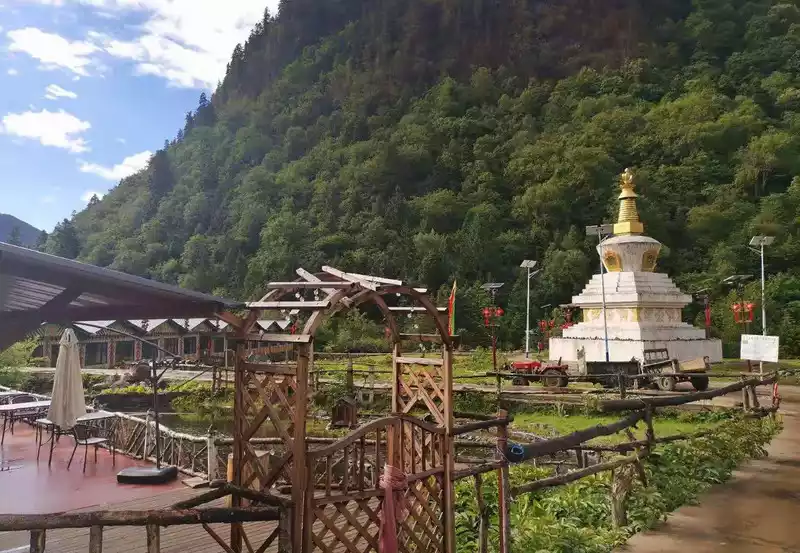
这是一排看上去很漂亮的彩色藏风屋子,可惜暂时呈现弃用状态。
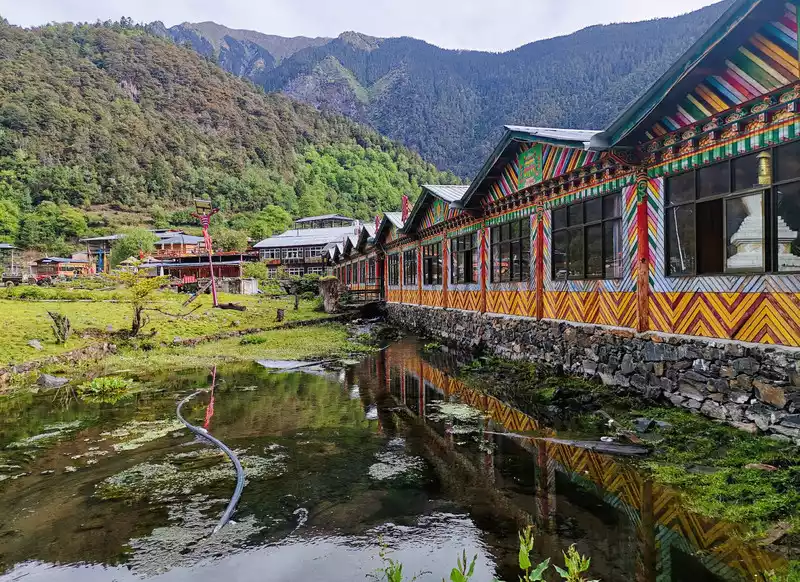
彩色屋子边也有一条小道,正好有位放牧的藏族妈妈由小道远方匆匆而来。
向着白塔的左前方前行便是由被茂密的树木遮挡住的雨崩河,沿着河边也有一条小道一直通向远方。
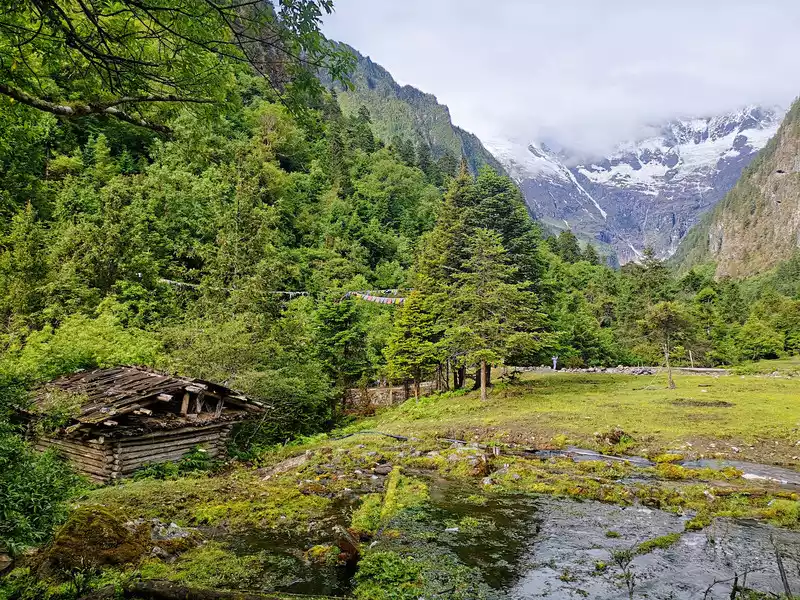
白塔的右前方便是神瀑起始处的大片草场,前一日去神瀑徒步是主要目标,所以没能好好转转,正好趁此好时光溜达溜达。
靠近湖边和寺庙周围的草场很浅,有马儿在悠闲地吃着草。
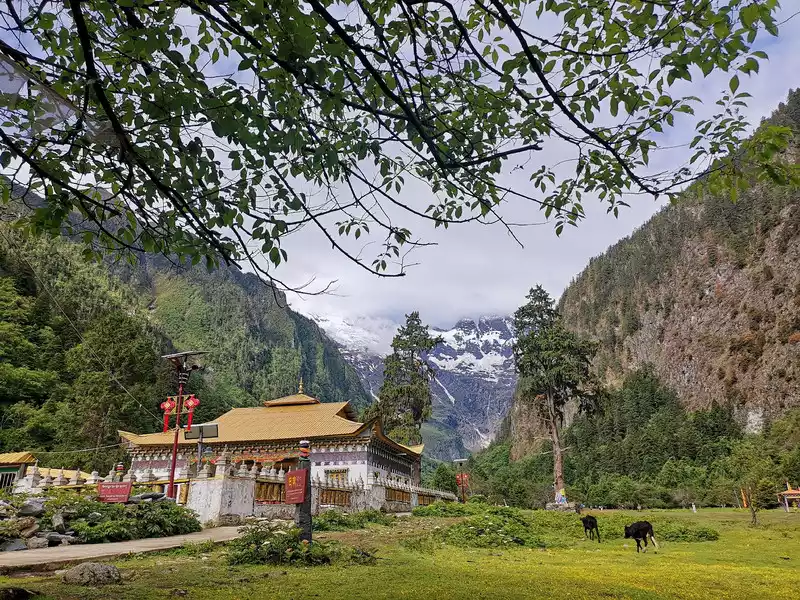
大片的浅草场上散在分布着一丛一丛的花草,低镜头贴近花草拍摄近处的寺庙和远方的雪山,整体构图又是一种意境。
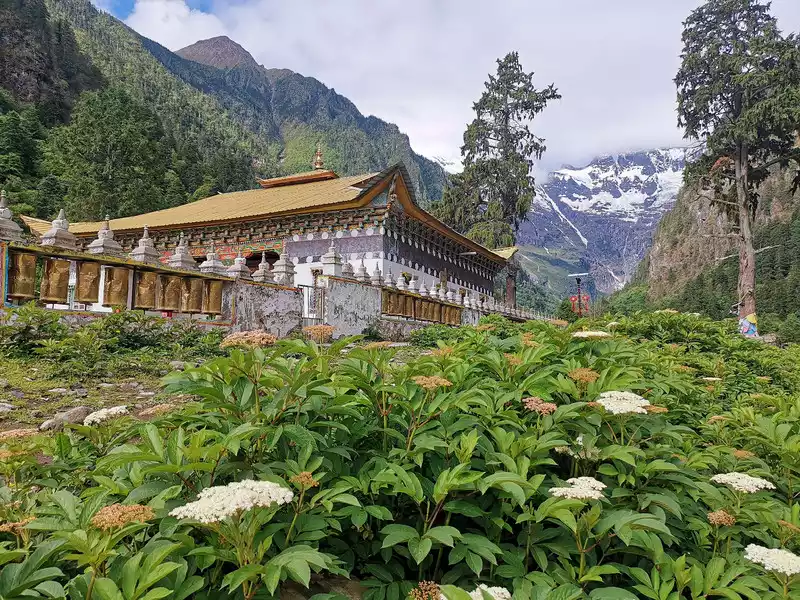
去神瀑时匆匆而过,根本没有留意这里还有一个独立的转经筒,不同的是这个转经筒是在水流的冲击下不停地转动的。坐下来,发个呆,静静地感受这旷世美颜。
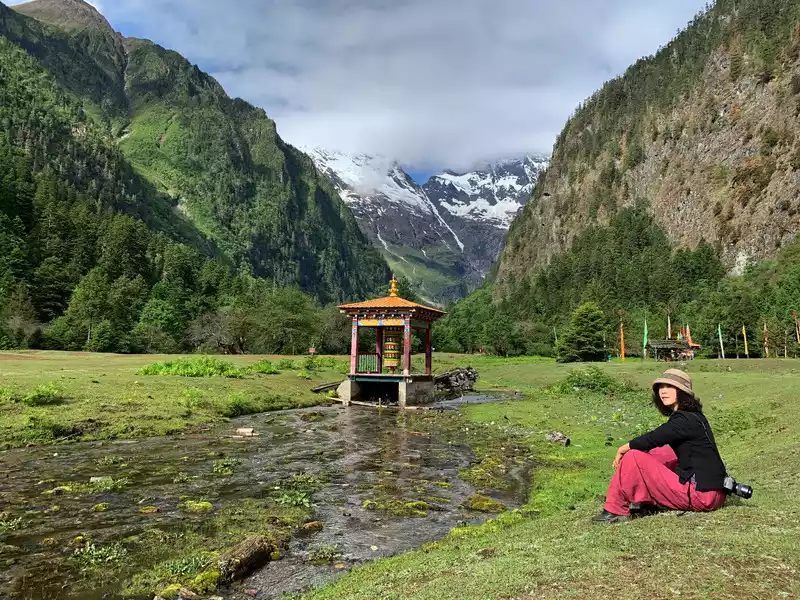
继续向右侧溜达,在靠近右侧山脚下则是一大片茂盛的花草。
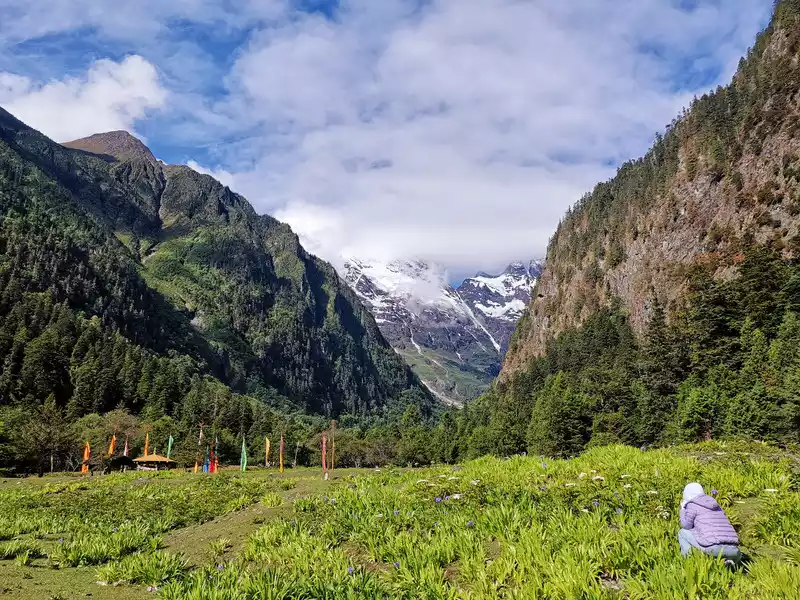
时间不早啦,向湖边返回啦,路过一家应该是距离雪山最近的民宿,彩色石块砌起的围栏很有藏族风情。
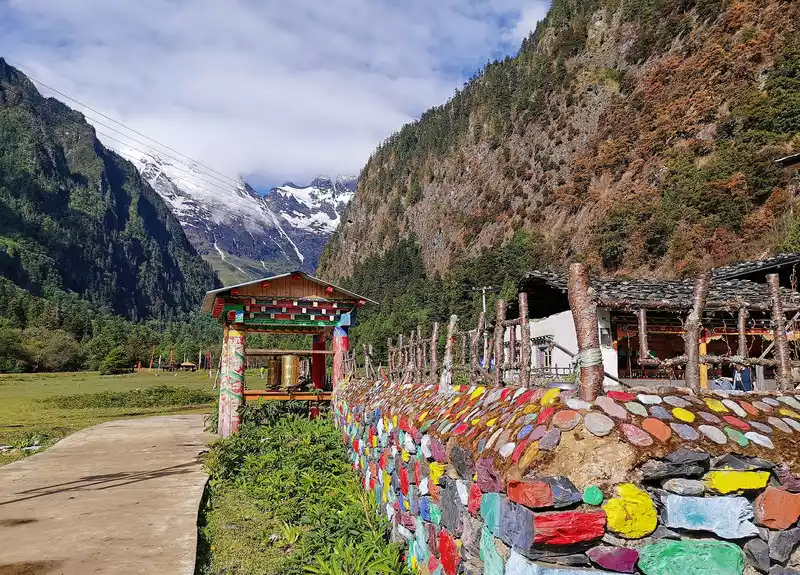
返回到湖边,一棵老树伸展着枝叶形成大大的遮阳棚。
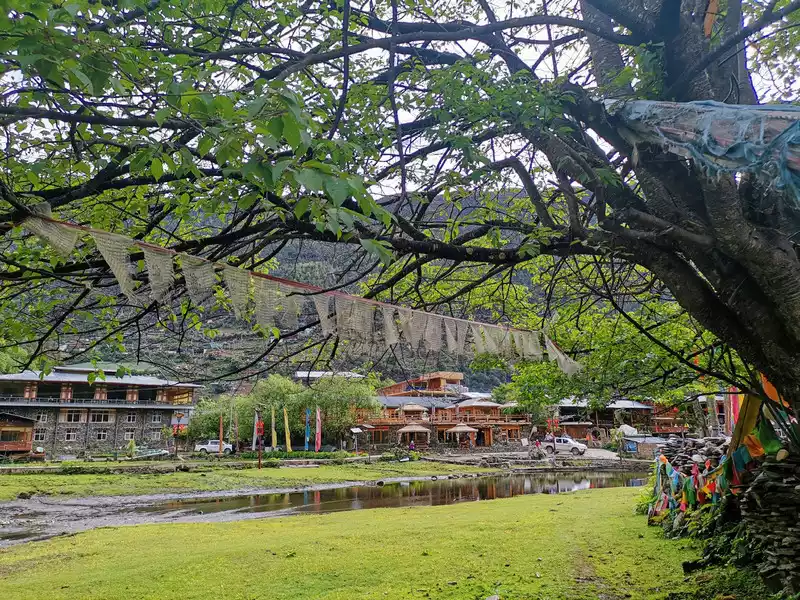
打个卡,再见啦。
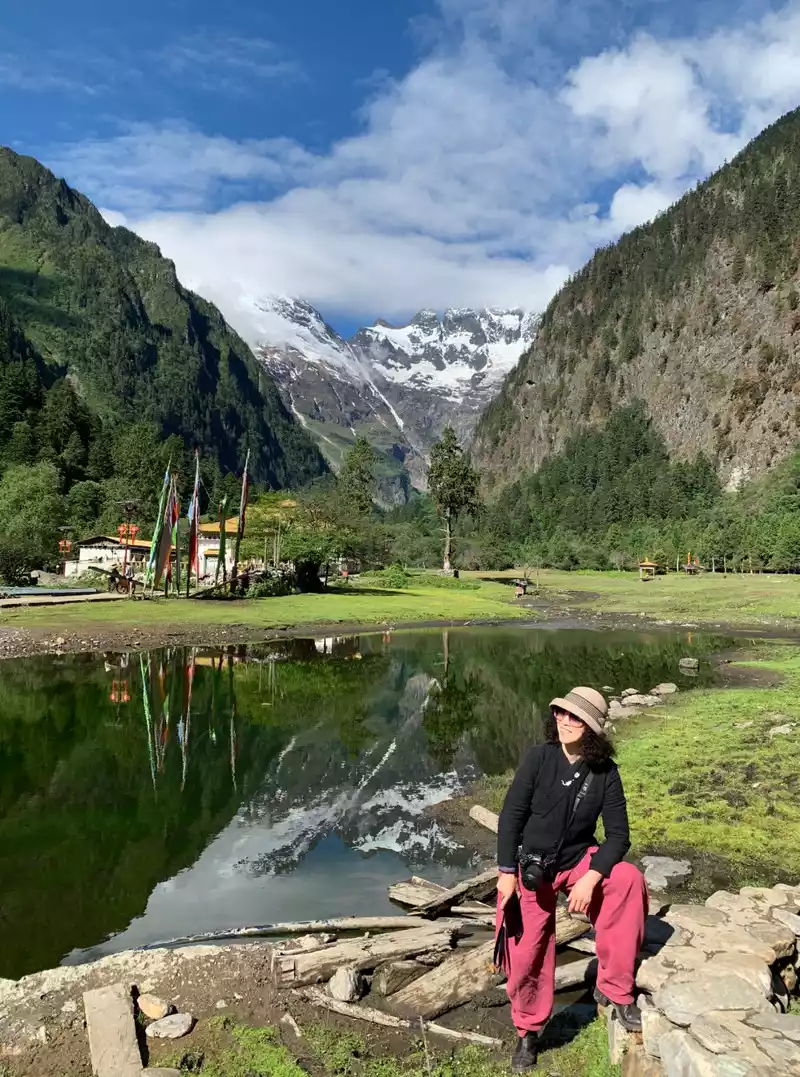
离开雨崩有徒步和乘车两种方式,徒步路线是下雨崩到尼农,大约十几公里,需用时约四个多小时,全程基本是下行,但是路况非常不好。
我们依然选择乘车出村。雨崩下村的乘车点就在小桥的一边,由下村至西当村费用为260元。我们决定徒步至上村乘车点,这可不是为了省60块钱哈,而是想一路再好好观赏一下这个美丽的世外桃源,在下村的这两天也没有再观赏到上村的景色,天气又这么给力,真的不舍得放弃啊。当然,同时又省了60元也很棒啊。
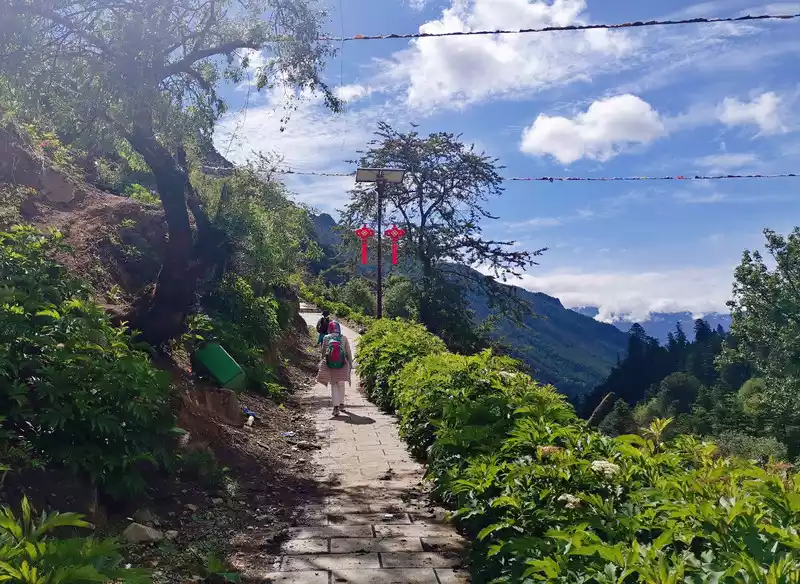
由下村至上村乘车点最简单的路线识别便是沿着这红色的路灯一直向前便一定不会错。
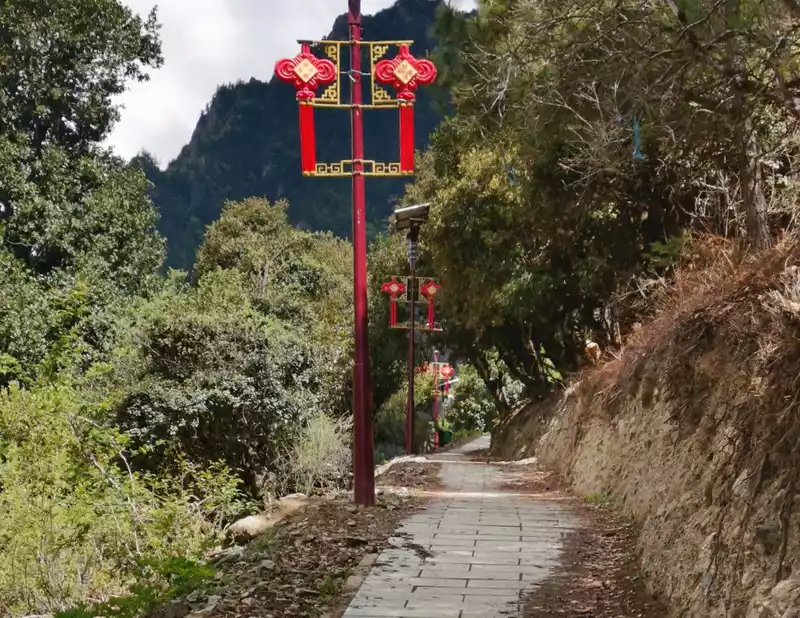
上下村的分道处,还是沿着红色路灯的小道继续前行。

一路走,一路回头看,仿佛要把美景刻录在眼底。
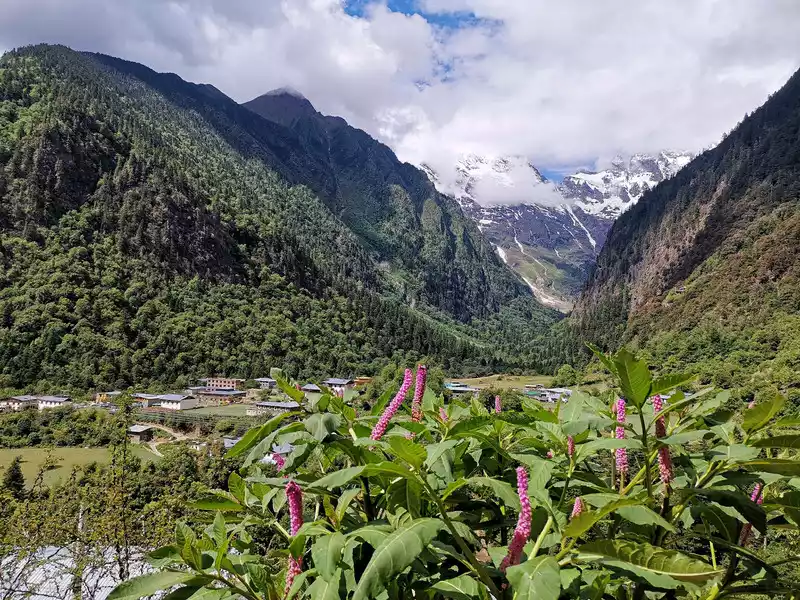
上村、下村背靠的雪山都是那么清晰,冰川也如此清晰。
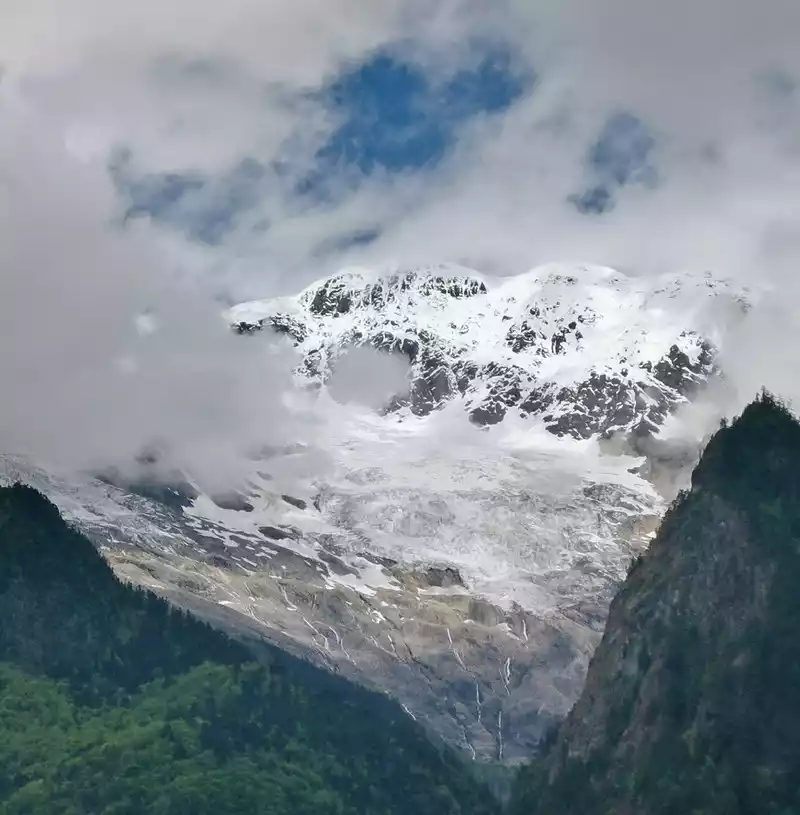
我们边走边观景大约用了一个小时才到达上村乘车点,买好车票,到观景亭等车(现场可能没有车,得下村的车坐上乘客过来)。
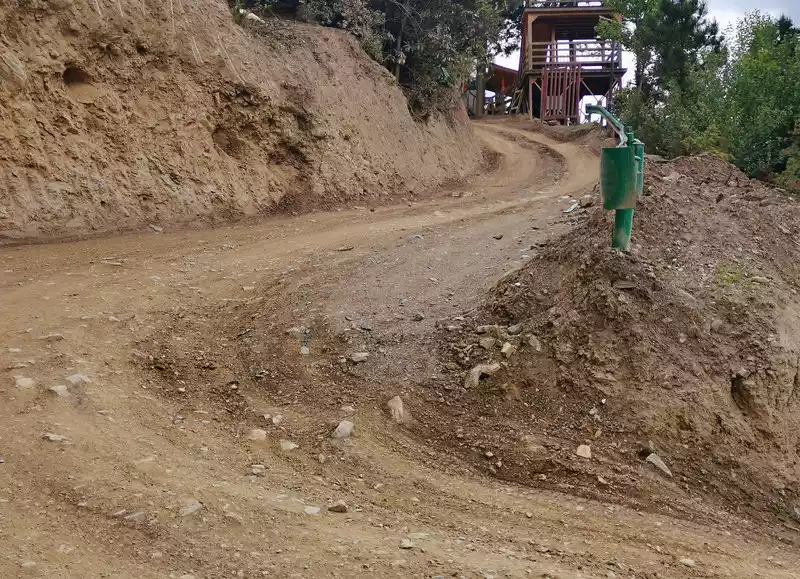
天气好,观景台的视野好,那就再拍上一张上、下村的全景吧。

我们乘坐越野车从雨崩上村回到西当村已是下午快一点了,为了不耽误时间,我们决定中餐就在车上吃点各自的点心、零食,直到下午四点多过了香格里拉县城后,才在师傅的介绍下进了一处民居,也算中晚餐一起吃了吧。
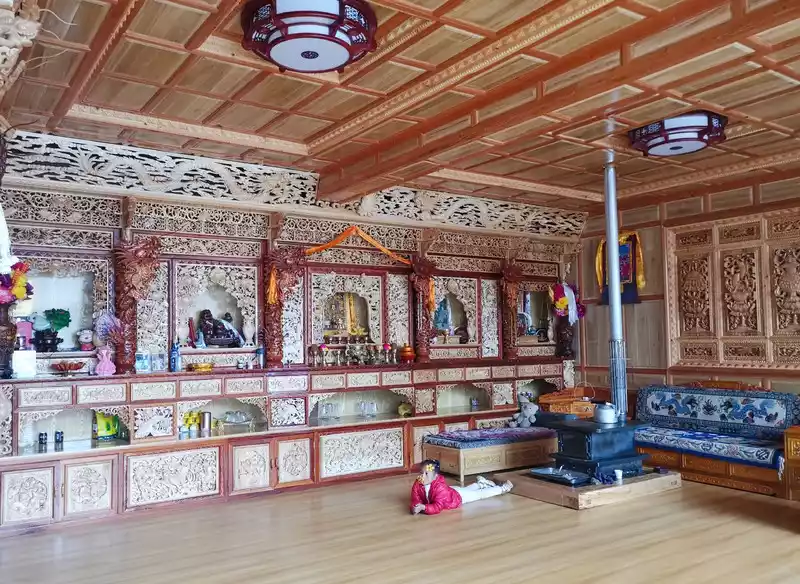
晚餐安排在二楼,因为师傅提前打了招呼,所以我们抵达时鸡汤已经炖好,我们就围坐在这个大大的炉子旁边,吃着青稞饼、牦牛干,喝着鸡汤、酥油茶,味道可都忒足了,一不小心可不吃得有点多嘛。
因主女主人打了招呼,不让拍摄二楼,原因是屋子的一圈都设了壁龛供着菩萨、还是毛主席他老人家,所以,只敢拍了这个炉子和摆放在周围的小吃食。
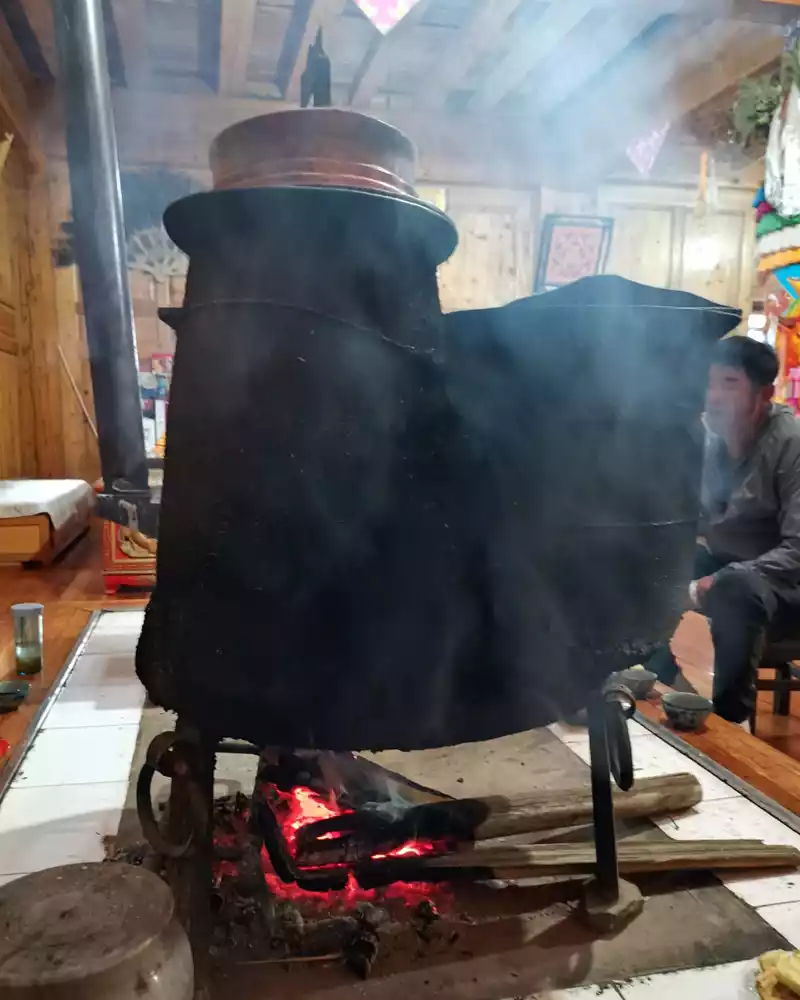
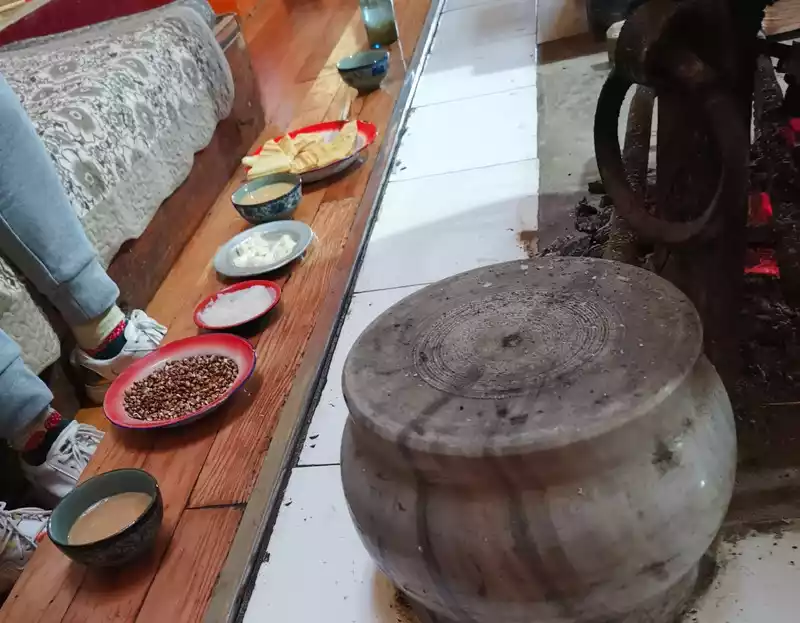
吃饱喝足了,开车到达我们当天的目的地——普达措国家公园时天已经黑透了。
为了加强体验,我们还是选择住进了景区内的酒店——【香格里拉普达措悠幽庄园】,由景区大门进入后还得开上10分钟左右才抵达酒店。
这是我们一路住的最贵的酒店,携程预订每晚397元,这在非旅游旺季算是贵的了。不过酒店条件确实也是最好的,但是供氧机是收费使用的。
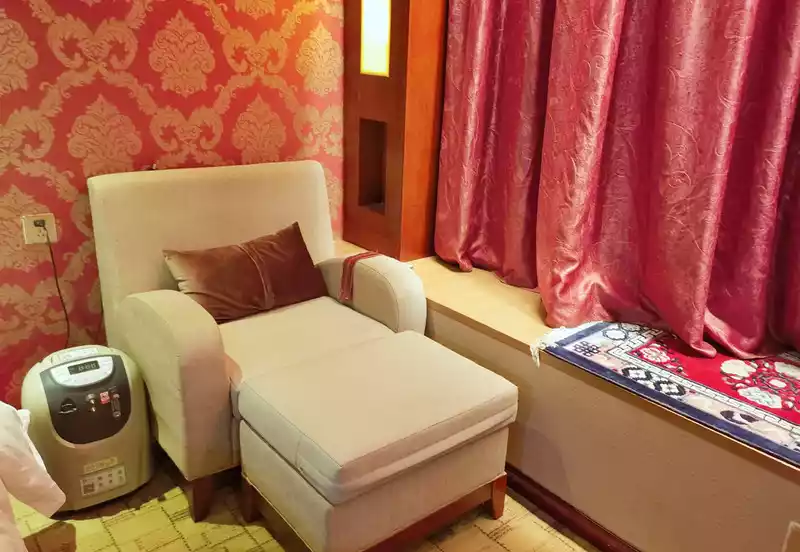
早上起来,从窗外望去,外面正下着小雨,景色一副朦胧之美。
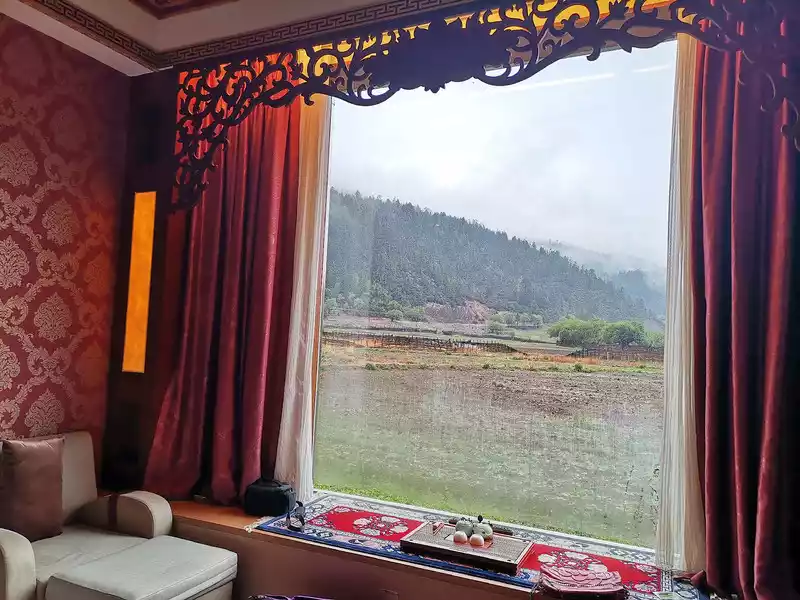
我们入住的宾馆是位于公园里的唯一 一个酒店,酒店工作人员颇有些自豪地和我们说酒店是国有单位,晚上入住时没能细看,白天酒店里走上一圈,看起来也确实相当不错,但是这样一个不小的酒店竟然只有我们一行六从入住。
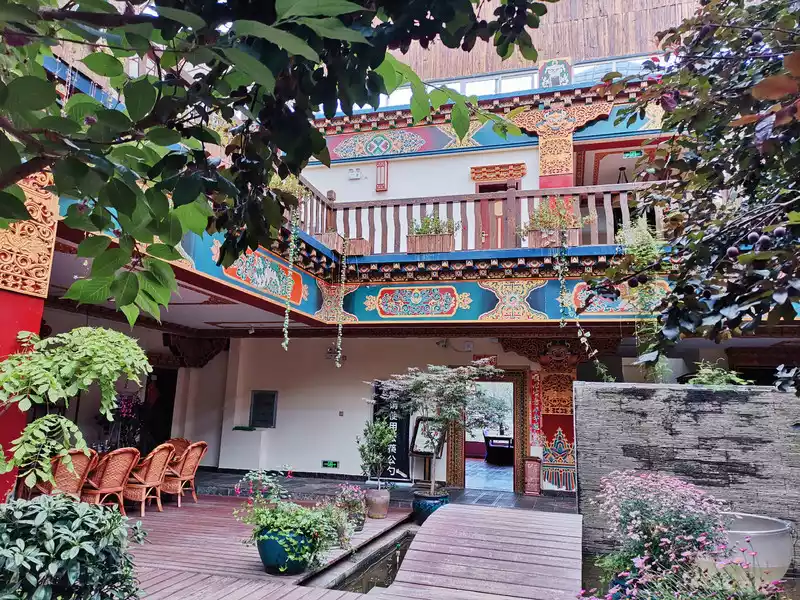
趁着早餐时间还早,便到酒店周围转了转。
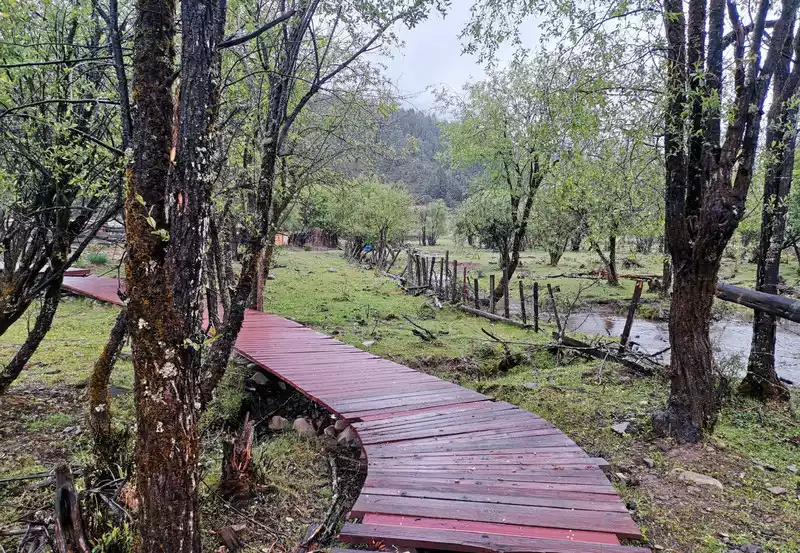
酒店位于一处较开阔的水丰草盈之地,周围则是群山环绕,小雨中的山峦仙雾缭绕,漫步其中,呼吸着沁人肺腑的空气,真是美妙极了。
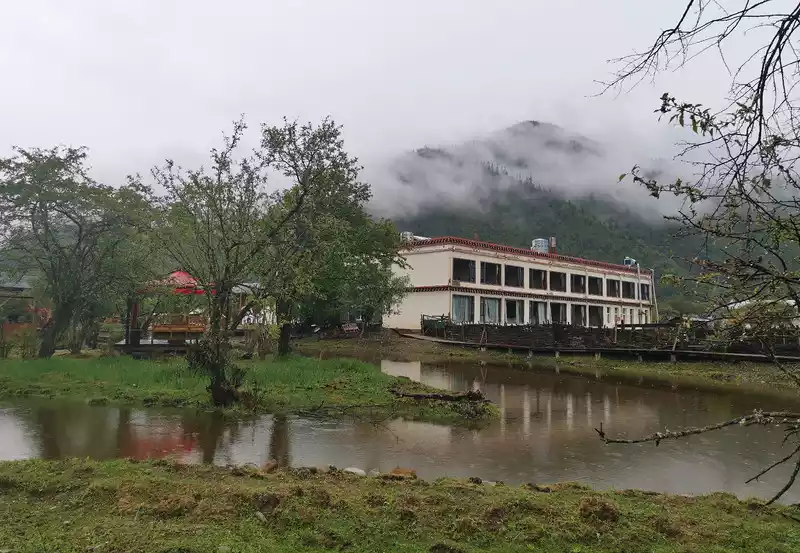
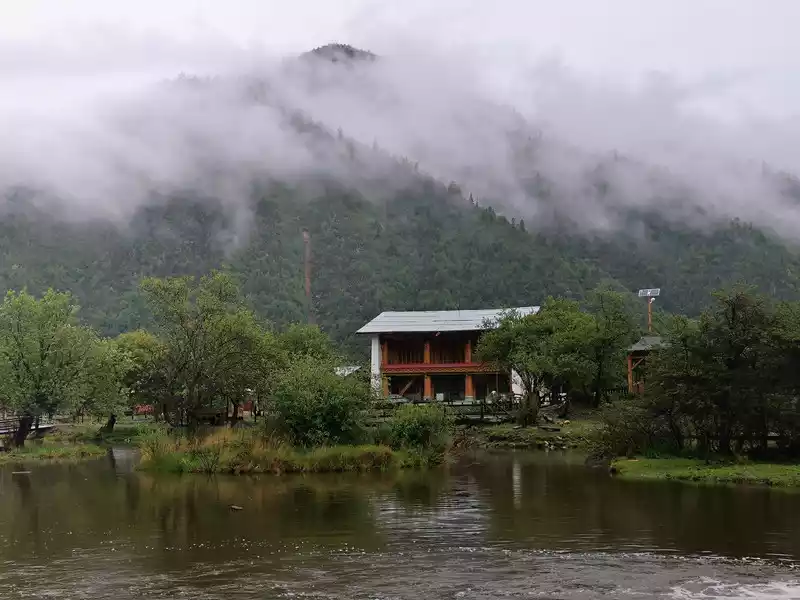
这里是酒店的户外烧烤棚,看上去很久没有使用了。
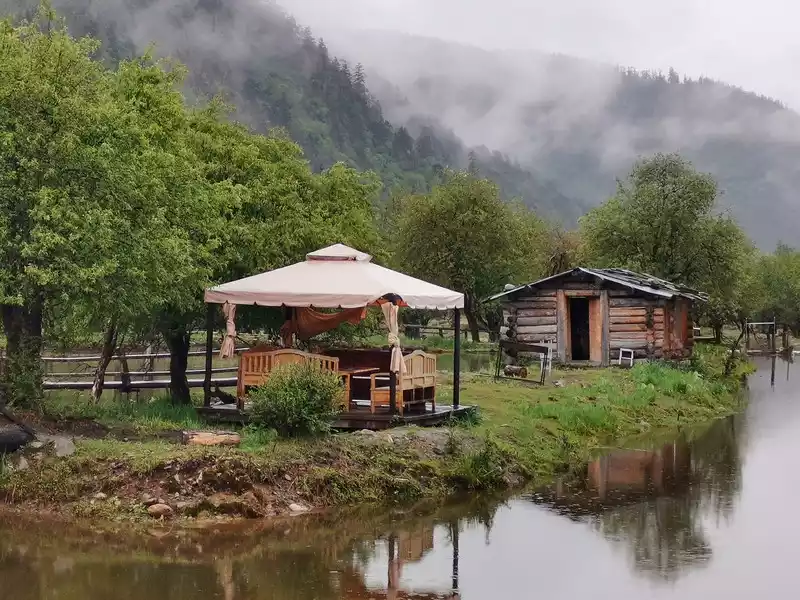
早餐后我们按照酒店接待人员的指导步行走到景区交通车的停车点。
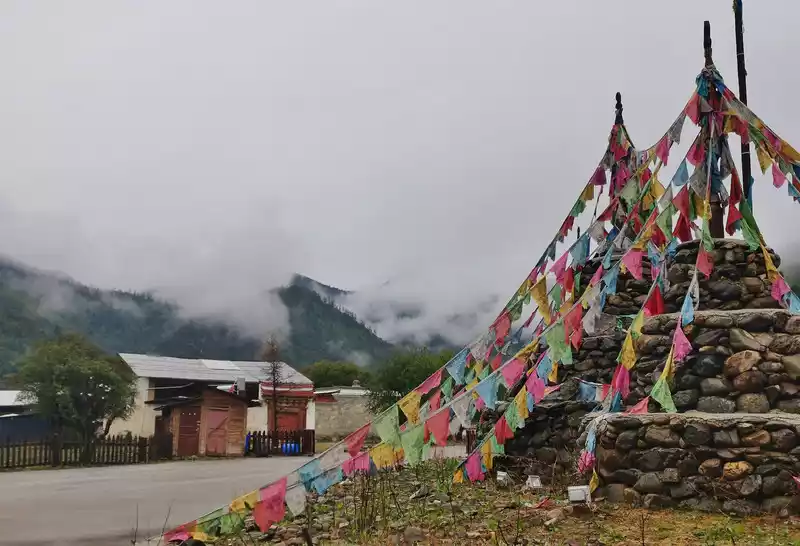
原来酒店所在的这处地方便是景区保留的老村落洛茸村,路边几头藏香猪很自在在吃草,还是第一次见放猪的。
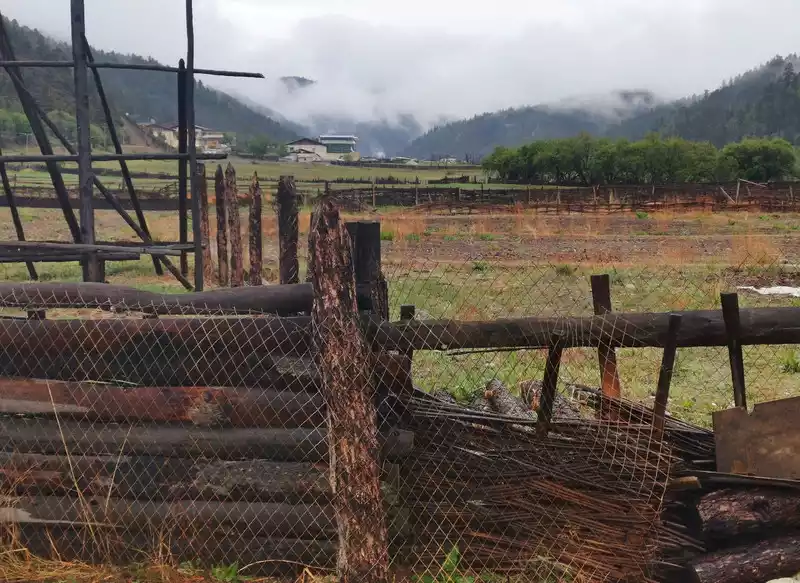
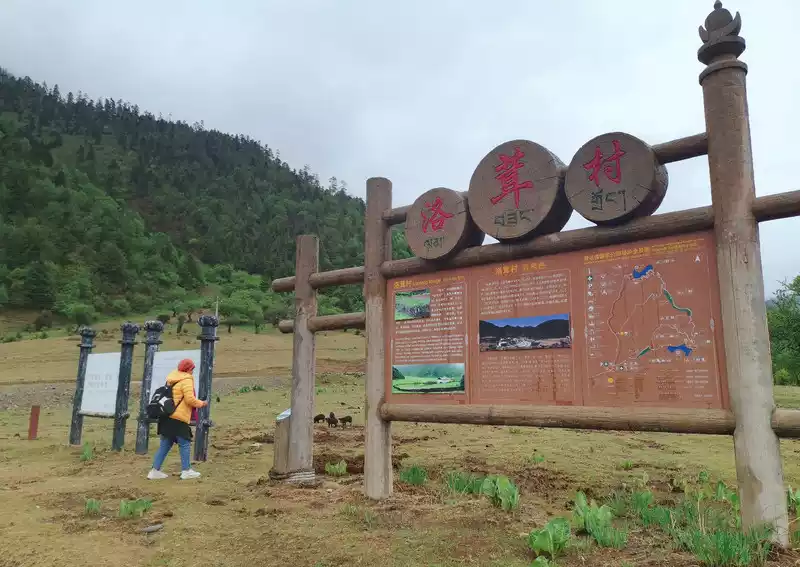
景区交通车从景区大门口开过来,车上已坐了大部分的游人,车子一路开过去,不时的闪出一些个小村庄。这是普达措的特点,景区和老村庄同在。
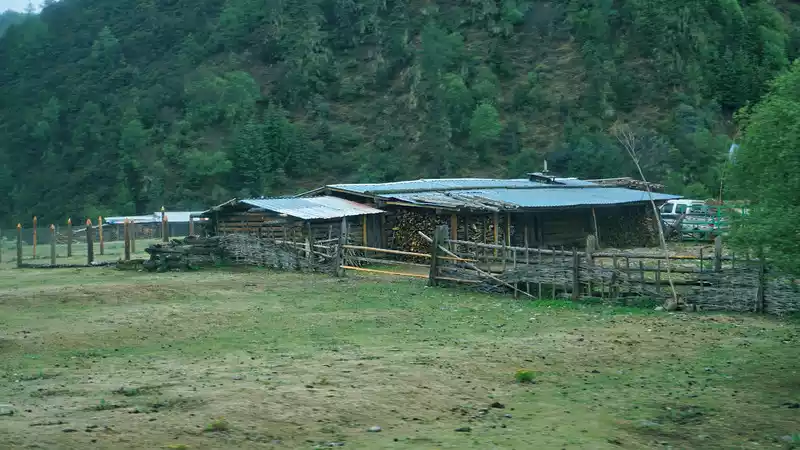
普达措国家公园,位于滇西北“三江并流”世界自然遗产中心地带,海拔3500米至4159米,由碧塔海、属都湖、弥里塘亚高山牧场三部分组成,但是目前只开放属都湖一处,所以景区大巴便直接开到了属都湖起始处。
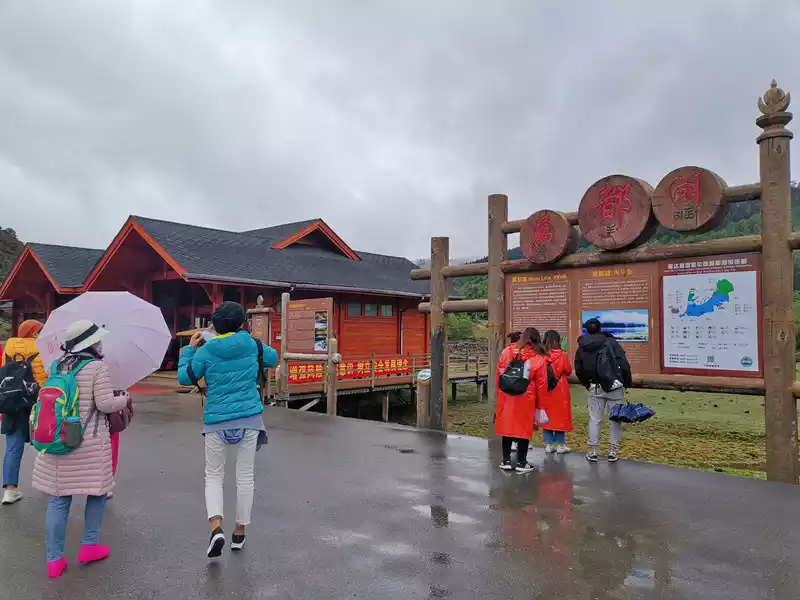
属都湖景区全程都是这样的栈道,而且均是平地,没有上上下下的坡度,景区内植被丰盛,所以虽然属都湖海拔3705米,但是没有一点高原的感觉, 当然也与我们行前做了充分的抗高反准备、又在香格里拉适应了很多天有关。
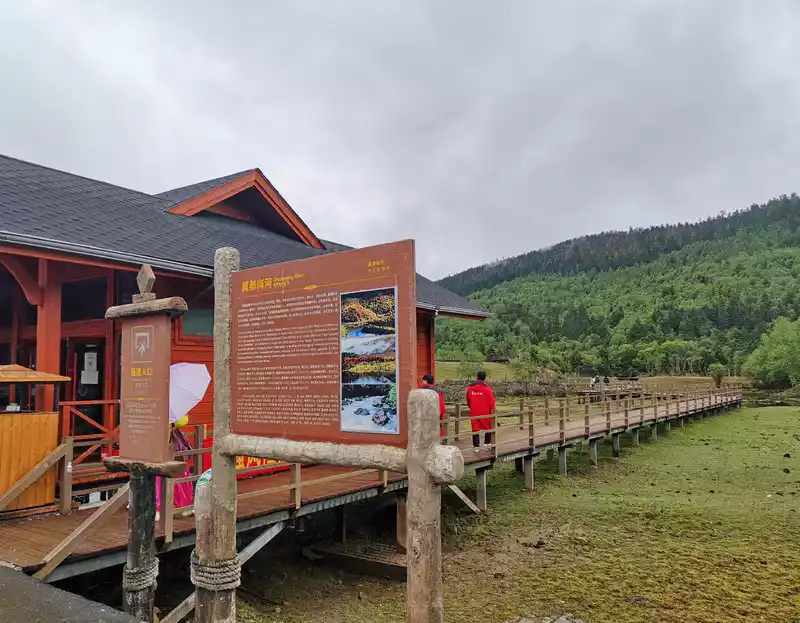
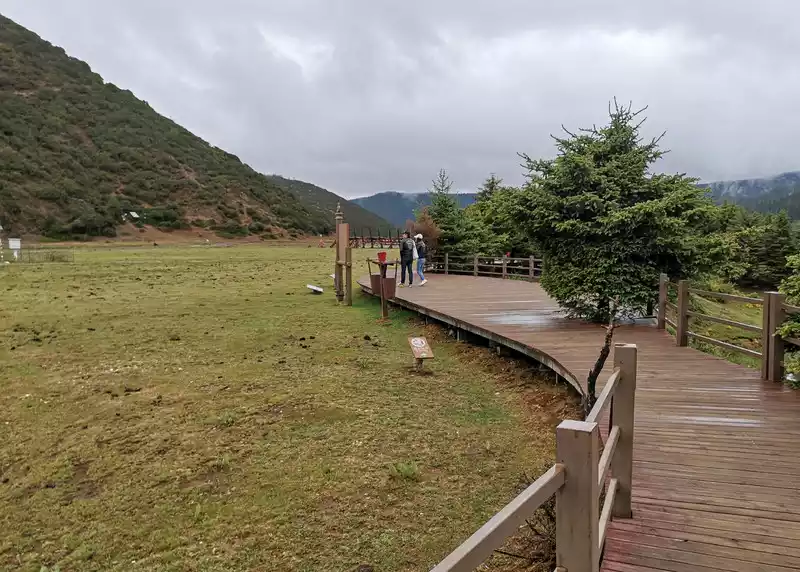
沿着栈道一直向前,左边是被群山环绕的属都湖,可能是因为天阴吧,感觉景色平平。
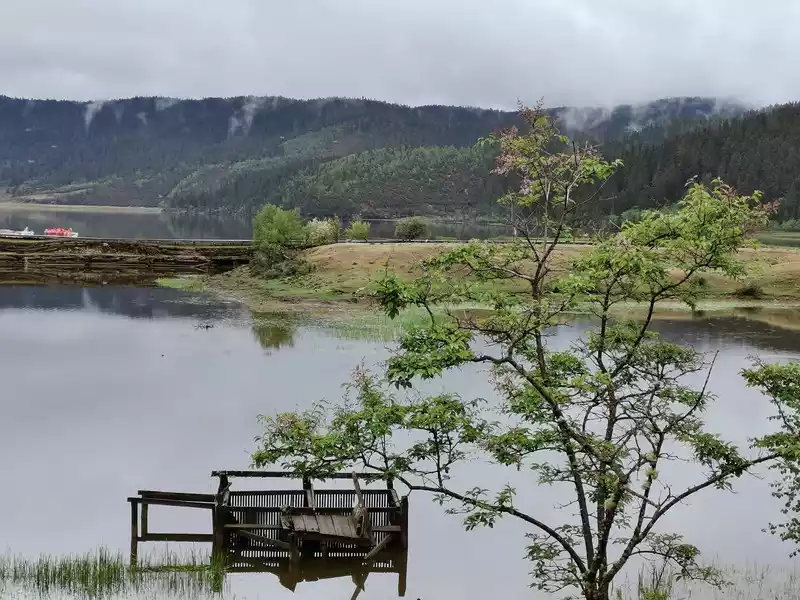
湖的一侧有一处摄影点,几百元一套系,虽然天气不太好,甚至下起了小雨,但是还是有不少人在兴致勃勃地拍照。

栈道的右侧是大片的原始森林,高大的老树上挂满了松萝,说明这里的环境质量真的是非常好了。
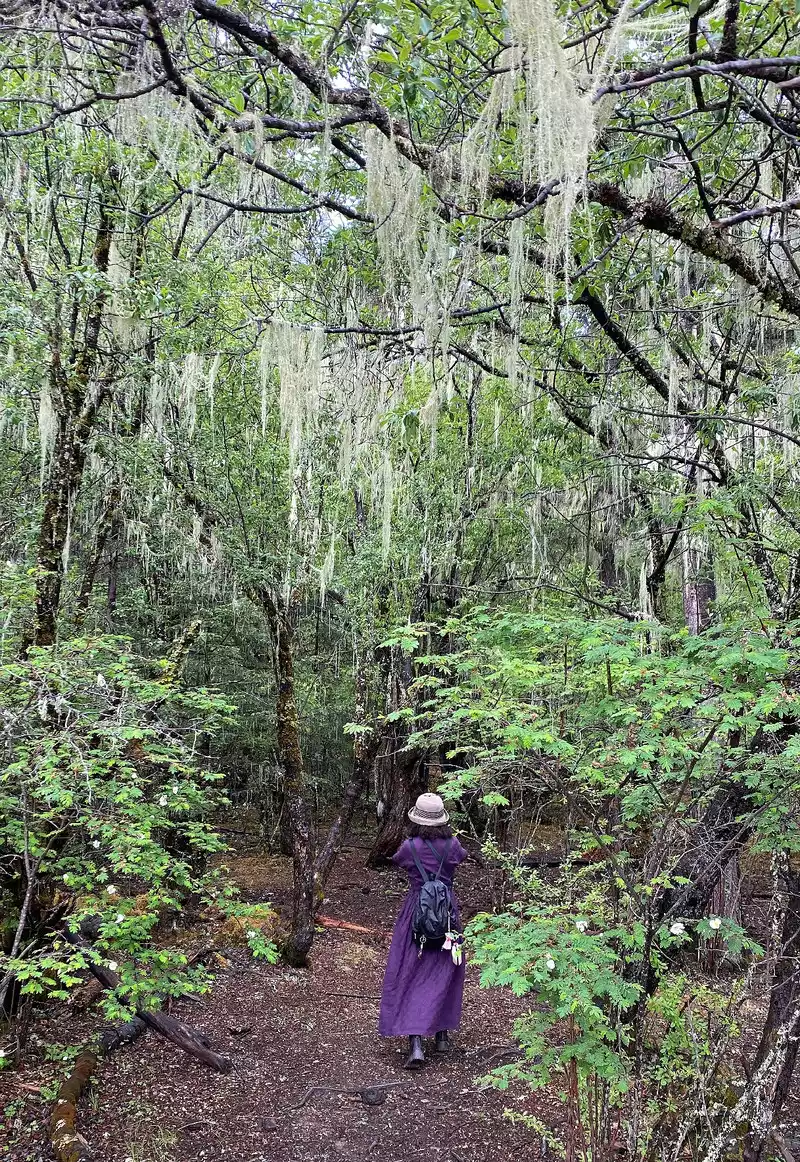
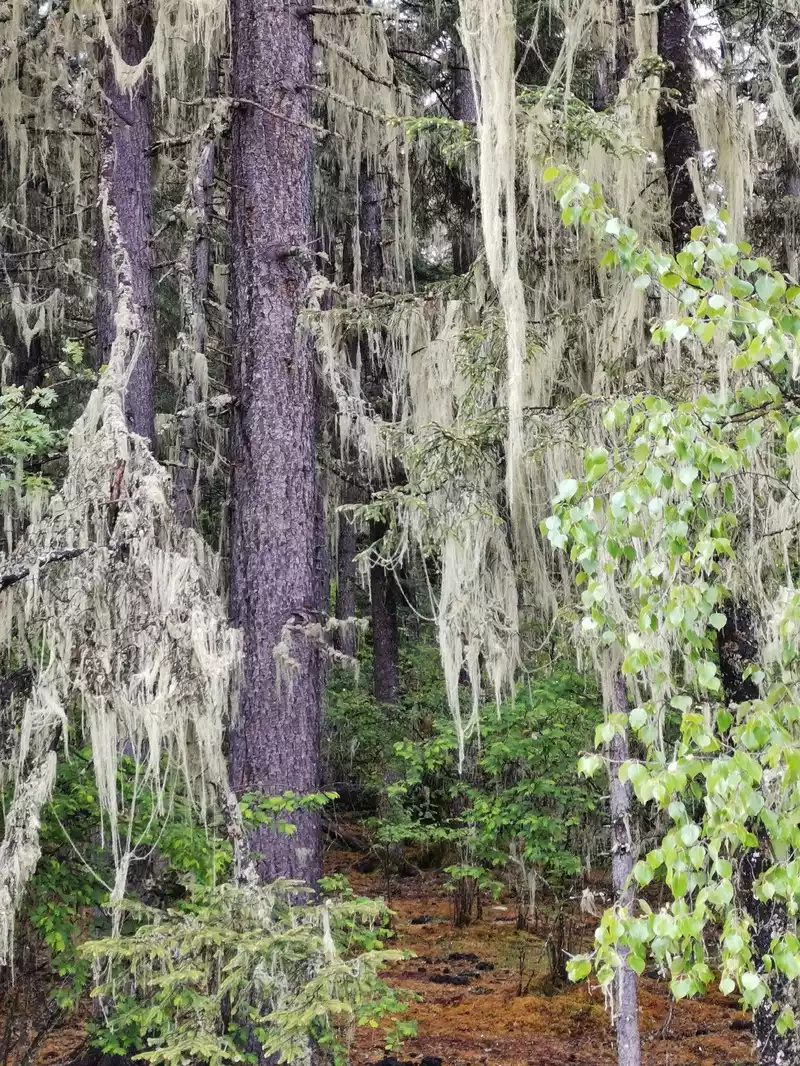
森林的周边和树之间一片一片的杜鹃花开得正旺,远远看去灰蒙蒙的一片,但近处观赏却很是鲜艳、动人。
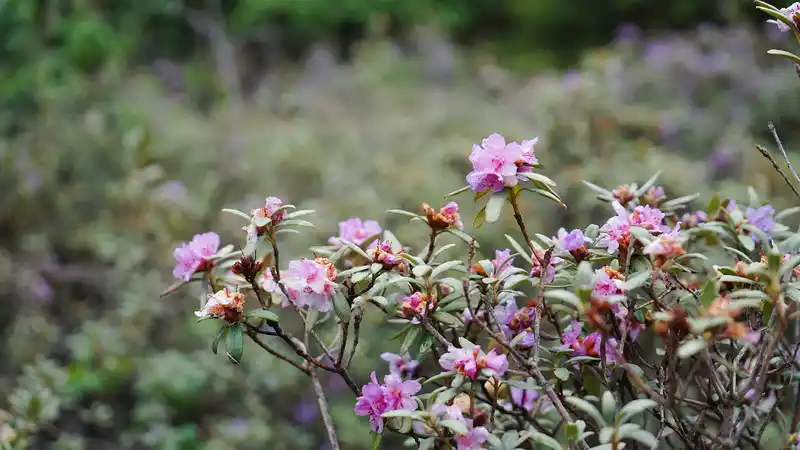
小松鼠跳来跳去一点不惧怕行人,如果喂它瓜子,它会敏捷地取走,背过身子蹲在树根处投入地吃了起来,吃完了便又过来讨要,很可爱很可爱的样子。
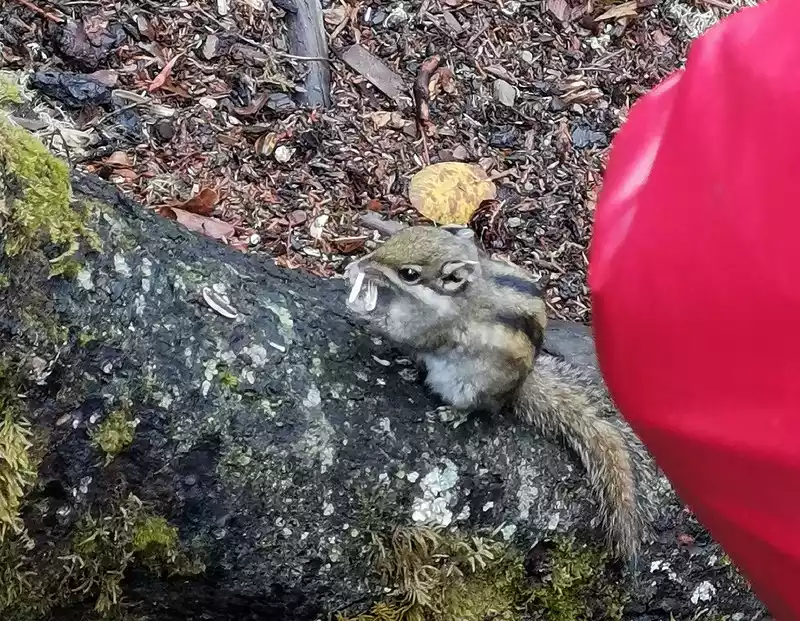
这是最后一段可以走近湖边的路段,这段湖边的草地更加茂盛、翠绿,映衬着岸边和水中的枯枝也有了生命力。
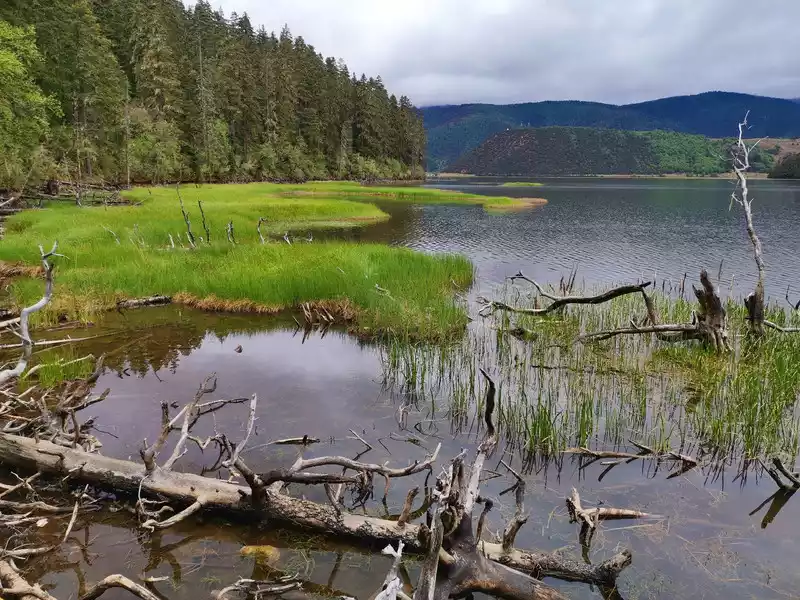
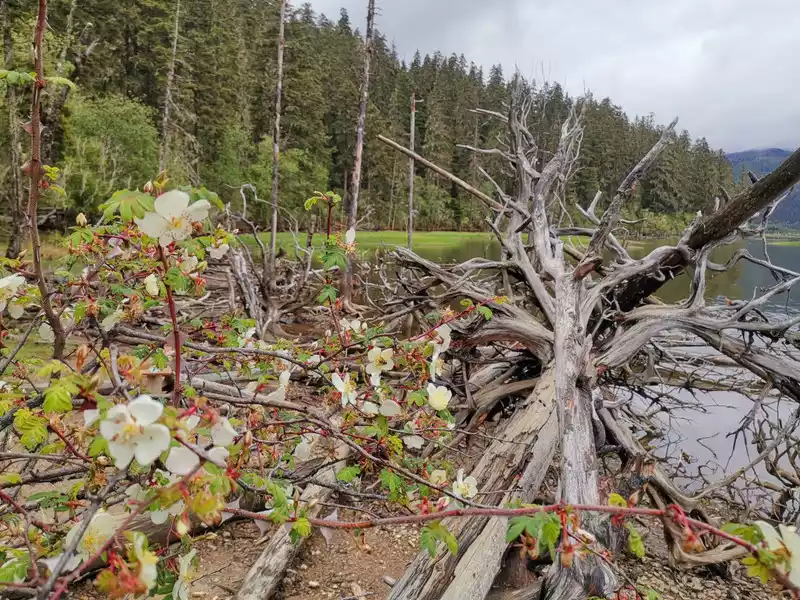
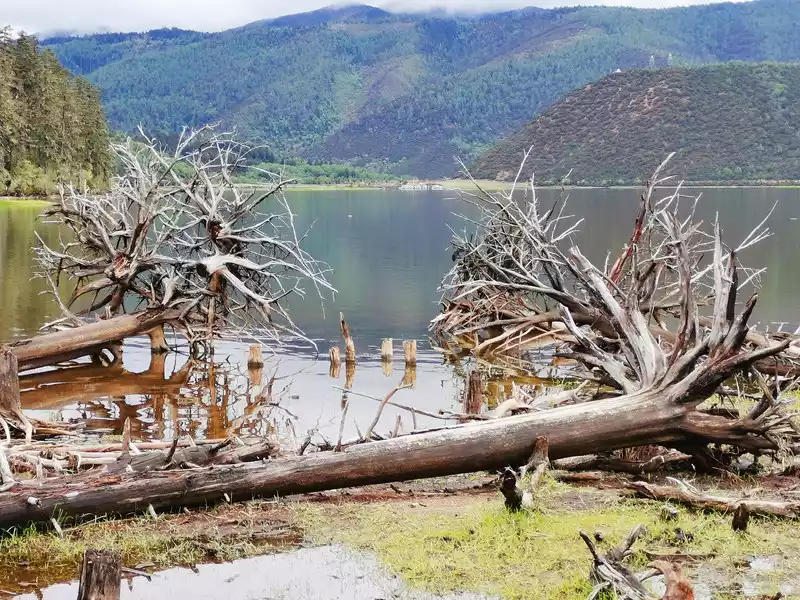
又是一个种类的杜鹃花,粉嫩粉嫩的煞是好看。
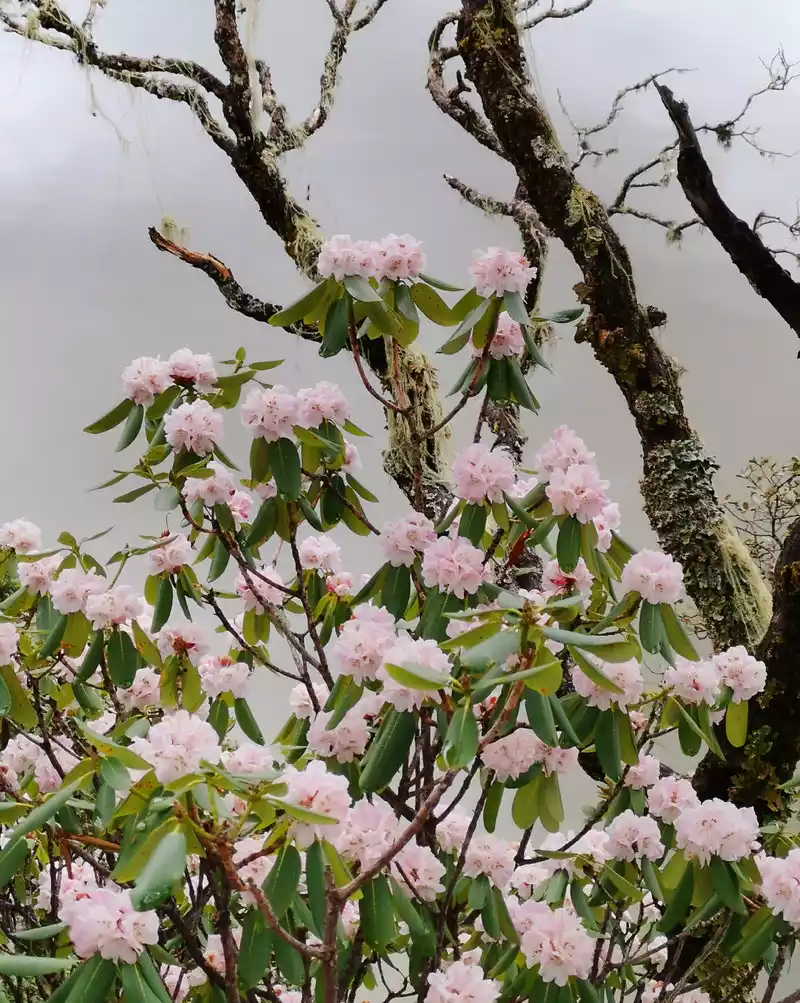
普达措国家公园是香格里拉最早开放的一批景观,名声很响,几乎是必去的一处景点。
但关于我们此行是否去普达措其实颇有些犹豫,因为普达措本身自然环境确实还是一流的,但是这一路的美景实在太多,所以有些不去遗憾,去了却有些失望的感觉。所以,建议最好将普达措放在行程的前面。
属都湖景区走走看看大约两个多小时,乘景区交通车回到景区大门口已是午餐时分。
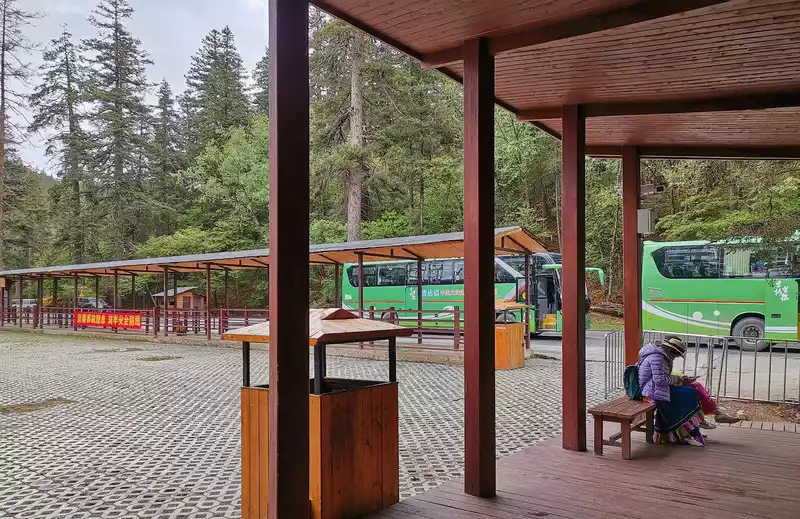
公园大门外有一处卖小吃的地方,品种挺丰富,价格有点贵但还算行。
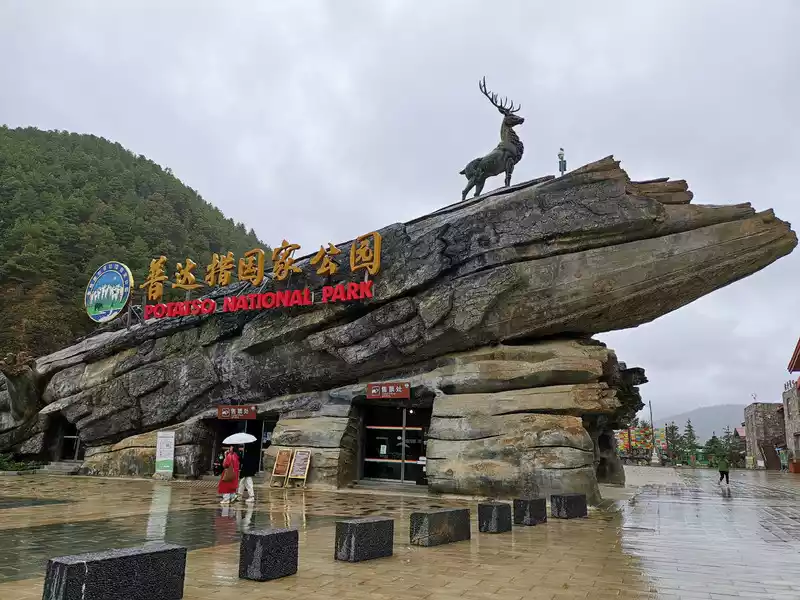
简单的中餐后我们继续前行,当天的目的地是白水台,但是这前往白水台的路可不是一般的烂,好在我们的师傅是在香格里拉这条线上跑了十七年的“老司机”,技术杠杠的,如果是自驾的话还是劝退吧,因为这路不是某些路段烂,而是一直都这么烂,导航显示八十多公里的路,我们开车走了四五个小时。
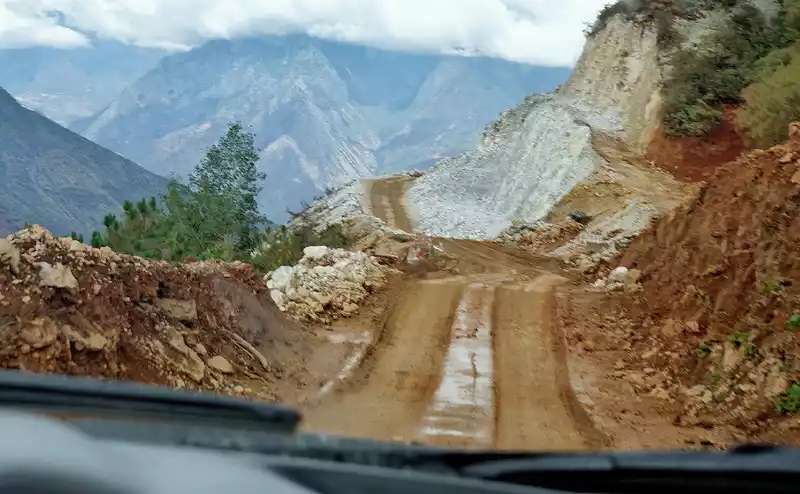
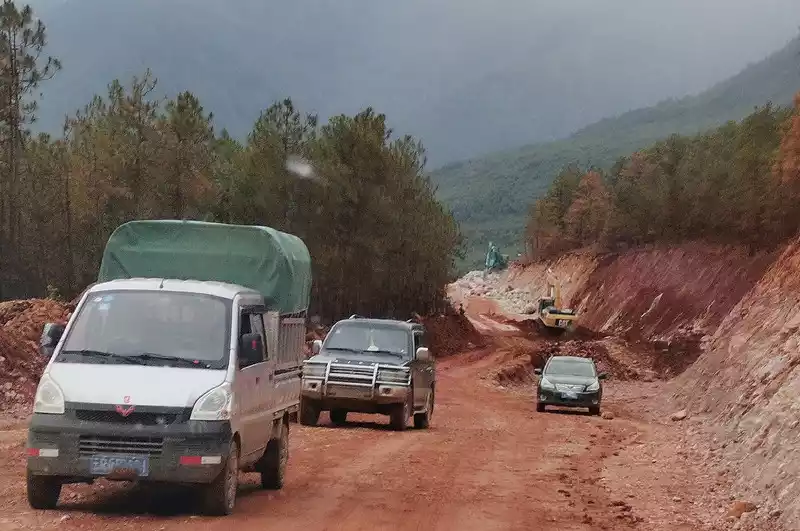
总算千难万险地赶到了目的地,东巴圣地白水台,这里也是我们此行最为期待的景点之一。
我们预订的民宿就位于白水台景区的山脚下,老板是位非常自信又自豪的中年人,住进他家他一定会给你介绍他的光辉历史:曾经上过央视。
民宿距离售票处步行仅几分钟时间,所以安排好住宿,我们便来到白水台的售票处了解情况,门票30元一张,只可进出一次。因为天色已晚,而且是阴天,所以问清楚第二天开放的时间,便返回民宿就餐。
哈哈,又是鸡火锅,但是看着还是那么诱人!
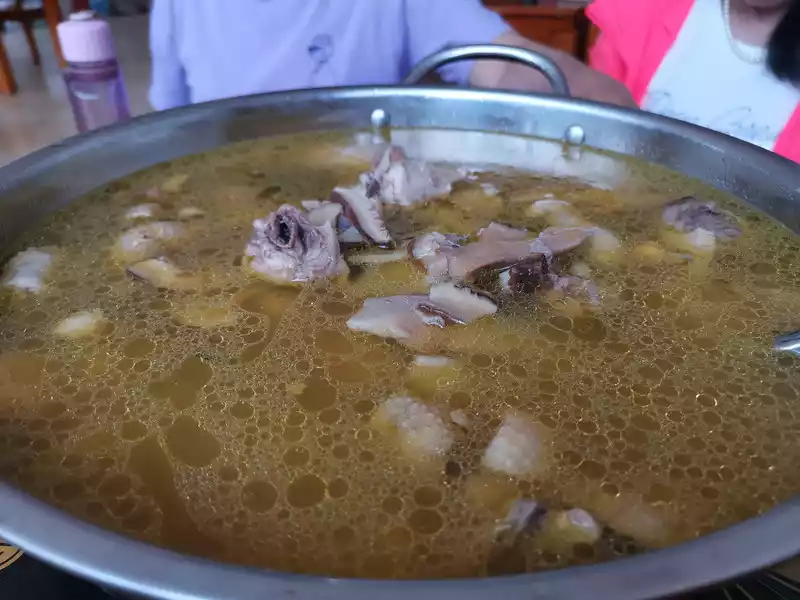
Day10.丽江香格里拉自由行之【白水台】
白水台位于哈巴雪山麓,海拔2380米,乃东巴圣地,纳西之源。白水台的形成是由碳酸钙溶解于泉水中的自然奇观,这处白水台也是我国最大的华泉台地。
带着对这处特别景致的期待,我们一早便吃好早餐,八点钟前便来到售票处。早上的天气仍旧不是太乐观,虽然没有下雨,但天空灰沉沉的,山上也是雾濛濛的。
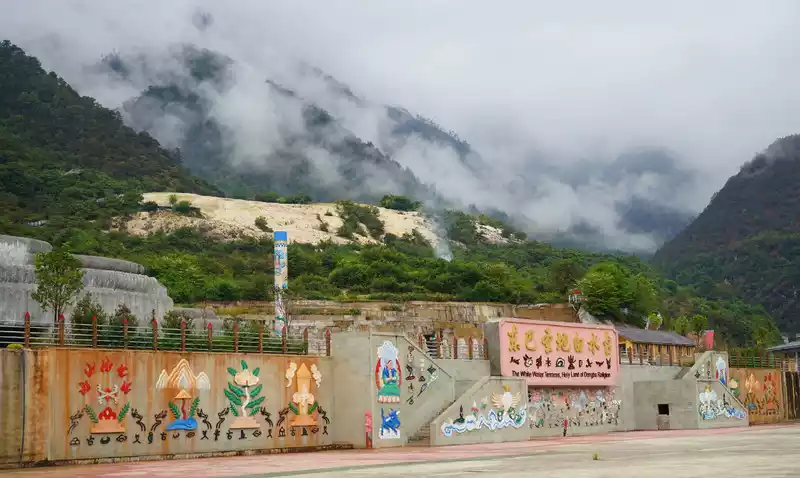
买好门票,回绝了村民的骑马吆喝,便沿着售票处旁边起始的栈道一路向上。
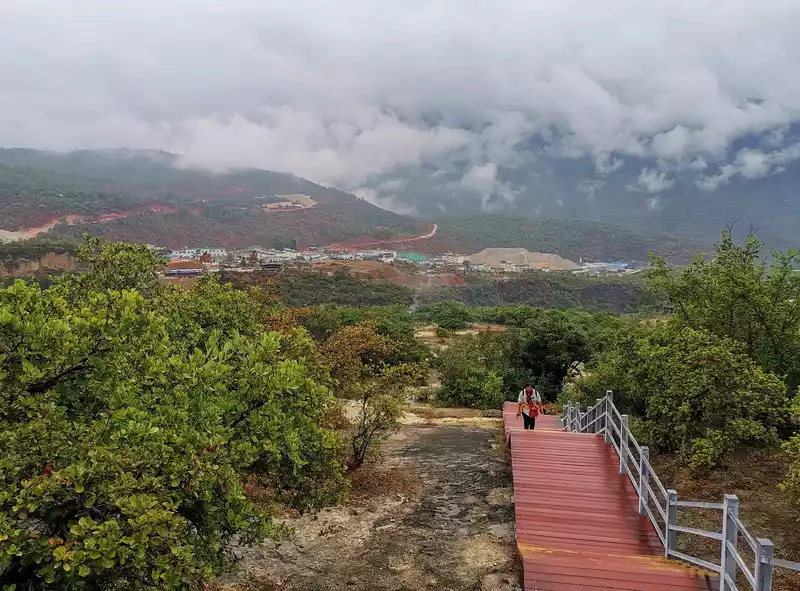
栈道坡度较大,走起来还是有点费力气,不过两千多的海拔不会有高反,我们的时间也很充分,所以慢悠悠的上行也并不太费力。大约上行了十来分钟的时间,看到一处水台,本以为到了呢,结果一看居然一处人造的水台。有点不太理解啊,为啥上面是正经的自然白水台,为何在下面修一处人工白水台。
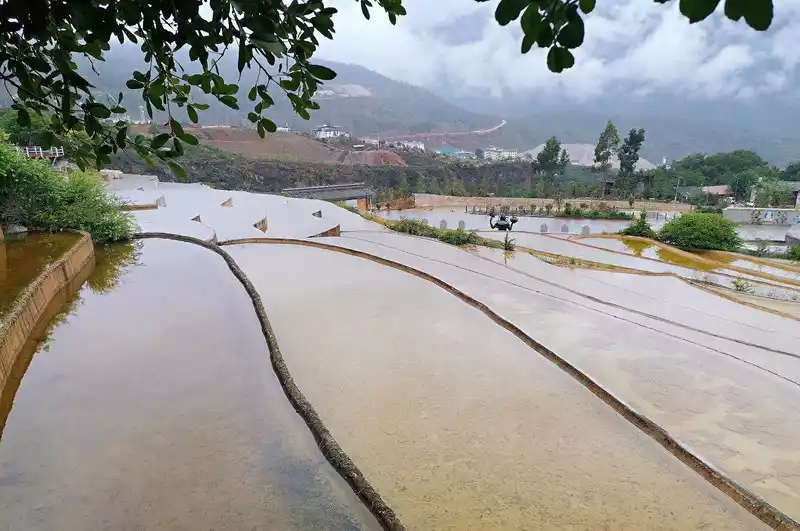
继续向上,大约几分钟后便到达正牌白水台了。
白水台第一层观景台便是“神女显灵”,站在第一层观景台只能看到此层水台的台礕,高高的台礕如同倾泻而下的瀑布凝固在远古的时空里。
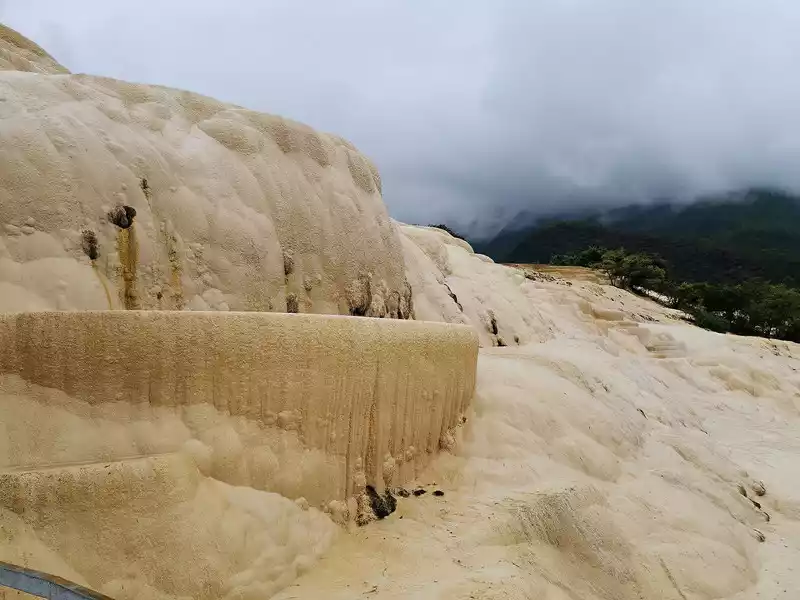
第二层观景台便是刚才所见的台礕之上的台面了,水台高高低低、层层叠叠的错落着,只觉得一种剔透的美、恬静的美扑面而来,好吧,还是以古诗润之吧:“云波雪浪三千垄,玉埂银丘数万,曲曲同留尘不染,层层琼涌水常凝。 ”
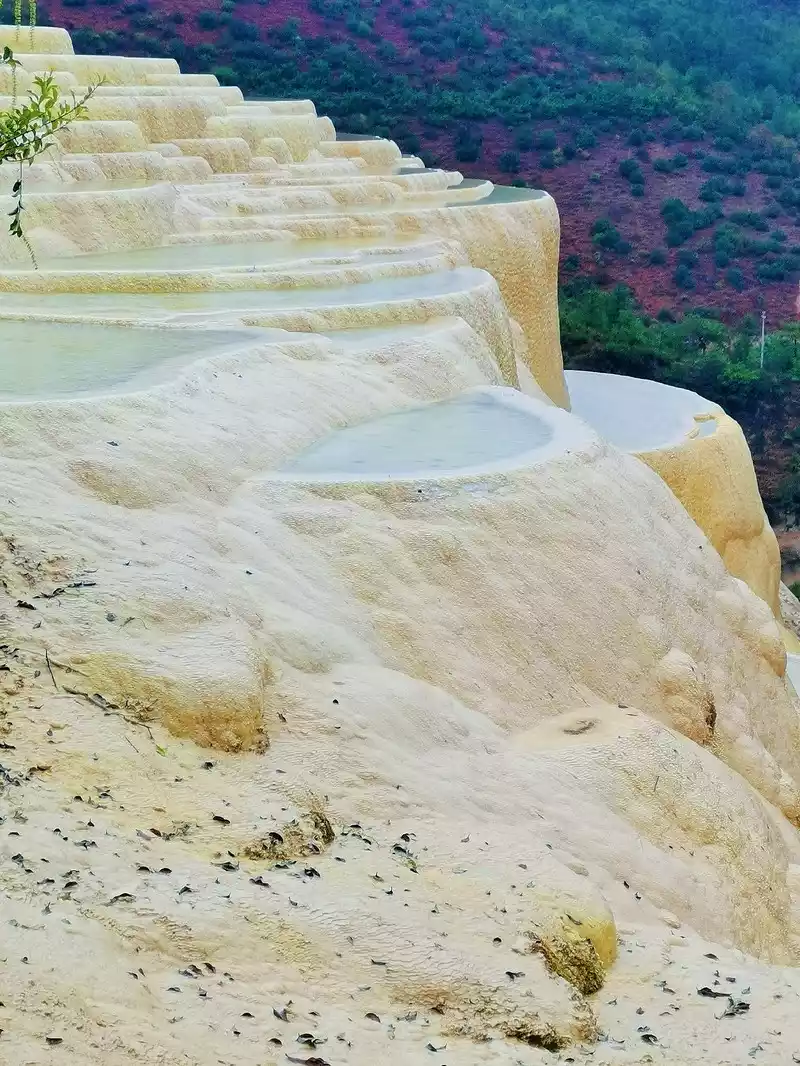
由第二层观景台向上,右边是白水台最大的水台集中景区,而左边便是白水台全景观景台。
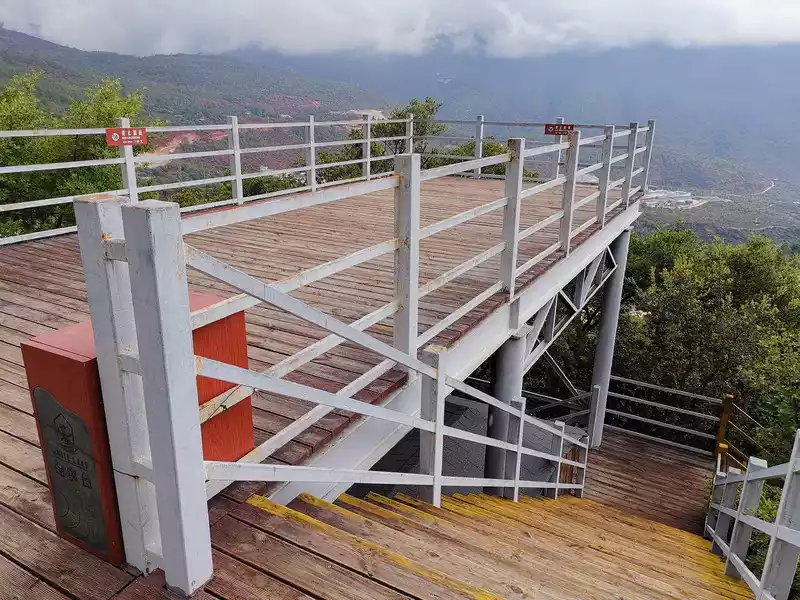
由观景台向白水台望去,白水台景区的最大一片水台------“仙人遗田”尽揽眼底,蓝莹莹的水面、玉石般的水台被四周绿色的山峦拥抱着,着实十分的灵动。
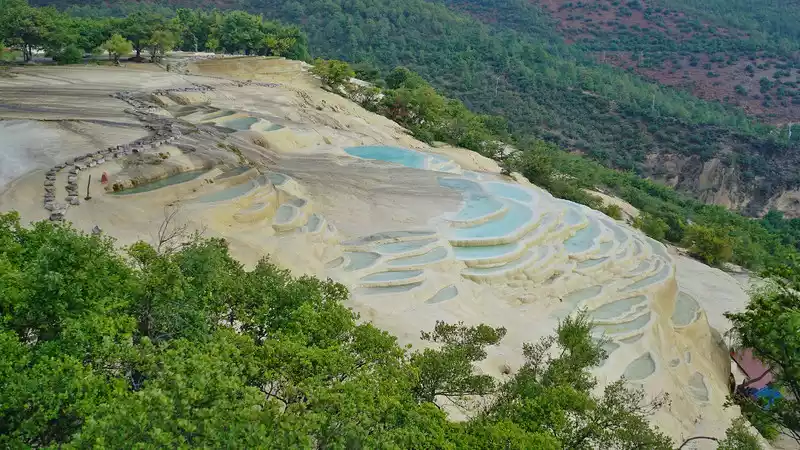
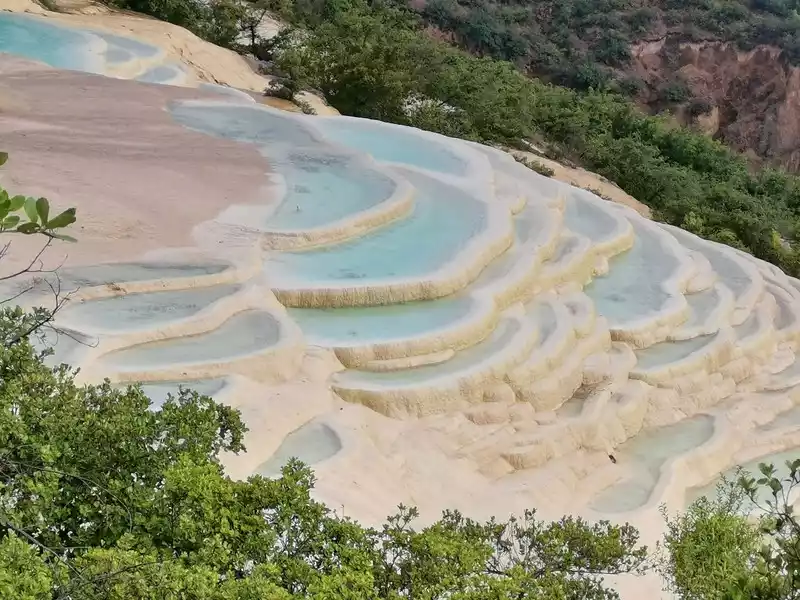
由观景台向山下看去,是被群山包围着的三坝乡白地村,虽然远山几乎被云雾笼罩,但位于群山脚下的村子却十分清晰。
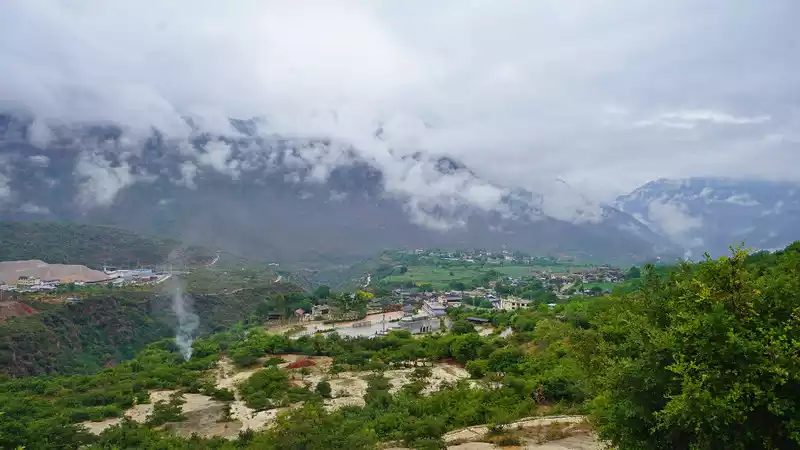
从全景观景台下来,沿着石块搭成的栈道细细观赏这大自然的奇迹。
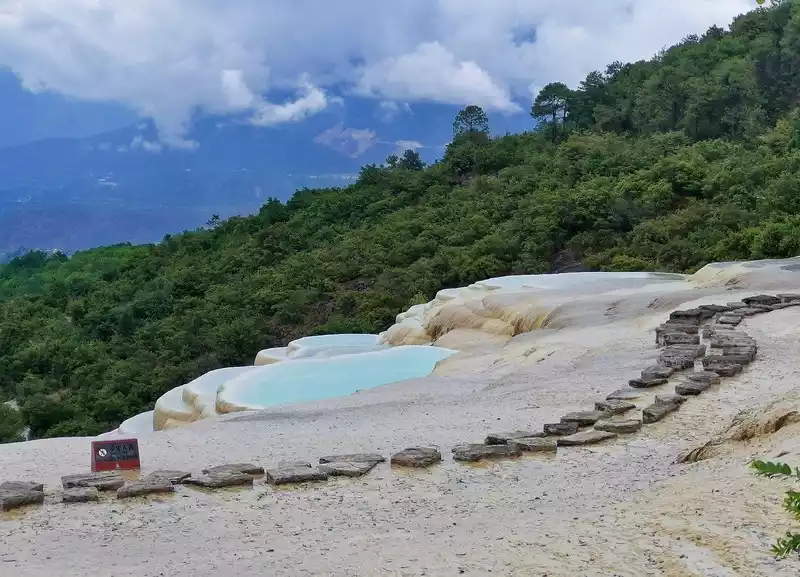
水台的水槽不是太深,槽底和边呈现出绒绒的感觉,但触上去也是硬硬的如同石头般的质感。
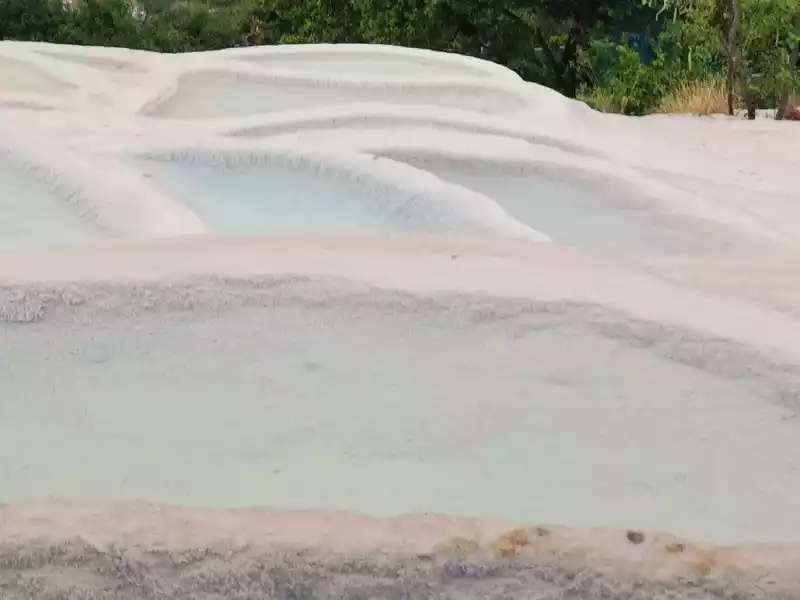
走在栈道上向水台的另一边望去,山脉仍旧烟雨朦胧,而一棵几乎枯了的老树昂首挺立的姿态很是感人。
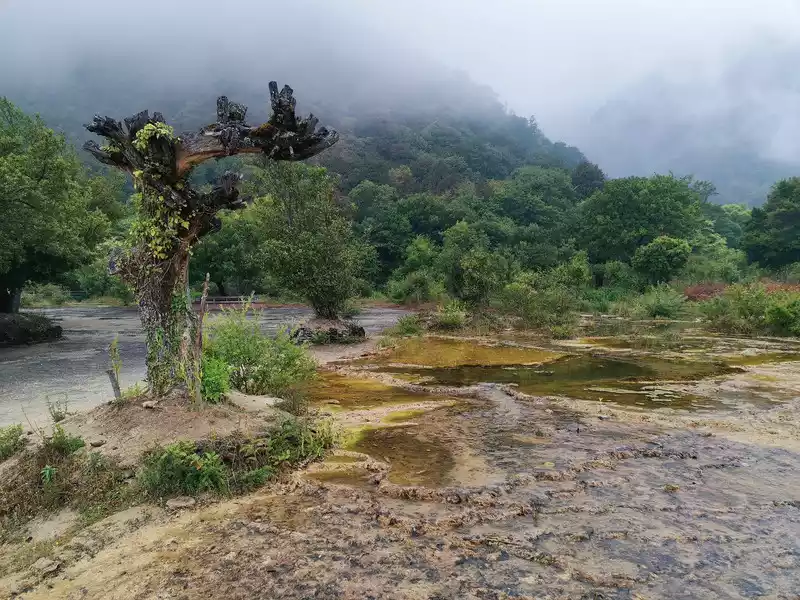
横穿过这片最大的水台后,便是两处背对背的小水台,可能因为光线不同,水台的呈现的状态有些大相径庭。
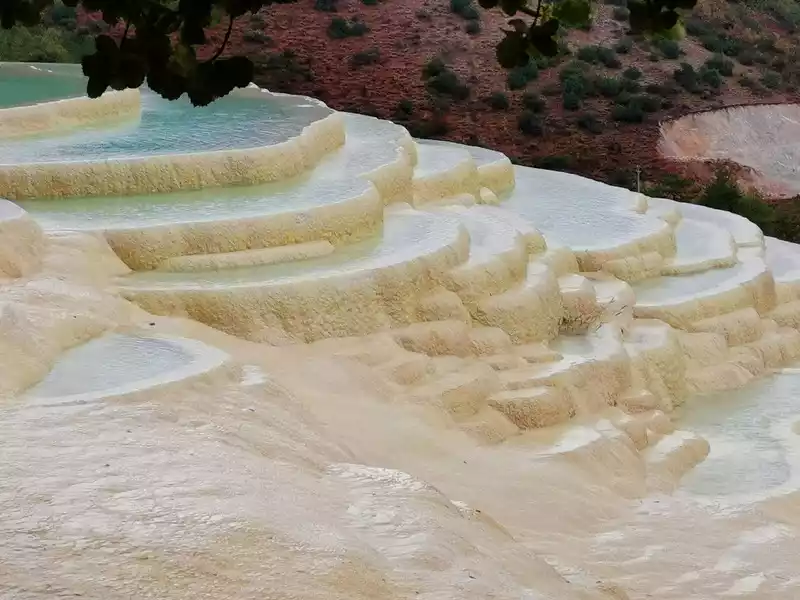
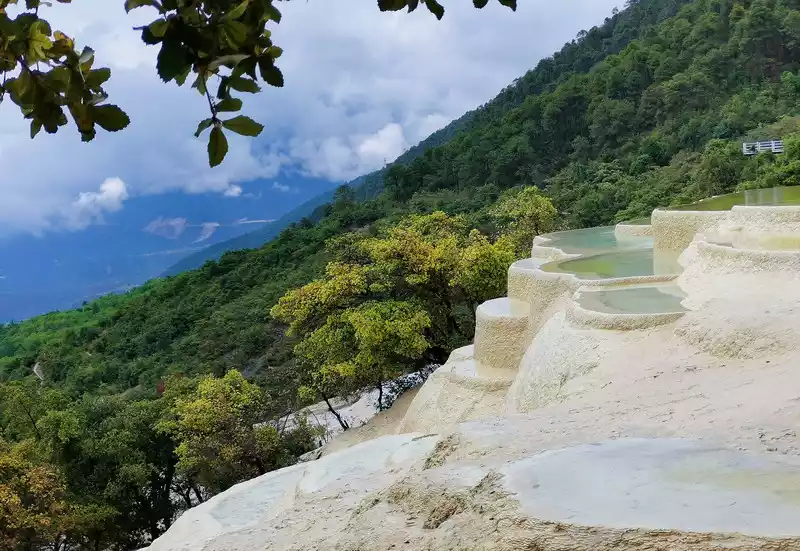
台礕的质感也仿佛也有些不一样。
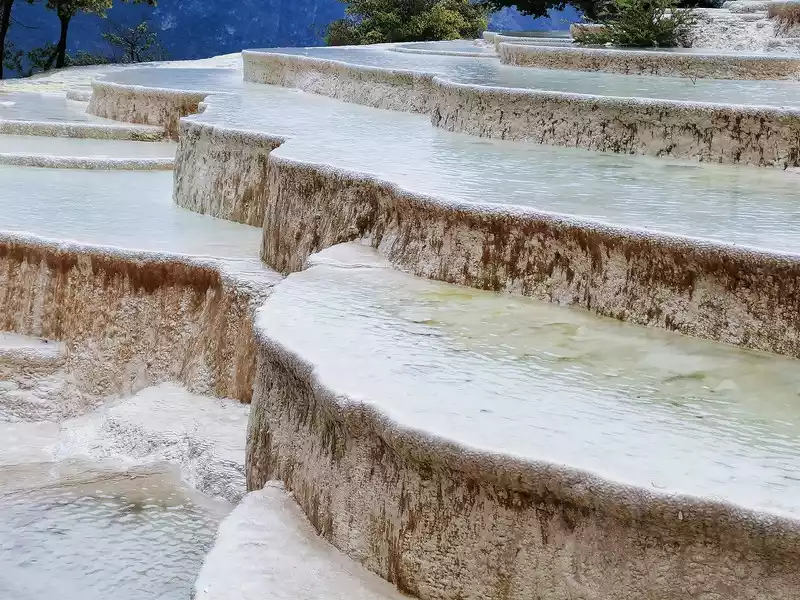
又是一个小水台,台礕则如同鱼鳞片。
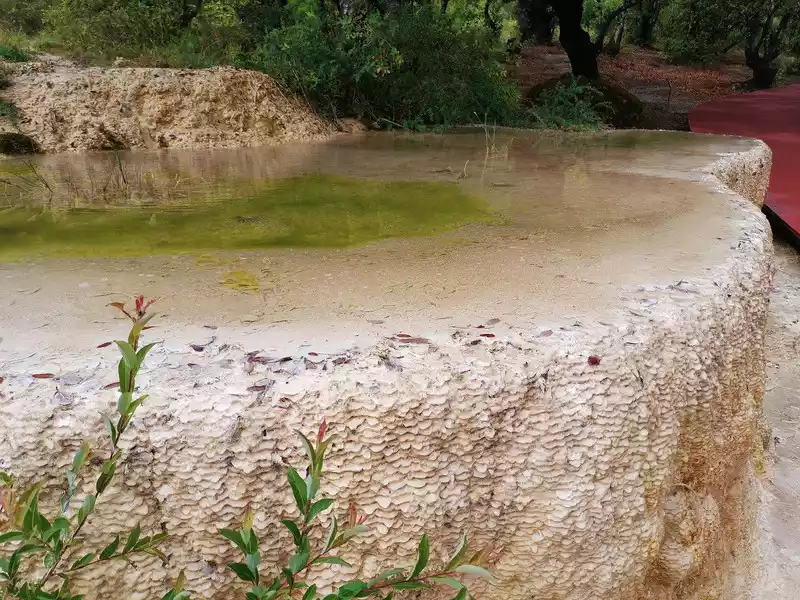
和我们上山时的栈道一样,此处也有一条上下景区的栈道和观景台。
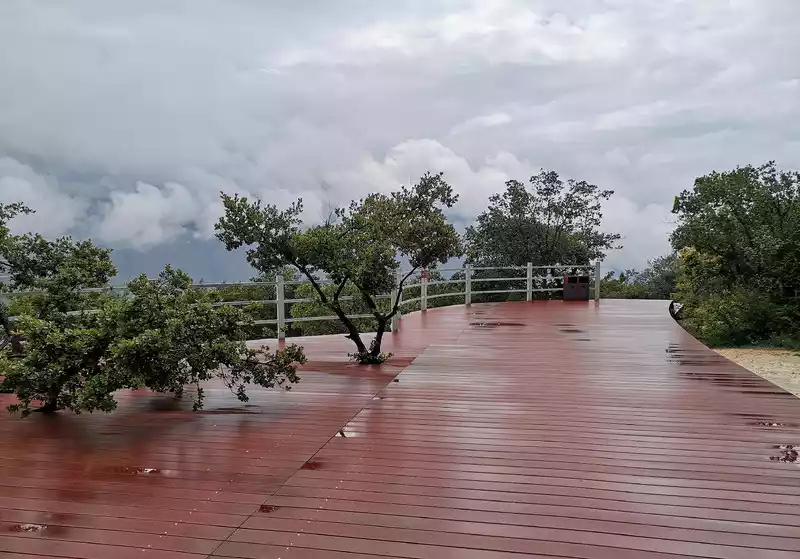
我们依旧回到这片小树林,越过一片夹杂在树林中的小水台,便接近了山脚边。
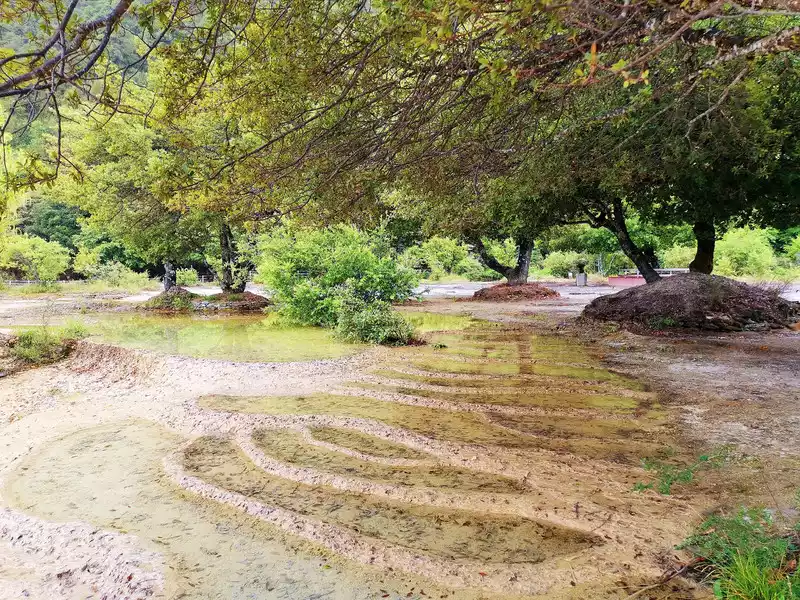
云雾衬托下的这株依然散发着生命气息的枯树多么的美妙动人。
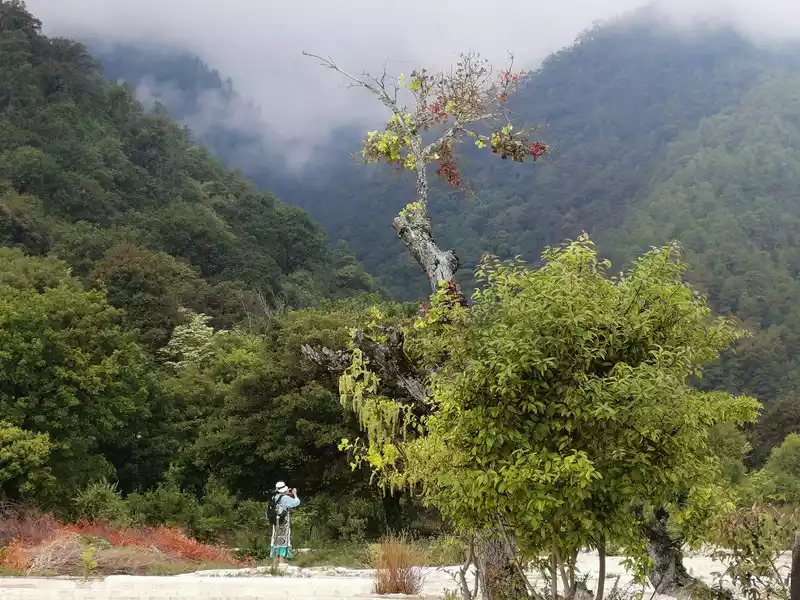
紧挨着山脚下的这片水台大而浅,水面则呈现着不同的色彩,淡蓝、玉白、鹅黄参差着,周边则围绕着红色、深绿、翠绿的树木,又是一种美妙无比的意境。
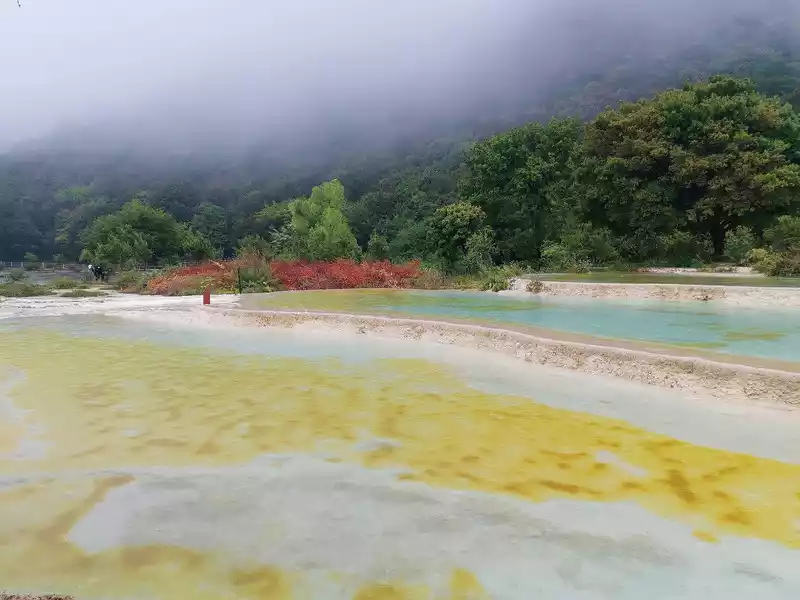
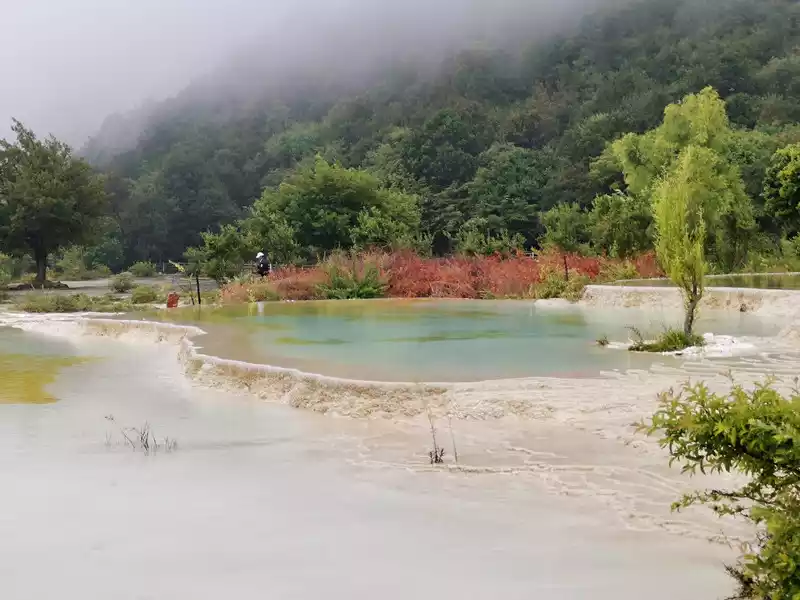
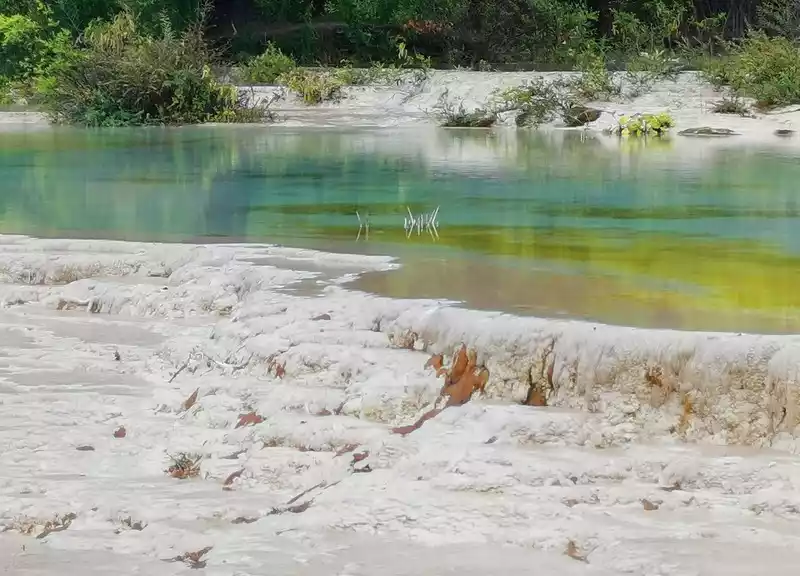
而由这片多彩的水台向仙人遗田方向看去,只见远处的山脉雾气已经散去,蓝蓝的天空飘浮着大片白云。
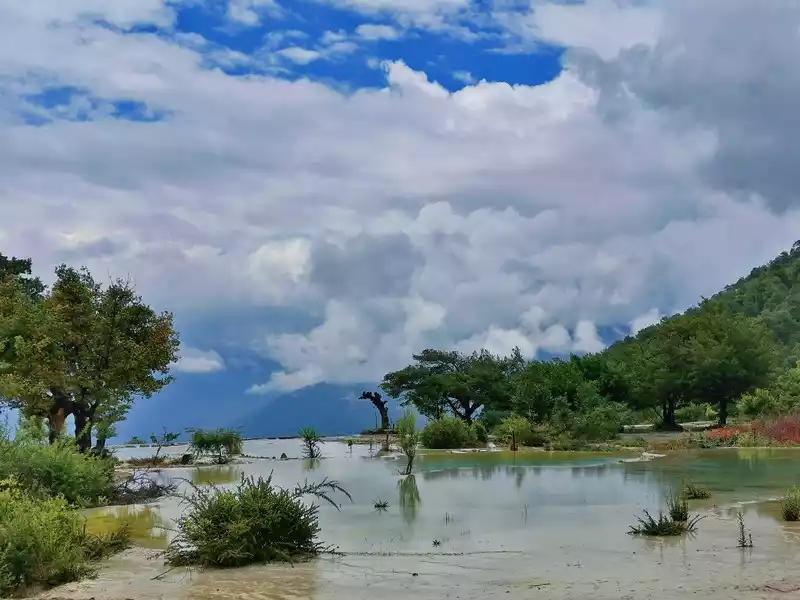
白水台后方靠近山脚边的休息区很是安宁的样子,一棵大树如同一把巨伞为休息的游人遮阳挡雨。
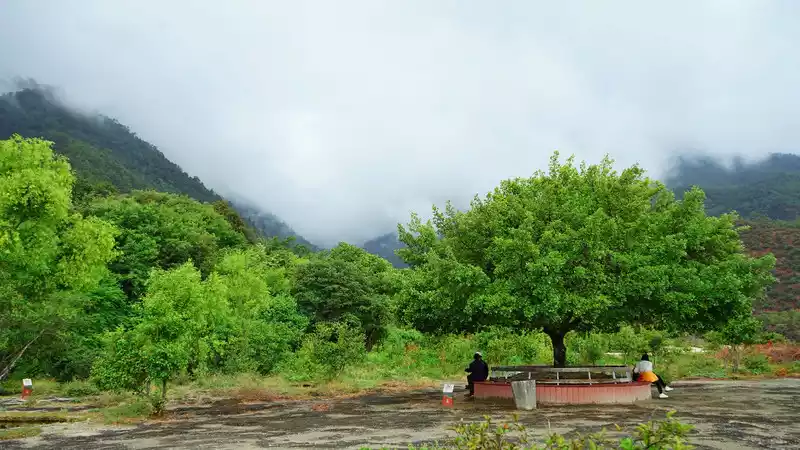
休息区的周围绿树成荫,绿水如碧。
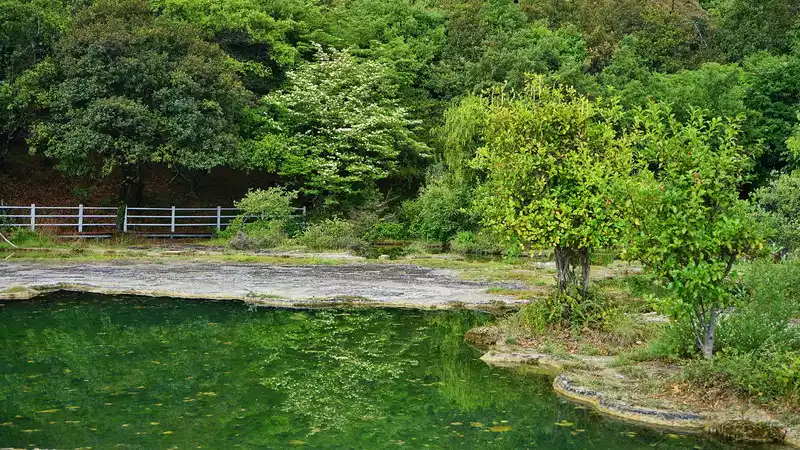
离开水台区,沿着上山时的栈道继续向上,大约几分钟后便来到“神泉”所在地。
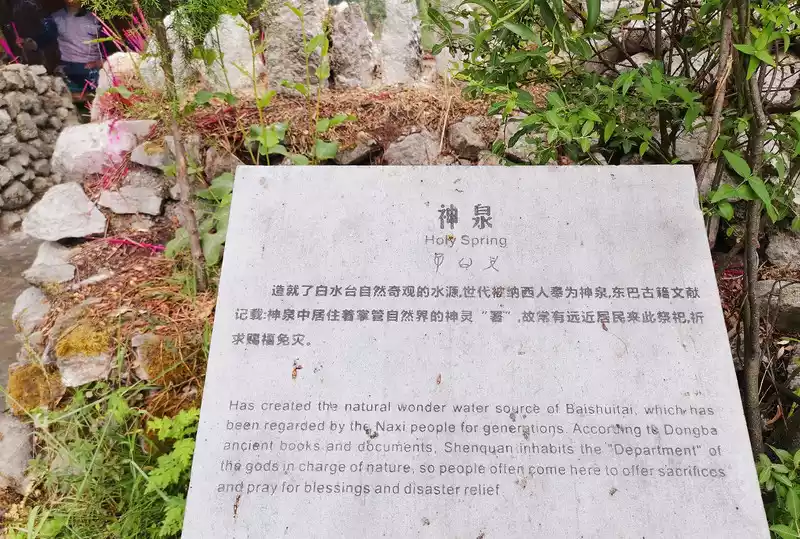
泉水面积不大,但看上去很深。泉水的周壁就是泥土、石块,但泉水色深却非常清洌,如同一棵宝石。
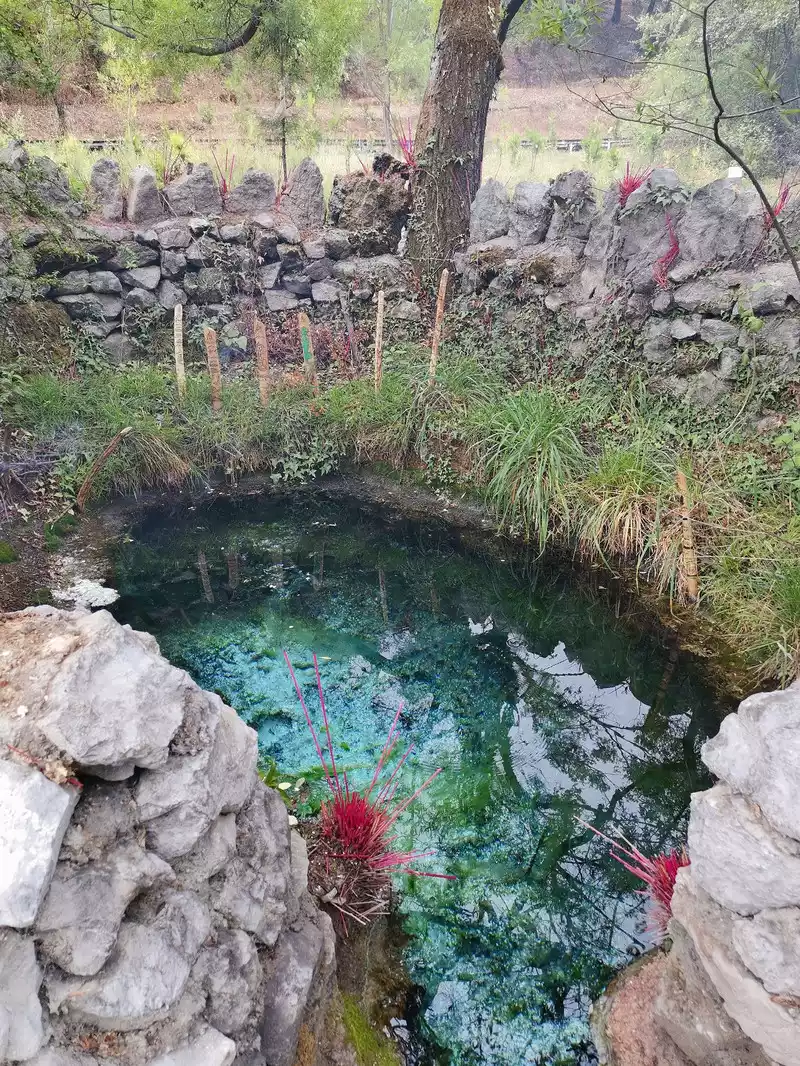
泉水有个开放性小棚子,每天都有当地的纳西族人在此看守、燃香。
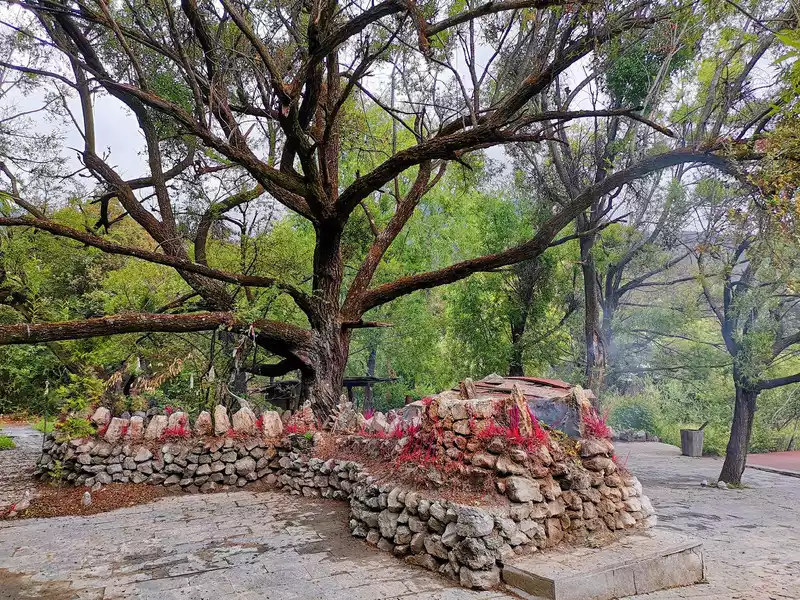
周围的风景也很美。
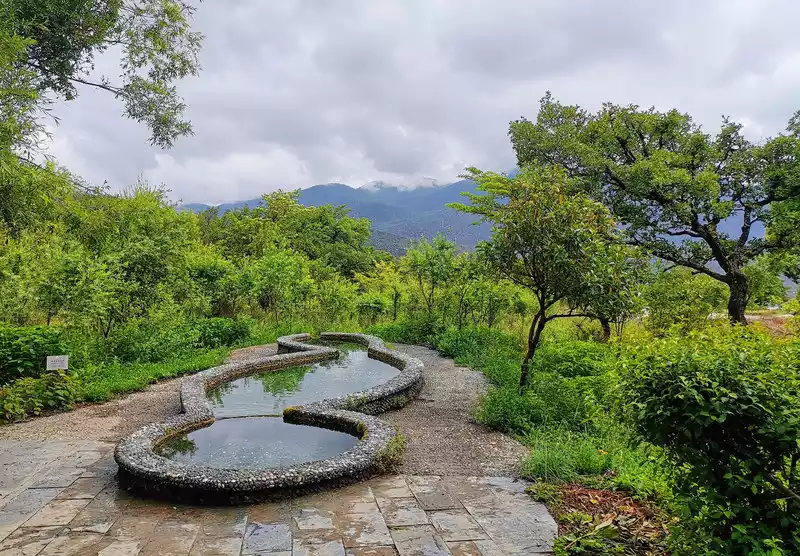
好美好艳丽的花朵啊!
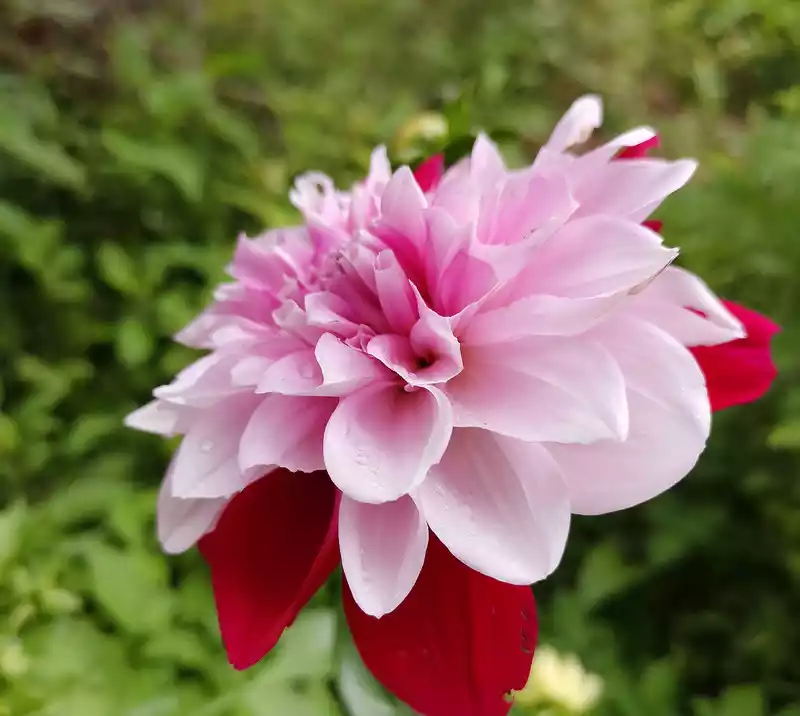
很多人到白水台只是在水台这一块转悠一遍便结束了,但是许多景点包括白水台都是需要静心慢慢体验,多角度观赏才能真正感受到大自然的美好。我们就是一上午的时间都耗在了白水台和它的周围,最终的感受便是,白水台------值得!
回到民宿吃了中餐,然后起程回丽江。
由白水台至虎跳峡的全程、几乎是全程的路,仍旧烂得天怒人怨!而且中间还断断续续的下起了雨,那路更是泥泞几倍,直到过了虎跳峡后路才好了起来,所以又是八十多公里的烂路用了五六个小时才终于抵达最后一个目的地——丽江古城。
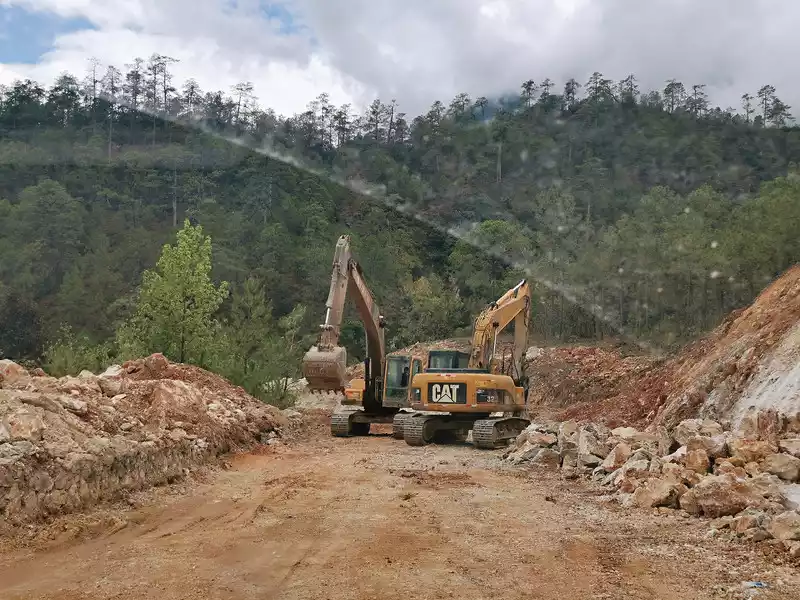
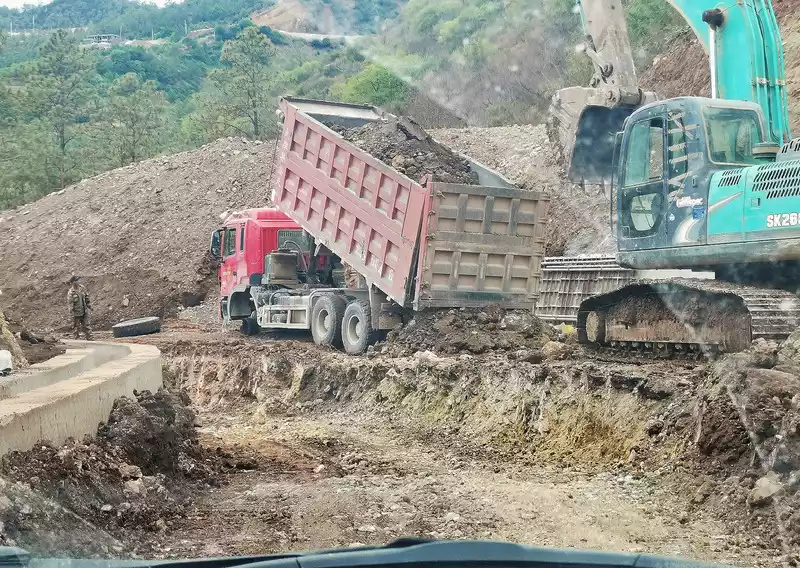
因为第二天全天都将在丽江大研古城溜达,为方便随时逛吃,我们提前预订了古城内中心位置的民宿,除了道路有些不方便,其他没毛病。
放下行李,稍事休息,我们便溜达到古城街区,此时已是华灯初上,但除了四方街及附近游人较多,其他街道人流稀少。

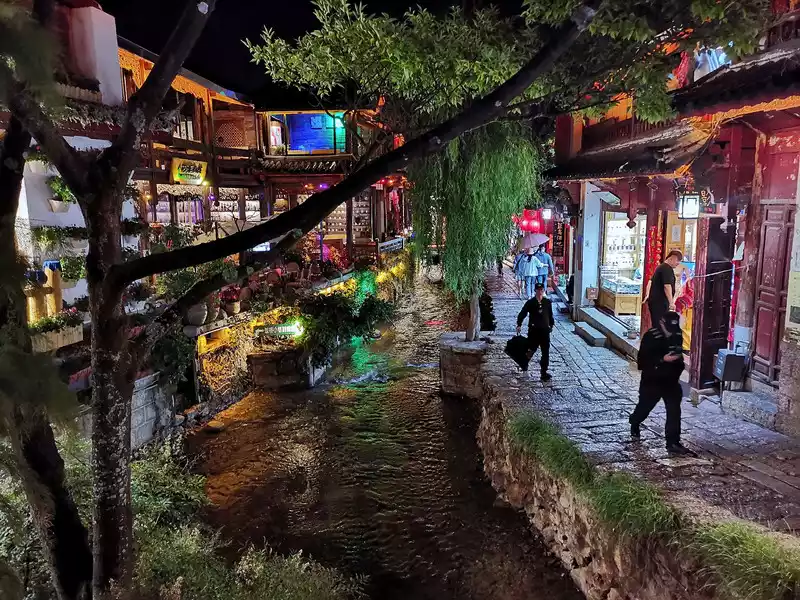
灯饰将街道特别是店铺外的花墙装扮的格外漂亮。
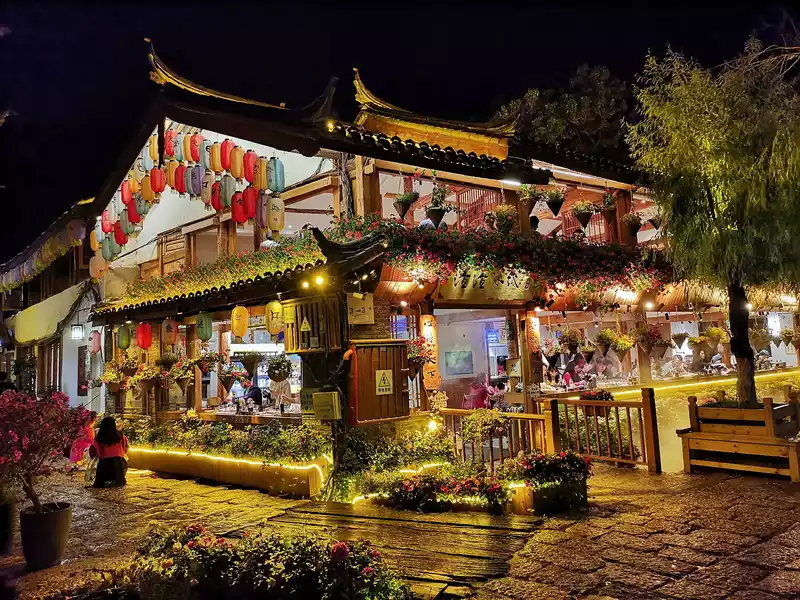
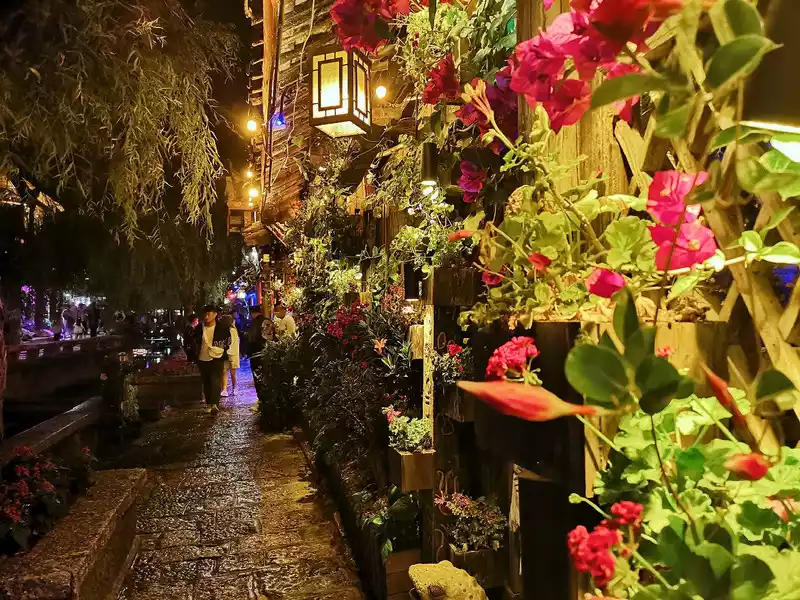
因为白天还是比较辛苦的,所以简单转了转,吃了点小吃,便返回了民宿休息,只待明日继续吃逛。
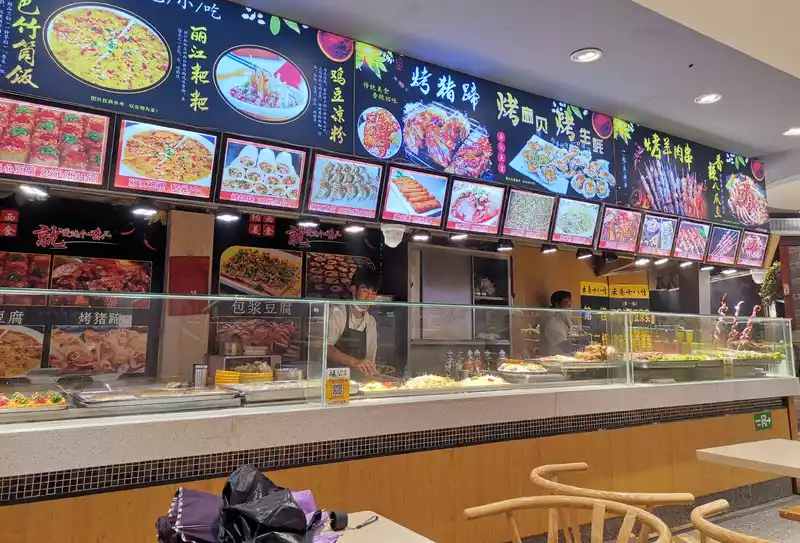
早起,又是一个好天气,阳光从民宿院子的上方洒下,映照着向阳的绿植发出剔透的光。
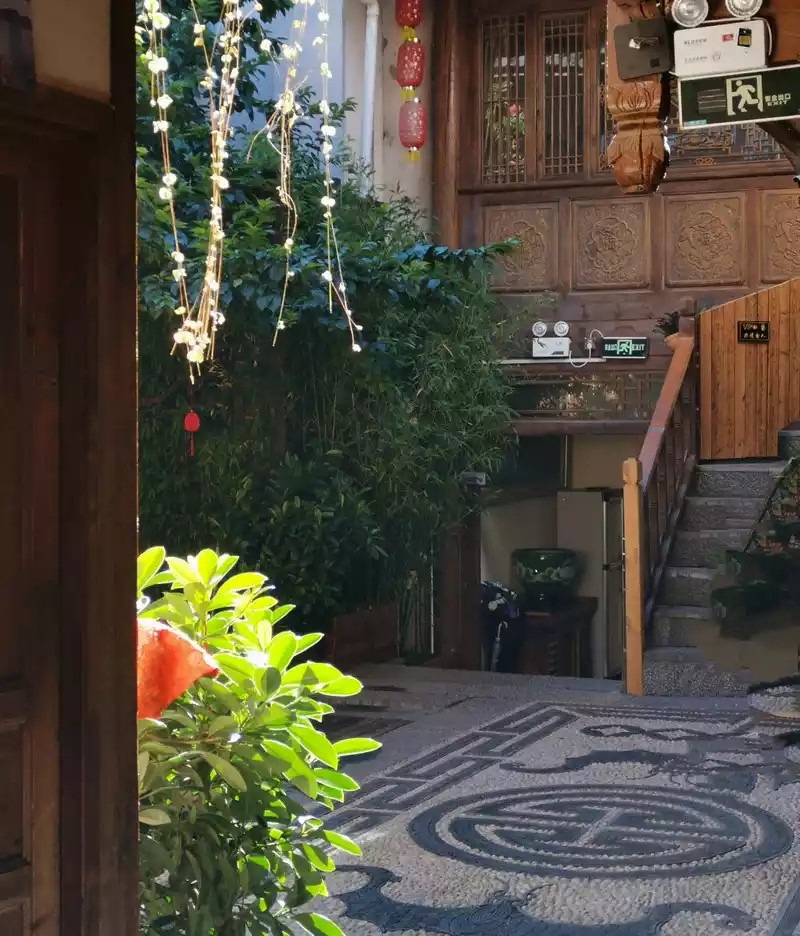
阳光从街道茂密的树木间隙中洒下,街边小道和花木呈现着诱人的斑驳瑰丽。
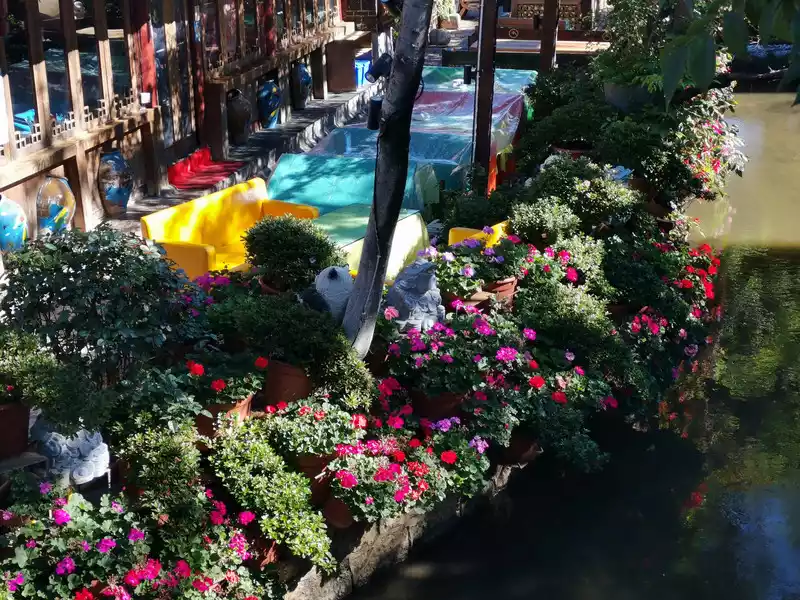
在四方街的米线店吃了早餐后,沿河的街道也已明亮了起来,见多不怪的花丛也更艳丽了几分。
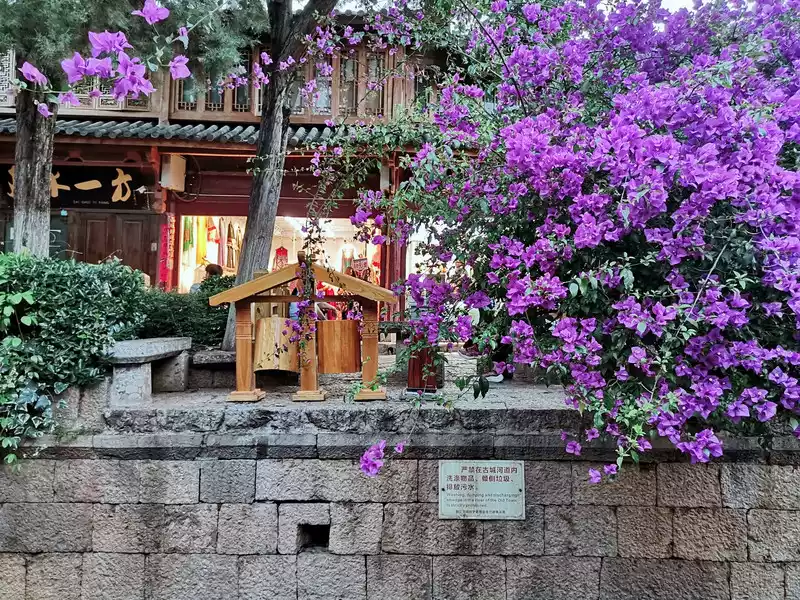
店铺橱窗里的银器在木制摆台的映衬下更显耀目。
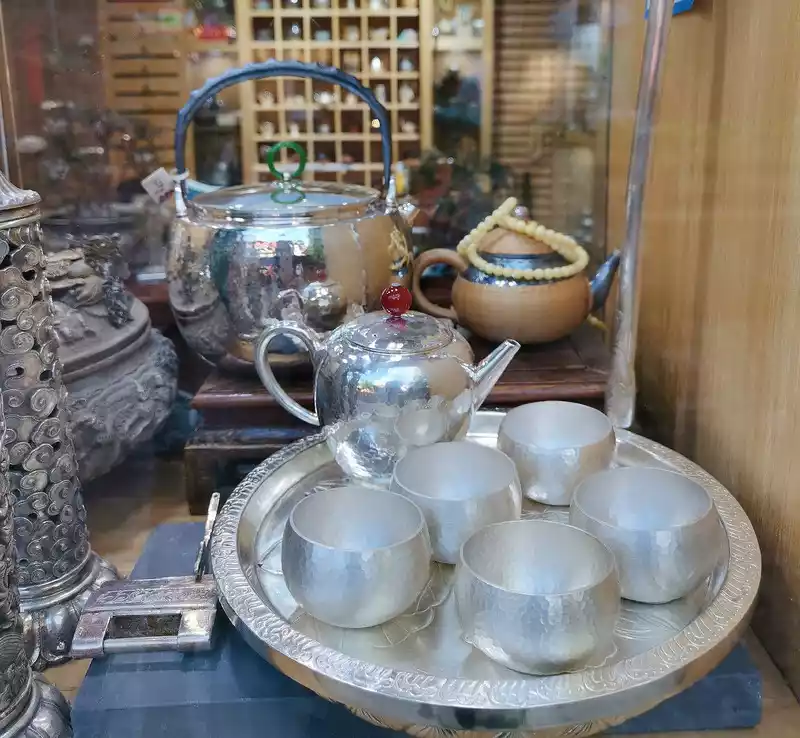
最近兴起的网红打卡地早早便有了旅拍的游人。
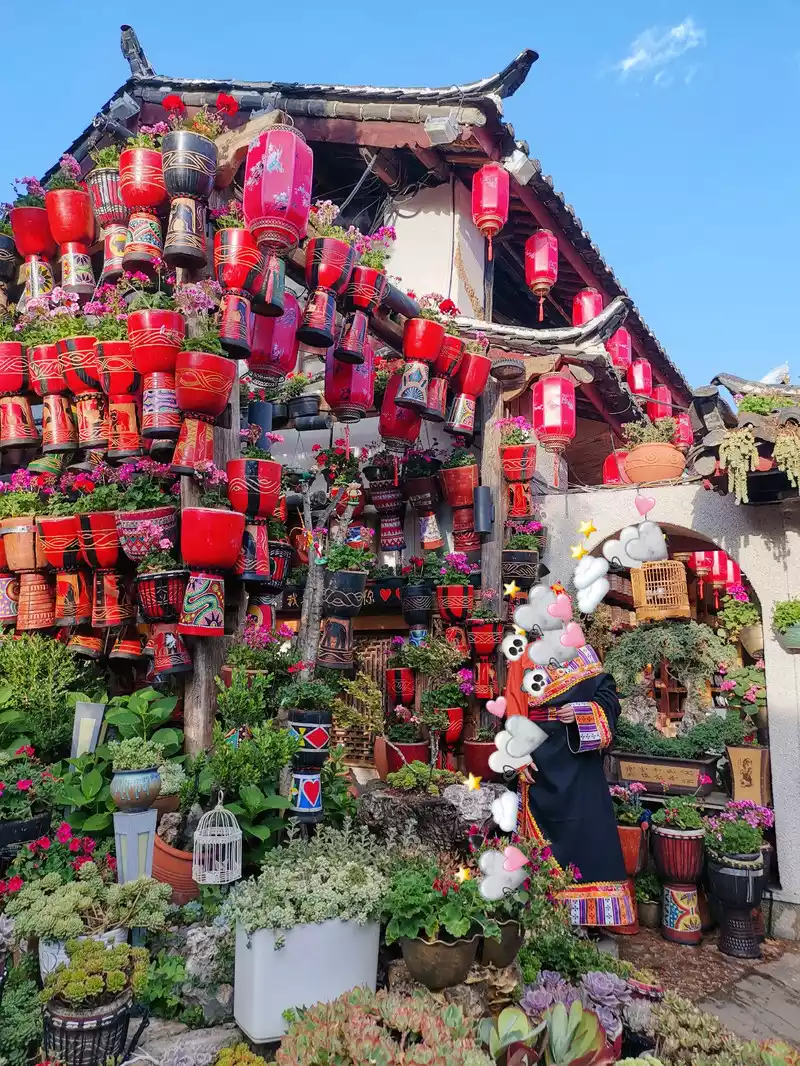
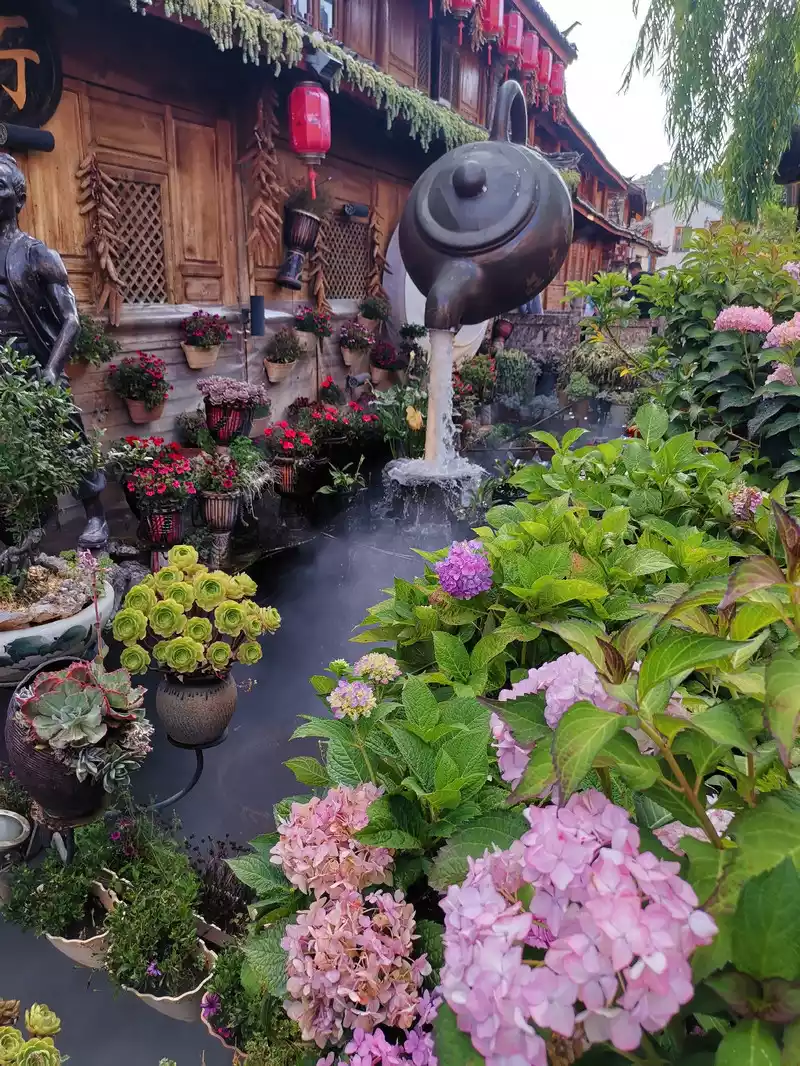
街道上游人渐渐多了起来。
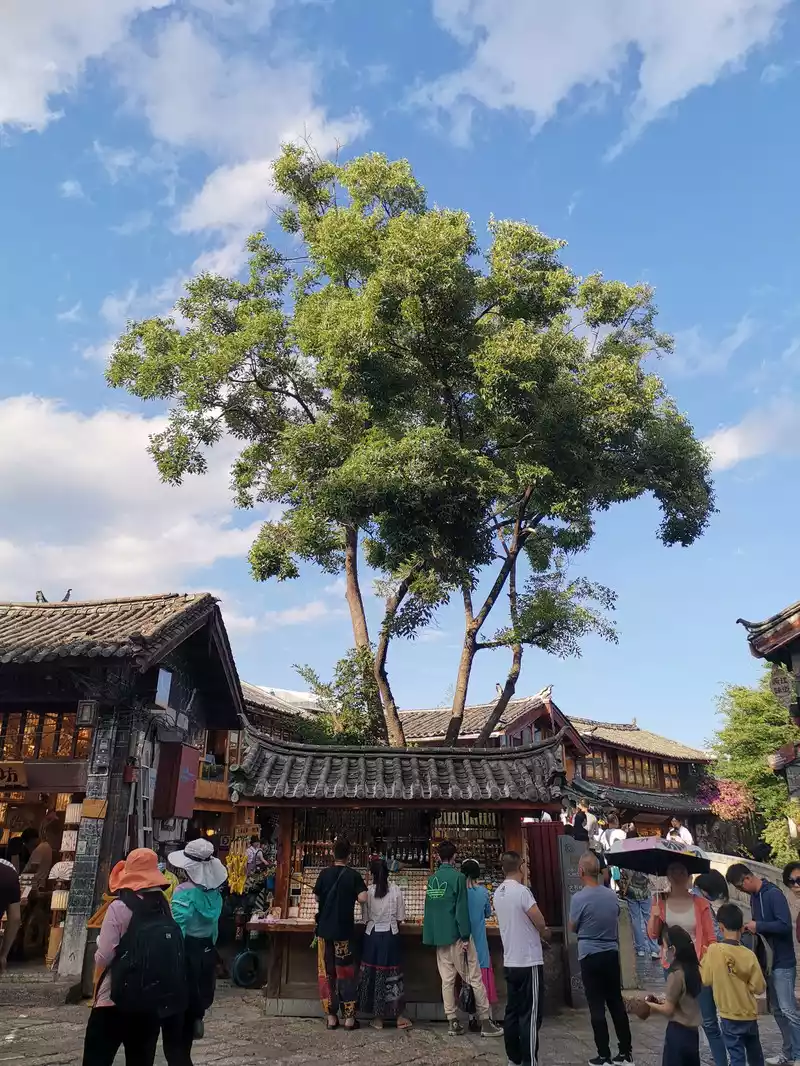
偏僻的街角还是人烟稀少。
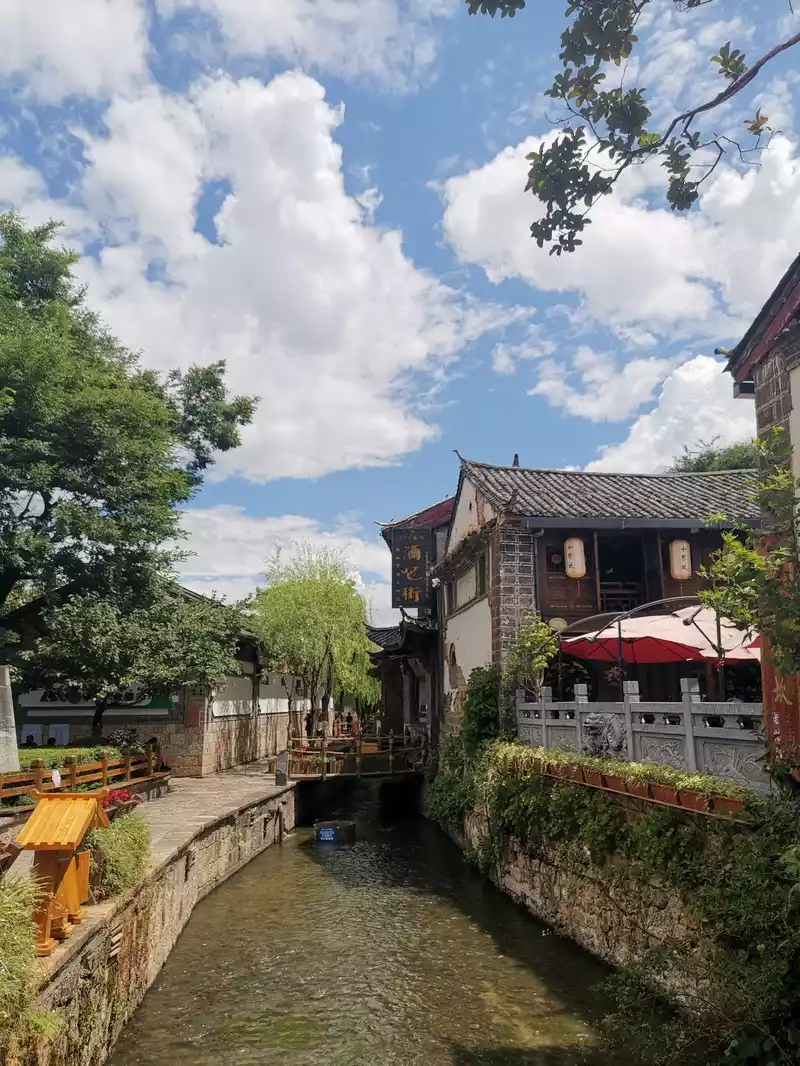
古城入口处的许愿挂铃长廊很是壮观。
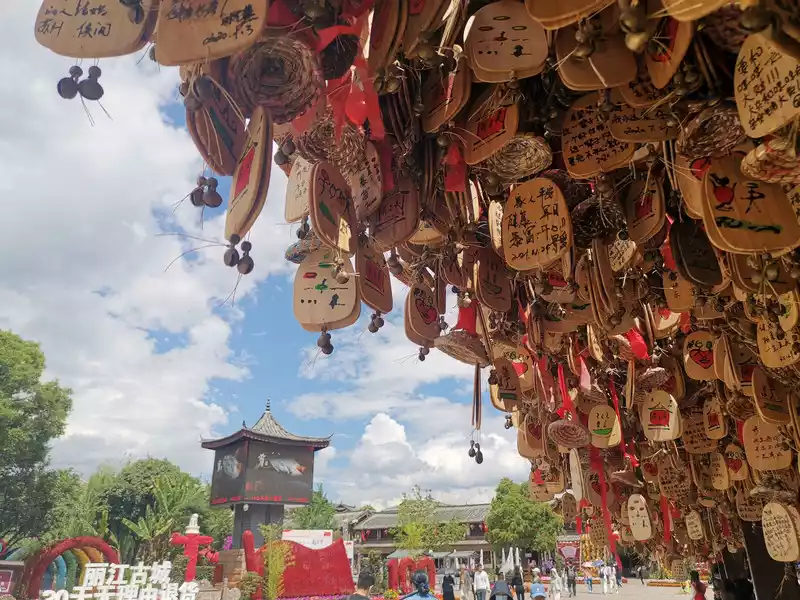
这里便是古城标志性的打卡地——子母水车。
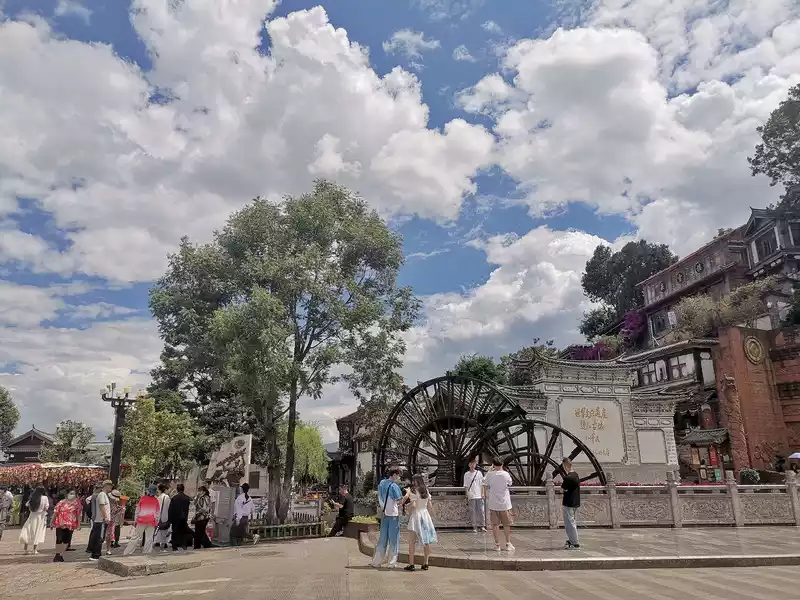
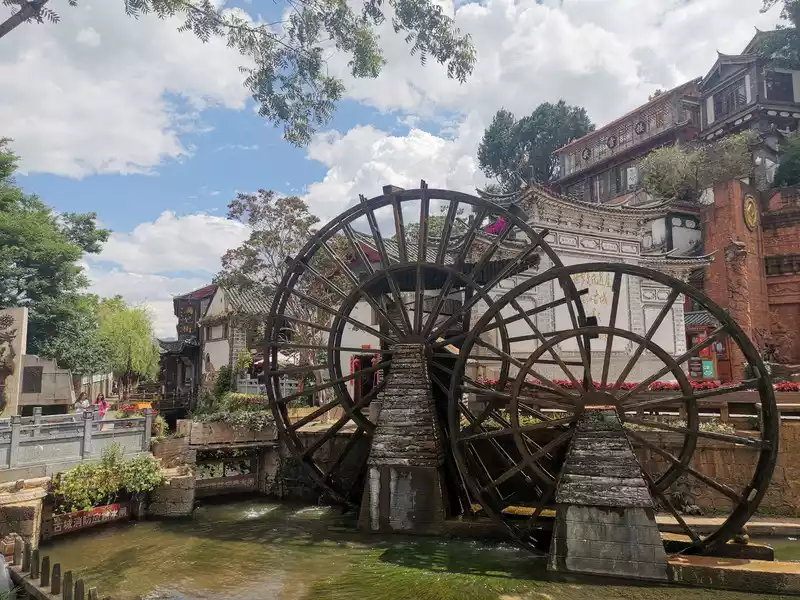
由子母水车对面的便道一直向前便是古城的一个进出口,出了古城一路向前,大约几分钟的功夫便可直达黑龙潭公园。
黑龙潭公园也叫玉泉公园,位于丽江古城北象山脚下,公园挺大,不需要门票。
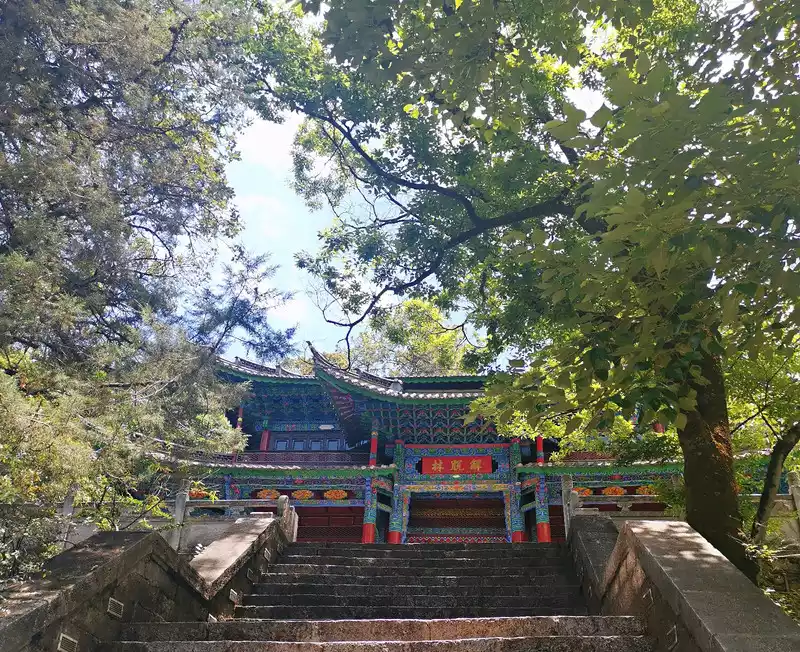
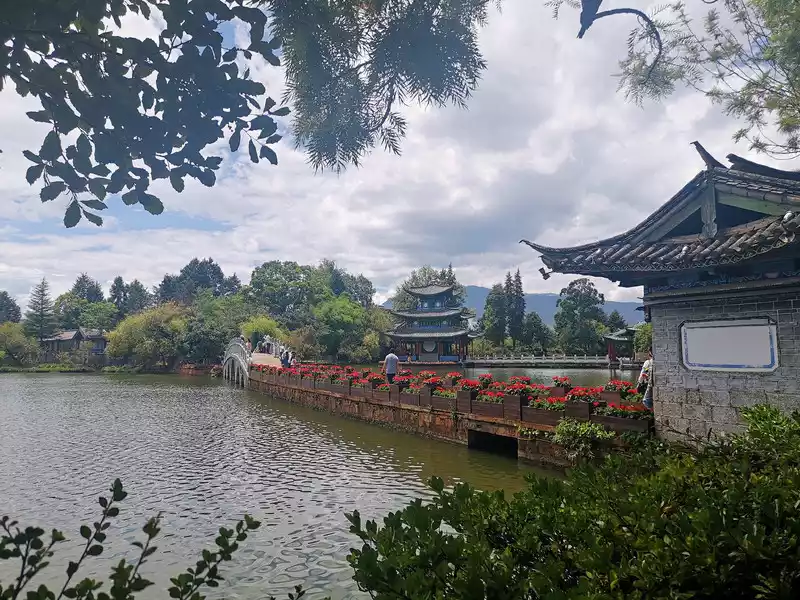
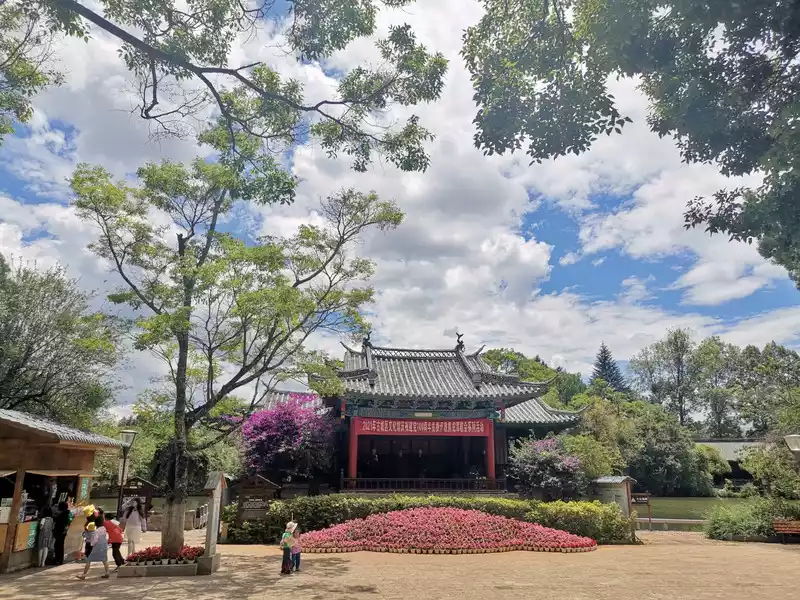
在黑龙潭公园简单转了转便回到古城,几个女人一台戏,今天这出戏自然离不开吃吃吃和逛街买衣,
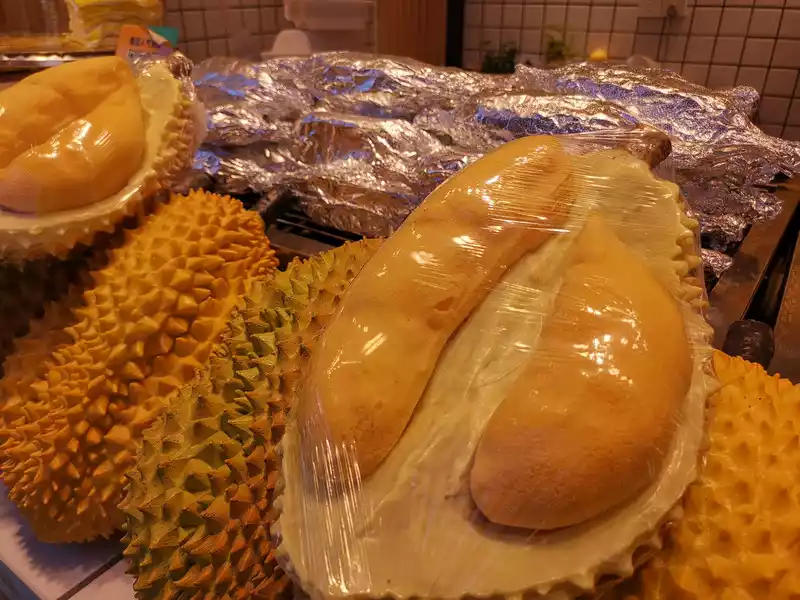
直到夜幕再次降临,街道满是灯红酒绿,花影迷离。
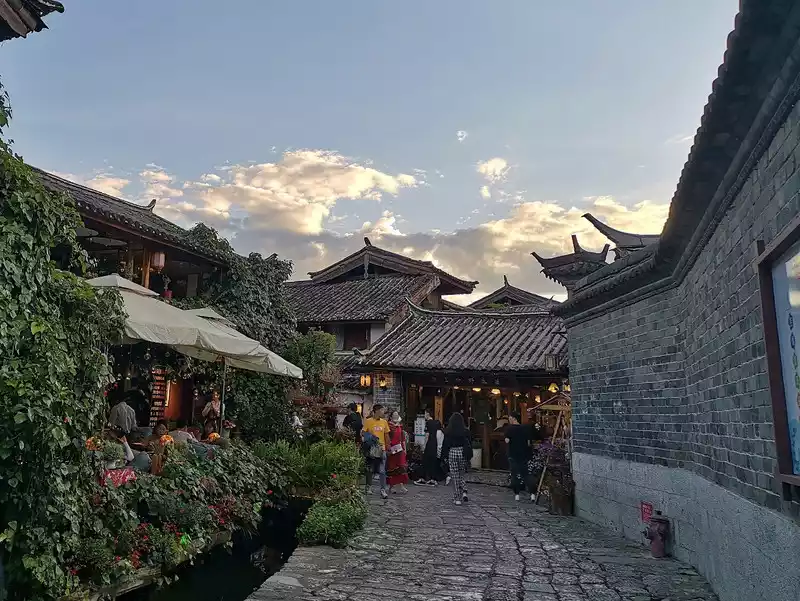
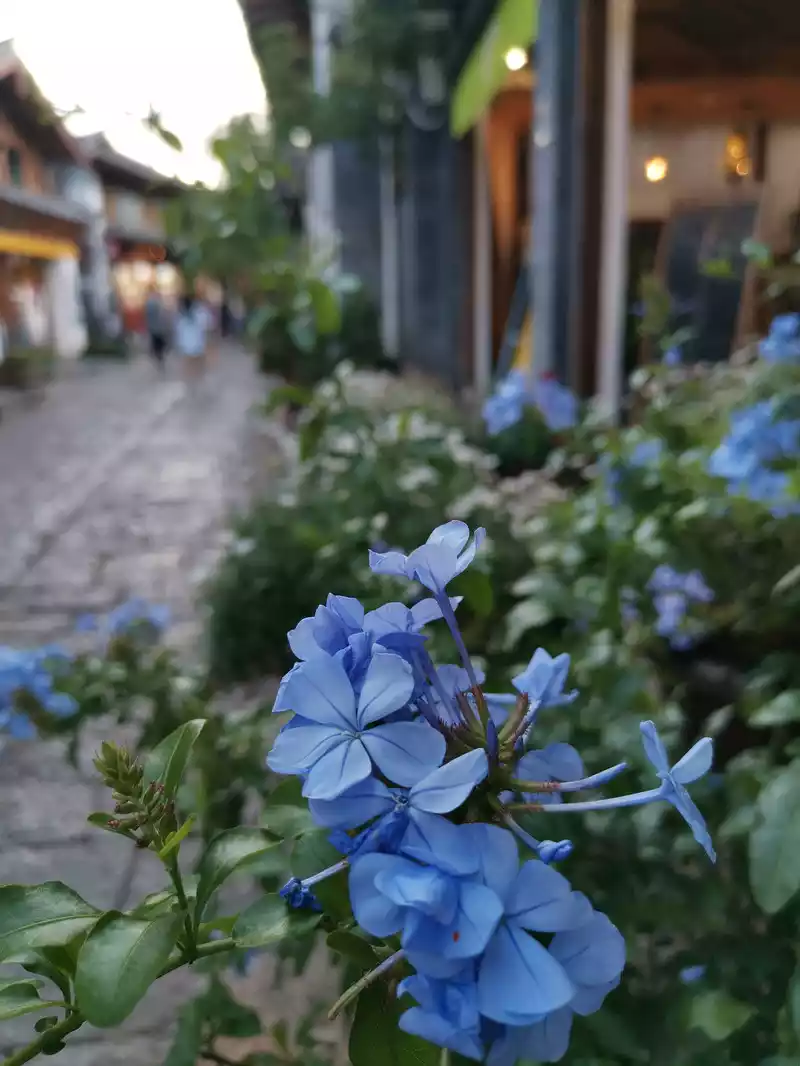
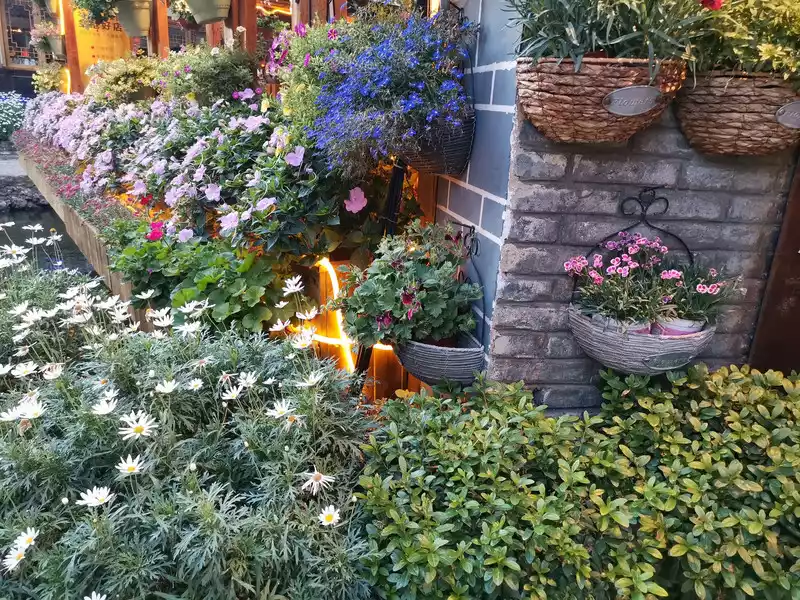
十一天很快呀,丽江香格里拉自由行就这么结束啦,行走的是乐趣,留下的是回忆,期待的是下一次旅行。
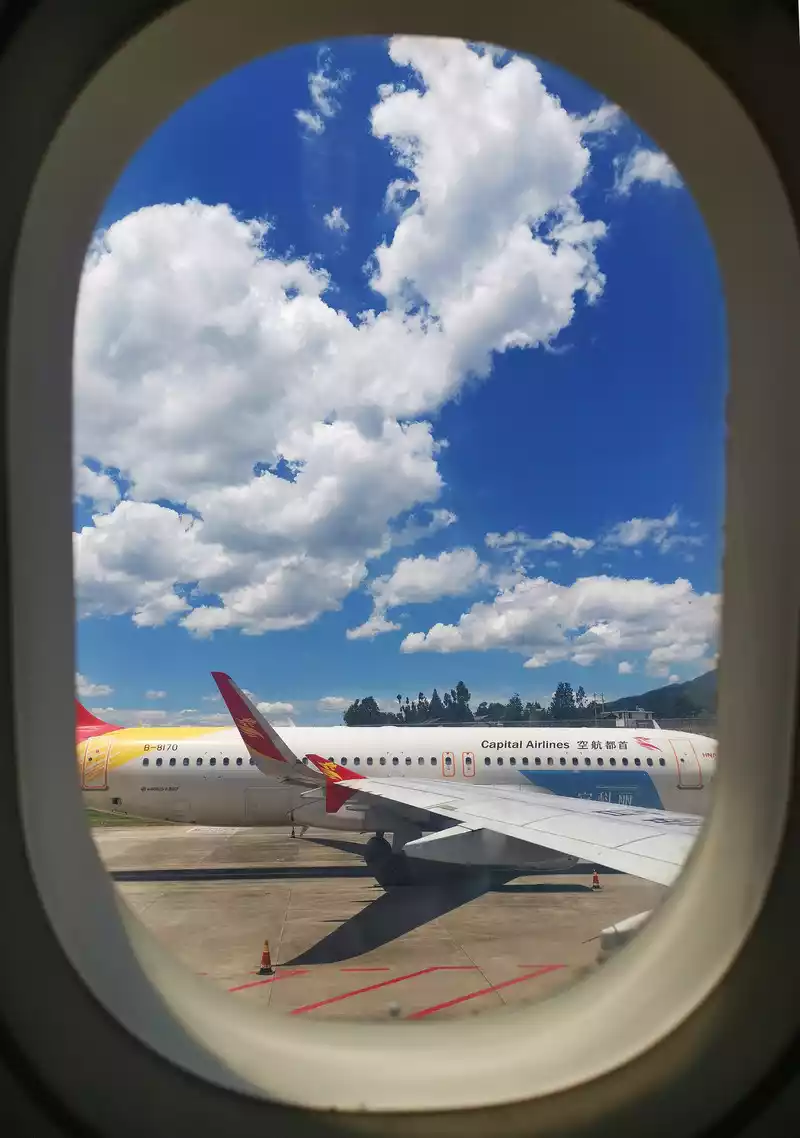
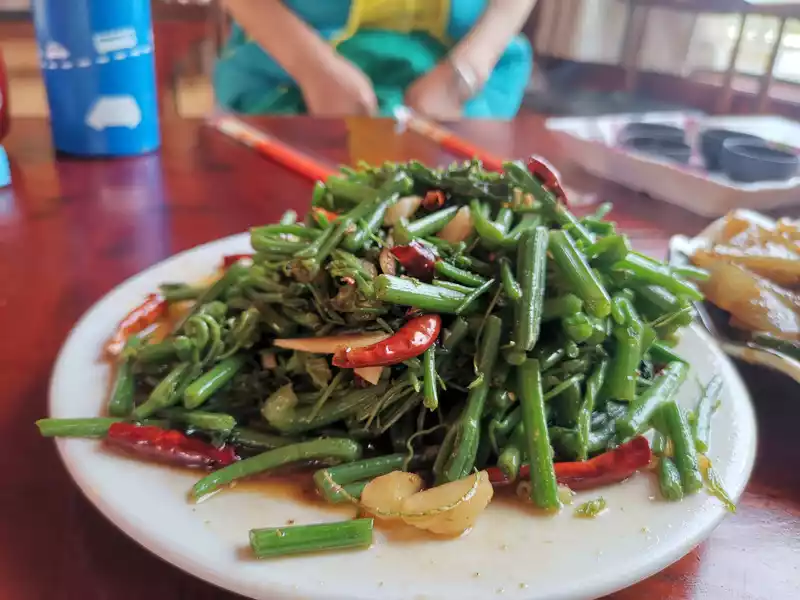
Number of days: 4 days, Average cost: 2500 yuan, Updated: 2021.05.29
Number of days:5 days, Average cost: 3500 yuan, Updated: 2021.09.30
Number of days: 4 days, Average cost: 6,000 yuan, Updated: 2021.08.09
Number of days: 10 days, Average cost: 7,000 yuan, Updated: 2023.09.09
Number of days:6 days, Average cost: 4800 yuan, Updated: 2024.03.09
Number of days:3 days, Average cost: 5800 yuan, Updated: 2023.01.30